

How to Write a Book Review: The Ultimate Guide
WHAT IS A BOOK REVIEW?

Traditionally, book reviews are evaluations of a recently published book in any genre. Usually, around the 500 to 700-word mark, they briefly describe a text’s main elements while appraising the work’s strengths and weaknesses. Published book reviews can appear in newspapers, magazines, and academic journals. They provide the reader with an overview of the book itself and indicate whether or not the reviewer would recommend the book to the reader.
WHAT IS THE PURPOSE OF A BOOK REVIEW?
There was a time when book reviews were a regular appearance in every quality newspaper and many periodicals. They were essential elements in whether or not a book would sell well. A review from a heavyweight critic could often be the deciding factor in whether a book became a bestseller or a damp squib. In the last few decades, however, the book review’s influence has waned considerably, with many potential book buyers preferring to consult customer reviews on Amazon, or sites like Goodreads, before buying. As a result, book review’s appearance in newspapers, journals, and digital media has become less frequent.
WHY BOTHER TEACHING STUDENTS TO WRITE BOOK REVIEWS AT ALL?
Even in the heyday of the book review’s influence, few students who learned the craft of writing a book review became literary critics! The real value of crafting a well-written book review for a student does not lie in their ability to impact book sales. Understanding how to produce a well-written book review helps students to:
● Engage critically with a text
● Critically evaluate a text
● Respond personally to a range of different writing genres
● Improve their own reading, writing, and thinking skills.
Not to Be Confused with a Book Report!
WHAT’S THE DIFFERENCE BETWEEN A BOOK REVIEW AND A BOOK REPORT?
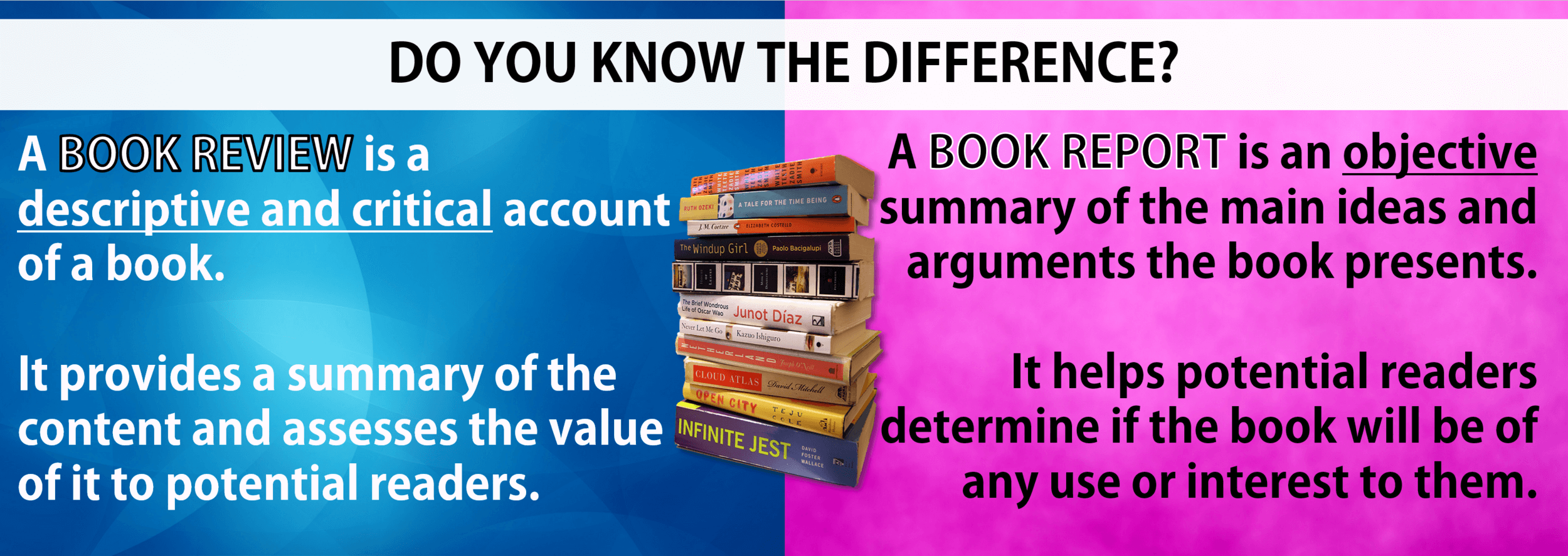
While the terms are often used interchangeably, there are clear differences in both the purpose and the format of the two genres. Generally speaking, book reports aim to give a more detailed outline of what occurs in a book. A book report on a work of fiction will tend to give a comprehensive account of the characters, major plot lines, and themes in the book. Book reports are usually written around the K-12 age range, while book reviews tend not to be undertaken by those at the younger end of this age range due to the need for the higher-level critical skills required in writing them. At their highest expression, book reviews are written at the college level and by professional critics.
Learn how to write a book review step by step with our complete guide for students and teachers by familiarizing yourself with the structure and features.
BOOK REVIEW STRUCTURE
ANALYZE Evaluate the book with a critical mind.
THOROUGHNESS The whole is greater than the sum of all its parts. Review the book as a WHOLE.
COMPARE Where appropriate compare to similar texts and genres.
THUMBS UP OR DOWN? You are going to have to inevitably recommend or reject this book to potential readers.
BE CONSISTENT Take a stance and stick with it throughout your review.
FEATURES OF A BOOK REVIEW
PAST TENSE You are writing about a book you have already read.
EMOTIVE LANGUAGE Whatever your stance or opinion be passionate about it. Your audience will thank you for it.
VOICE Both active and passive voice are used in recounts.
A COMPLETE UNIT ON REVIEW AND ANALYSIS OF TEXTS
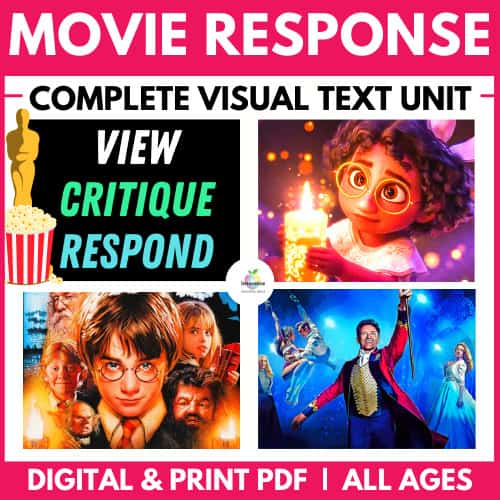
⭐ Make MOVIES A MEANINGFUL PART OF YOUR CURRICULUM with this engaging collection of tasks and tools your students will love. ⭐ All the hard work is done for you with NO PREPARATION REQUIRED.
This collection of 21 INDEPENDENT TASKS and GRAPHIC ORGANIZERS takes students beyond the hype, special effects and trailers to look at visual literacy from several perspectives offering DEEP LEARNING OPPORTUNITIES by watching a SERIES, DOCUMENTARY, FILM, and even VIDEO GAMES.
ELEMENTS OF A BOOK REVIEW
As with any of the writing genres we teach our students, a book review can be helpfully explained in terms of criteria. While there is much to the ‘art’ of writing, there is also, thankfully, a lot of the nuts and bolts that can be listed too. Have students consider the following elements before writing:
● Title: Often, the title of the book review will correspond to the title of the text itself, but there may also be some examination of the title’s relevance. How does it fit into the purpose of the work as a whole? Does it convey a message or reveal larger themes explored within the work?
● Author: Within the book review, there may be some discussion of who the author is and what they have written before, especially if it relates to the current work being reviewed. There may be some mention of the author’s style and what they are best known for. If the author has received any awards or prizes, this may also be mentioned within the body of the review.
● Genre: A book review will identify the genre that the book belongs to, whether fiction or nonfiction, poetry, romance, science-fiction, history etc. The genre will likely tie in, too with who the intended audience for the book is and what the overall purpose of the work is.
● Book Jacket / Cover: Often, a book’s cover will contain artwork that is worthy of comment. It may contain interesting details related to the text that contribute to, or detract from, the work as a whole.
● Structure: The book’s structure will often be heavily informed by its genre. Have students examine how the book is organized before writing their review. Does it contain a preface from a guest editor, for example? Is it written in sections or chapters? Does it have a table of contents, index, glossary etc.? While all these details may not make it into the review itself, looking at how the book is structured may reveal some interesting aspects.
● Publisher and Price: A book review will usually contain details of who publishes the book and its cost. A review will often provide details of where the book is available too.

BOOK REVIEW KEY ELEMENTS
As students read and engage with the work they will review, they will develop a sense of the shape their review will take. This will begin with the summary. Encourage students to take notes during the reading of the work that will help them in writing the summary that will form an essential part of their review. Aspects of the book they may wish to take notes on in a work of fiction may include:
● Characters: Who are the main characters? What are their motivations? Are they convincingly drawn? Or are they empathetic characters?
● Themes: What are the main themes of the work? Are there recurring motifs in the work? Is the exploration of the themes deep or surface only?
● Style: What are the key aspects of the writer’s style? How does it fit into the wider literary world?
● Plot: What is the story’s main catalyst? What happens in the rising action? What are the story’s subplots?
A book review will generally begin with a short summary of the work itself. However, it is important not to give too much away, remind students – no spoilers, please! For nonfiction works, this may be a summary of the main arguments of the work, again, without giving too much detail away. In a work of fiction, a book review will often summarise up to the rising action of the piece without going beyond to reveal too much!
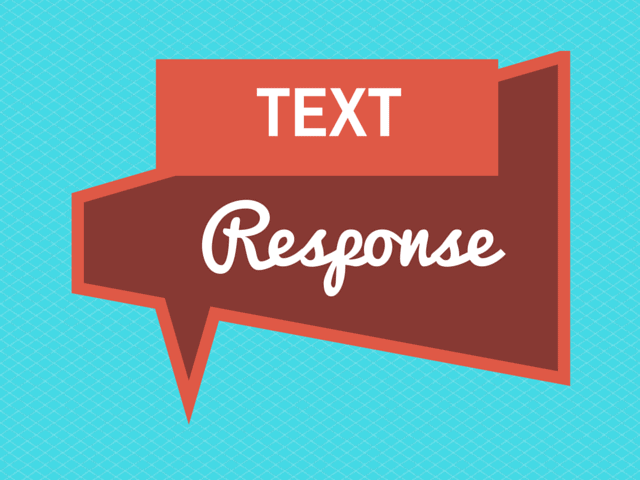
The summary should also provide some orientation for the reader. Given the nature of the purpose of a review, it is important that students’ consider their intended audience in the writing of their review. Readers will most likely not have read the book in question and will require some orientation. This is often achieved through introductions to the main characters, themes, primary arguments etc. This will help the reader to gauge whether or not the book is of interest to them.
Once your student has summarized the work, it is time to ‘review’ in earnest. At this point, the student should begin to detail their own opinion of the book. To do this well they should:
i. Make It Personal
Often when teaching essay writing we will talk to our students about the importance of climbing up and down the ladder of abstraction. Just as it is helpful to explore large, more abstract concepts in an essay by bringing it down to Earth, in a book review, it is important that students can relate the characters, themes, ideas etc to their own lives.
Book reviews are meant to be subjective. They are opinion pieces, and opinions grow out of our experiences of life. Encourage students to link the work they are writing about to their own personal life within the body of the review. By making this personal connection to the work, students contextualize their opinions for the readers and help them to understand whether the book will be of interest to them or not in the process.
ii. Make It Universal
Just as it is important to climb down the ladder of abstraction to show how the work relates to individual life, it is important to climb upwards on the ladder too. Students should endeavor to show how the ideas explored in the book relate to the wider world. The may be in the form of the universality of the underlying themes in a work of fiction or, for example, the international implications for arguments expressed in a work of nonfiction.
iii. Support Opinions with Evidence
A book review is a subjective piece of writing by its very nature. However, just because it is subjective does not mean that opinions do not need to be justified. Make sure students understand how to back up their opinions with various forms of evidence, for example, quotations, statistics, and the use of primary and secondary sources.
EDIT AND REVISE YOUR BOOK REVIEW
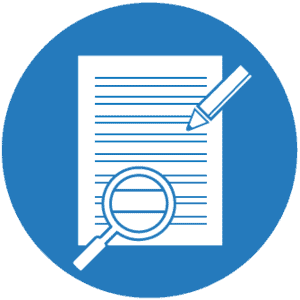
As with any writing genre, encourage students to polish things up with review and revision at the end. Encourage them to proofread and check for accurate spelling throughout, with particular attention to the author’s name, character names, publisher etc.
It is good practice too for students to double-check their use of evidence. Are statements supported? Are the statistics used correctly? Are the quotations from the text accurate? Mistakes such as these uncorrected can do great damage to the value of a book review as they can undermine the reader’s confidence in the writer’s judgement.
The discipline of writing book reviews offers students opportunities to develop their writing skills and exercise their critical faculties. Book reviews can be valuable standalone activities or serve as a part of a series of activities engaging with a central text. They can also serve as an effective springboard into later discussion work based on the ideas and issues explored in a particular book. Though the book review does not hold the sway it once did in the mind’s of the reading public, it still serves as an effective teaching tool in our classrooms today.

Teaching Resources
Use our resources and tools to improve your student’s writing skills through proven teaching strategies.
BOOK REVIEW GRAPHIC ORGANIZER (TEMPLATE)

101 DIGITAL & PRINT GRAPHIC ORGANIZERS FOR ALL CURRICULUM AREAS
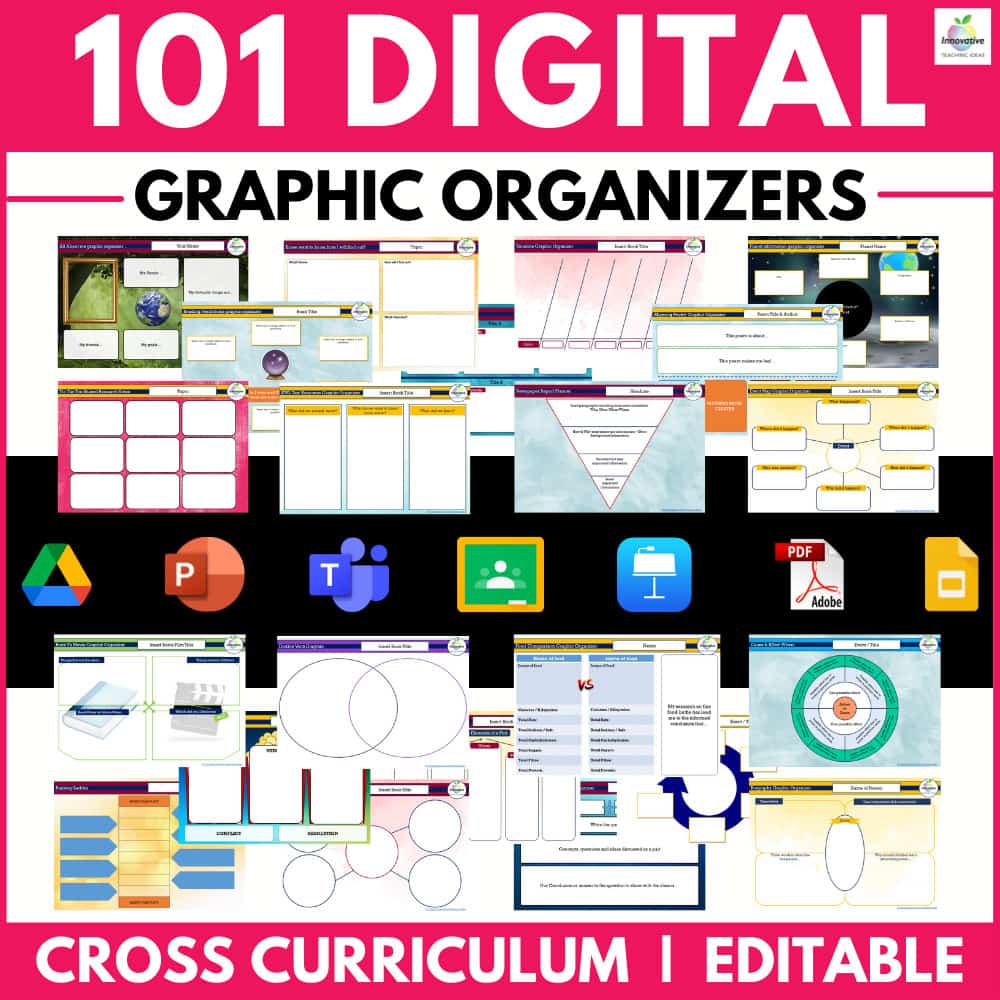
Introduce your students to 21st-century learning with this GROWING BUNDLE OF 101 EDITABLE & PRINTABLE GRAPHIC ORGANIZERS. ✌ NO PREP REQUIRED!!! ✌ Go paperless, and let your students express their knowledge and creativity through the power of technology and collaboration inside and outside the classroom with ease.
Whilst you don’t have to have a 1:1 or BYOD classroom to benefit from this bundle, it has been purpose-built to deliver through platforms such as ✔ GOOGLE CLASSROOM, ✔ OFFICE 365, ✔ or any CLOUD-BASED LEARNING PLATFORM.
Book and Movie review writing examples (Student Writing Samples)
Below are a collection of student writing samples of book reviews. Click on the image to enlarge and explore them in greater detail. Please take a moment to both read the movie or book review in detail but also the teacher and student guides which highlight some of the key elements of writing a text review
Please understand these student writing samples are not intended to be perfect examples for each age or grade level but a piece of writing for students and teachers to explore together to critically analyze to improve student writing skills and deepen their understanding of book review writing.
We would recommend reading the example either a year above and below, as well as the grade you are currently working with to gain a broader appreciation of this text type .

BOOK REVIEW VIDEO TUTORIALS
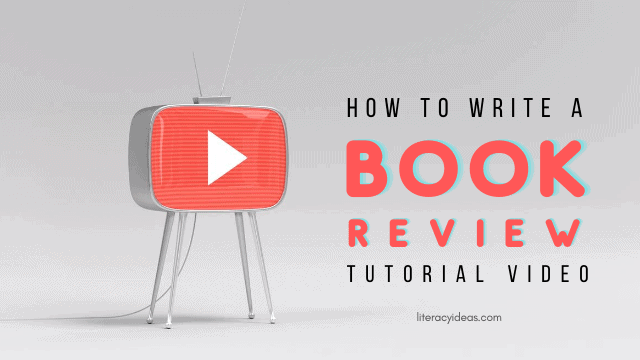
OTHER GREAT ARTICLES RELATED TO BOOK REVIEWS
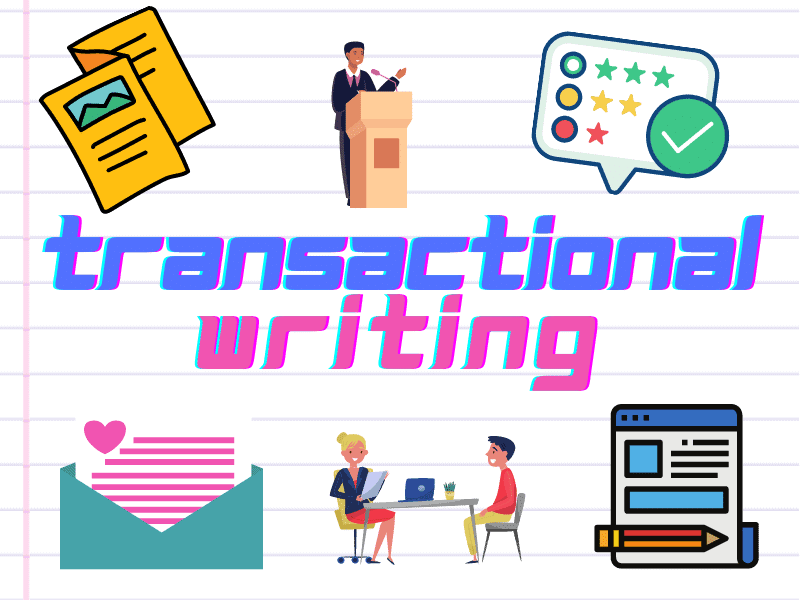
Transactional Writing
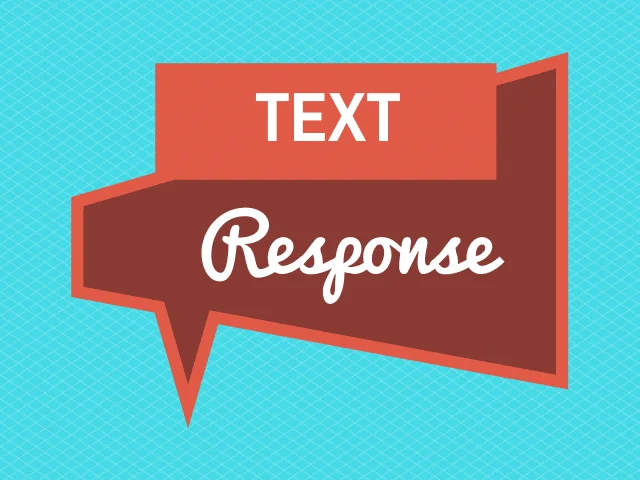
How to write a text response
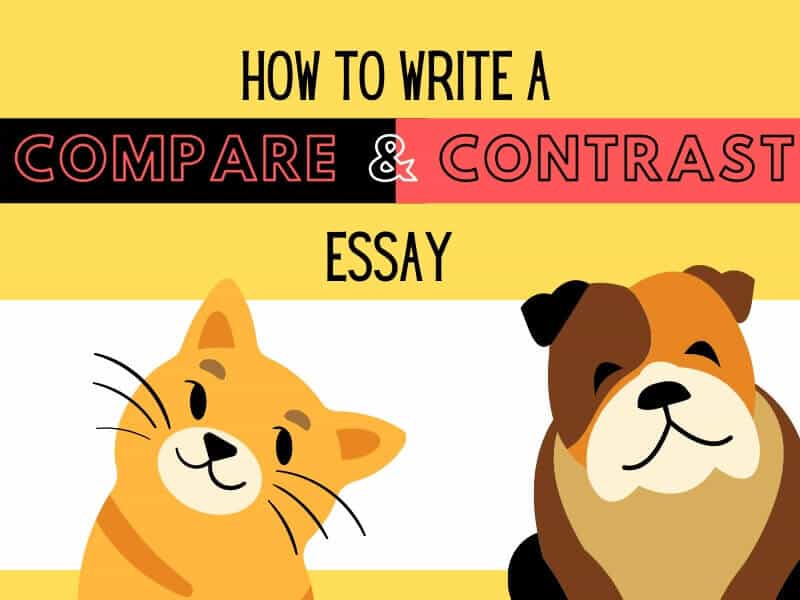
How to Write a Compare and Contrast Essay
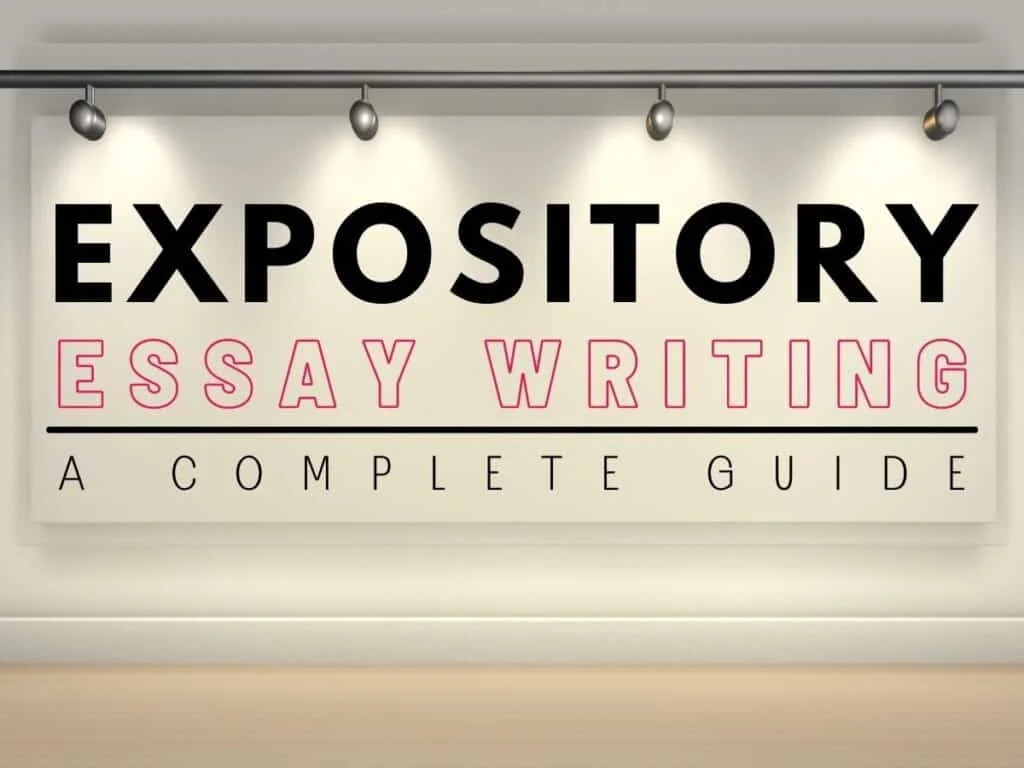
How to Write Excellent Expository Essays
Book Review
Book Review Examples
Last updated on: Nov 20, 2023
Good Book Review Examples to Help you Write a Great Review
By: Nova A.
Reviewed By: Chris H.
Published on: Mar 30, 2021

A book review is a common assignment that allows the students to demonstrate the author’s intentions in the book. It also provides them with the chance not only to criticize but also to give constructive criticism on how they can make improvements.
The purpose of writing a book review is to come up with your opinion about the author’s ideas presented in the book. On the other hand, a book analysis is completely based on opinions that are relevant to the book.
Writing a review is something that can be done with any book that you read. However, some genres are harder to write. But with a proper plan, you can easily write a great review on any book.
Read some short book review examples in this guide. They will help you understand the key elements of writing a great review in no time.

On this Page
Academic Book Review Examples
If you are assigned to write a book review, referring to some examples will be of great help. In addition, reading examples before starting the writing process will help you understand what elements are needed for a great book review. There are also many review sites online you can get help from.
Academic book reviews follow a fairly simple structure. It usually includes an introduction, middle paragraphs, and a conclusion that sums up all the ideas.
For a great book review, here are the things you need to focus on during the writing process.
- The main argument presented by the author
- Author’s methodologyAppropriateness for the audience
- Relationship to the real world
Have a look at the following book review examples for kids before beginning the writing process.
Book Review Examples for Middle School Students
Book Review Example For Kids
Book Review Examples for High School Students

Paper Due? Why Suffer? That's our Job!
Book Review Examples for College Students
Book Review Examples for University Students
How to Write a Book Review - Examples
If you don’t know how to write a book review, look at the following steps.
The first step is to plan and create an outline that includes all the points that you will have to cover in the review. Don’t forget to include all the information about the characters, plot information, and some other parts of the chosen book.
The three parts of a book review are:
1. Provide a Summary
What is the book about? Write about the main characters and what is the conflict that is discussed in the book.
2. Provide Your Evaluation
Share your thoughts about the book and what elements work best.
3. Rate the Book
Rate and recommend the book to others who will enjoy reading this book.
If you need to submit a book review soon, we suggest you start reading some book reviews online. Here you can also find some good book review writing examples to understand how to craft each section of a book review.
Book Review Introduction Examples
Thesis Statement Book Review Examples
Tough Essay Due? Hire Tough Writers!
Book Review Conclusion Examples
Critical Book Review Examples
A book review is a critical evaluation of the book, movie, or any other literary work. It has two goals: the first is to inform the readers about the content of the book, and the second is to evaluate your judgment about the book.
A book review is more than a book report. A review is basically a critical essay that evaluates the merits of a literary work. The purpose of writing a book review is not to prove that you have read a book but to show that you think critically about the chosen book.
When you are asked to write a critical book review, you need to identify, summarize and evaluate the ideas of the author. In simpler words, you will be examining and evaluating another person’s work from your point of view.
Science Book Review Examples
A scientific book review will contain the same elements as writing a review for a fiction book; some elements might vary. When you are reviewing a scientific text, you need to pay attention to the writing style and the validity of the content.
Most students turn to non-fictional sources of information. It is important to make sure the information you provide in your review is factual and scientific.
Book review writing can be difficult if you don’t know how to follow the standard protocols. That’s where our reliable book review writing service aims to provide the necessary help.
No matter what your academic level is, we can provide you with the best book review writing help. This type of writing assignment can be tricky and time-consuming. So, if you don’t know how to crack this task, better get professional help.
We at 5StarEssays.com provide exceptional book review writing help. Not only book reviews, but we also provide the best ‘ write an essay for me ’ help to students. Moreover, we also have an AI essay writer to help you with tight deadlines, give it a try now!
Frequently Asked Questions
How do you write a book review example.
Here are some steps that will help you to write a book review example.
- Start writing with few sentences and describe what the book is all about
- Focus on your thoughts
- Mention things that you dont like about the book.
- Summarize your thoughts.
- Give rating to the book.

Thesis, Law
As a Digital Content Strategist, Nova Allison has eight years of experience in writing both technical and scientific content. With a focus on developing online content plans that engage audiences, Nova strives to write pieces that are not only informative but captivating as well.
Was This Blog Helpful?
Keep reading.
- Book Review - An Easy Guide To Write A Review

People Also Read
- expository essay outline
- types of research
- chicago style format
- how to title an essay
- personal statement prompts
Burdened With Assignments?

Advertisement
- Homework Services: Essay Topics Generator
© 2024 - All rights reserved
How to Write a Book Review: A Comprehensive Tutorial With Examples

You don’t need to be a literary expert to craft captivating book reviews. With one in every three readers selecting books based on insightful reviews, your opinions can guide fellow bibliophiles toward their next literary adventure.
Learning how to write a book review will not only help you excel at your assigned tasks, but you’ll also contribute valuable insights to the book-loving community and turn your passion into a professional pursuit.
In this comprehensive guide, PaperPerk will walk you through a few simple steps to master the art of writing book reviews so you can confidently embark on this rewarding journey.
What is a Book Review?
A book review is a critical evaluation of a book, offering insights into its content, quality, and impact. It helps readers make informed decisions about whether to read the book.
Writing a book review as an assignment benefits students in multiple ways. Firstly, it teaches them how to write a book review by developing their analytical skills as they evaluate the content, themes, and writing style .
Secondly, it enhances their ability to express opinions and provide constructive criticism. Additionally, book review assignments expose students to various publications and genres, broadening their knowledge.
Furthermore, these tasks foster essential skills for academic success, like critical thinking and the ability to synthesize information. By now, we’re sure you want to learn how to write a book review, so let’s look at the book review template first.
Table of Contents
Book Review Template
How to write a book review- a step by step guide.
Check out these 5 straightforward steps for composing the best book review.
Step 1: Planning Your Book Review – The Art of Getting Started
You’ve decided to take the plunge and share your thoughts on a book that has captivated (or perhaps disappointed) you. Before you start book reviewing, let’s take a step back and plan your approach. Since knowing how to write a book review that’s both informative and engaging is an art in itself.
Choosing Your Literature
First things first, pick the book you want to review. This might seem like a no-brainer, but selecting a book that genuinely interests you will make the review process more enjoyable and your insights more authentic.
Crafting the Master Plan
Next, create an outline that covers all the essential points you want to discuss in your review. This will serve as the roadmap for your writing journey.
The Devil is in the Details
As you read, note any information that stands out, whether it overwhelms, underwhelms, or simply intrigues you. Pay attention to:
- The characters and their development
- The plot and its intricacies
- Any themes, symbols, or motifs you find noteworthy
Remember to reserve a body paragraph for each point you want to discuss.
The Key Questions to Ponder
When planning your book review, consider the following questions:
- What’s the plot (if any)? Understanding the driving force behind the book will help you craft a more effective review.
- Is the plot interesting? Did the book hold your attention and keep you turning the pages?
- Are the writing techniques effective? Does the author’s style captivate you, making you want to read (or reread) the text?
- Are the characters or the information believable? Do the characters/plot/information feel real, and can you relate to them?
- Would you recommend the book to anyone? Consider if the book is worthy of being recommended, whether to impress someone or to support a point in a literature class.
- What could improve? Always keep an eye out for areas that could be improved. Providing constructive criticism can enhance the quality of literature.
Step 2 – Crafting the Perfect Introduction to Write a Book Review
In this second step of “how to write a book review,” we’re focusing on the art of creating a powerful opening that will hook your audience and set the stage for your analysis.
Identify Your Book and Author
Begin by mentioning the book you’ve chosen, including its title and the author’s name. This informs your readers and establishes the subject of your review.
Ponder the Title
Next, discuss the mental images or emotions the book’s title evokes in your mind . This helps your readers understand your initial feelings and expectations before diving into the book.
Judge the Book by Its Cover (Just a Little)
Take a moment to talk about the book’s cover. Did it intrigue you? Did it hint at what to expect from the story or the author’s writing style? Sharing your thoughts on the cover can offer a unique perspective on how the book presents itself to potential readers.
Present Your Thesis
Now it’s time to introduce your thesis. This statement should be a concise and insightful summary of your opinion of the book. For example:
“Normal People” by Sally Rooney is a captivating portrayal of the complexities of human relationships, exploring themes of love, class, and self-discovery with exceptional depth and authenticity.
Ensure that your thesis is relevant to the points or quotes you plan to discuss throughout your review.
Incorporating these elements into your introduction will create a strong foundation for your book review. Your readers will be eager to learn more about your thoughts and insights on the book, setting the stage for a compelling and thought-provoking analysis.
How to Write a Book Review: Step 3 – Building Brilliant Body Paragraphs
You’ve planned your review and written an attention-grabbing introduction. Now it’s time for the main event: crafting the body paragraphs of your book review. In this step of “how to write a book review,” we’ll explore the art of constructing engaging and insightful body paragraphs that will keep your readers hooked.
Summarize Without Spoilers
Begin by summarizing a specific section of the book, not revealing any major plot twists or spoilers. Your goal is to give your readers a taste of the story without ruining surprises.
Support Your Viewpoint with Quotes
Next, choose three quotes from the book that support your viewpoint or opinion. These quotes should be relevant to the section you’re summarizing and help illustrate your thoughts on the book.
Analyze the Quotes
Write a summary of each quote in your own words, explaining how it made you feel or what it led you to think about the book or the author’s writing. This analysis should provide insight into your perspective and demonstrate your understanding of the text.
Structure Your Body Paragraphs
Dedicate one body paragraph to each quote, ensuring your writing is well-connected, coherent, and easy to understand.
For example:
- In Jane Eyre , Charlotte Brontë writes, “I am no bird; and no net ensnares me.” This powerful statement highlights Jane’s fierce independence and refusal to be trapped by societal expectations.
- In Normal People , Sally Rooney explores the complexities of love and friendship when she writes, “It was culture as class performance, literature fetishized for its ability to take educated people on false emotional journeys.” This quote reveals the author’s astute observations on the role of culture and class in shaping personal relationships.
- In Wuthering Heights , Emily Brontë captures the tumultuous nature of love with the quote, “He’s more myself than I am. Whatever our souls are made of, his and mine are the same.” This poignant line emphasizes the deep, unbreakable bond between the story’s central characters.
By following these guidelines, you’ll create body paragraphs that are both captivating and insightful, enhancing your book review and providing your readers with a deeper understanding of the literary work.
How to Write a Book Review: Step 4 – Crafting a Captivating Conclusion
You’ve navigated through planning, introductions, and body paragraphs with finesse. Now it’s time to wrap up your book review with a conclusion that leaves a lasting impression . In this final step of “how to write a book review,” we’ll explore the art of writing a memorable and persuasive conclusion.
Summarize Your Analysis
Begin by summarizing the key points you’ve presented in the body paragraphs. This helps to remind your readers of the insights and arguments you’ve shared throughout your review.
Offer Your Final Conclusion
Next, provide a conclusion that reflects your overall feelings about the book. This is your chance to leave a lasting impression and persuade your readers to consider your perspective.
Address the Book’s Appeal
Now, answer the question: Is this book worth reading? Be clear about who would enjoy the book and who might not. Discuss the taste preferences and circumstances that make the book more appealing to some readers than others.
For example: The Alchemist is a book that can enchant a young teen, but those who are already well-versed in classic literature might find it less engaging.
Be Subtle and Balanced
Avoid simply stating whether you “liked” or “disliked” the book. Instead, use nuanced language to convey your message. Highlight the pros and cons of reading the type of literature you’ve reviewed, offering a balanced perspective.
Bringing It All Together
By following these guidelines, you’ll craft a conclusion that leaves your readers with a clear understanding of your thoughts and opinions on the book. Your review will be a valuable resource for those considering whether to pick up the book, and your witty and insightful analysis will make your review a pleasure to read. So conquer the world of book reviews, one captivating conclusion at a time!
How to Write a Book Review: Step 5 – Rating the Book (Optional)
You’ve masterfully crafted your book review, from the introduction to the conclusion. But wait, there’s one more step you might consider before calling it a day: rating the book. In this optional step of “how to write a book review,” we’ll explore the benefits and methods of assigning a rating to the book you’ve reviewed.
Why Rate the Book?
Sometimes, when writing a professional book review, it may not be appropriate to state whether you liked or disliked the book. In such cases, assigning a rating can be an effective way to get your message across without explicitly sharing your personal opinion.
How to Rate the Book
There are various rating systems you can use to evaluate the book, such as:
- A star rating (e.g., 1 to 5 stars)
- A numerical score (e.g., 1 to 10)
- A letter grade (e.g., A+ to F)
Choose a rating system that best suits your style and the format of your review. Be consistent in your rating criteria, considering writing quality, character development, plot, and overall enjoyment.
Tips for Rating the Book
Here are some tips for rating the book effectively:
- Be honest: Your rating should reflect your true feelings about the book. Don’t inflate or deflate your rating based on external factors, such as the book’s popularity or the author’s reputation.
- Be fair:Consider the book’s merits and shortcomings when rating. Even if you didn’t enjoy the book, recognize its strengths and acknowledge them in your rating.
- Be clear: Explain the rationale behind your rating so your readers understand the factors that influenced your evaluation.
Wrapping Up
By including a rating in your book review, you provide your readers with an additional insight into your thoughts on the book. While this step is optional, it can be a valuable tool for conveying your message subtly yet effectively. So, rate those books confidently, adding a touch of wit and wisdom to your book reviews.
Additional Tips on How to Write a Book Review: A Guide
In this segment, we’ll explore additional tips on how to write a book review. Get ready to captivate your readers and make your review a memorable one!
Hook ’em with an Intriguing Introduction
Keep your introduction precise and to the point. Readers have the attention span of a goldfish these days, so don’t let them swim away in boredom. Start with a bang and keep them hooked!
Embrace the World of Fiction
When learning how to write a book review, remember that reviewing fiction is often more engaging and effective. If your professor hasn’t assigned you a specific book, dive into the realm of fiction and select a novel that piques your interest.
Opinionated with Gusto
Don’t shy away from adding your own opinion to your review. A good book review always features the writer’s viewpoint and constructive criticism. After all, your readers want to know what you think!
Express Your Love (or Lack Thereof)
If you adored the book, let your readers know! Use phrases like “I’ll definitely return to this book again” to convey your enthusiasm. Conversely, be honest but respectful even if the book wasn’t your cup of tea.
Templates and Examples and Expert Help: Your Trusty Sidekicks
Feeling lost? You can always get help from formats, book review examples or online college paper writing service platforms. These trusty sidekicks will help you navigate the world of book reviews with ease.
Be a Champion for New Writers and Literature
Remember to uplift new writers and pieces of literature. If you want to suggest improvements, do so kindly and constructively. There’s no need to be mean about anyone’s books – we’re all in this literary adventure together!
Criticize with Clarity, Not Cruelty
When adding criticism to your review, be clear but not mean. Remember, there’s a fine line between constructive criticism and cruelty. Tread lightly and keep your reader’s feelings in mind.
Avoid the Comparison Trap
Resist the urge to compare one writer’s book with another. Every book holds its worth, and comparing them will only confuse your reader. Stick to discussing the book at hand, and let it shine in its own light.
Top 7 Mistakes and How to Avoid Them
Writing a book review can be a delightful and rewarding experience, especially when you balance analysis, wit, and personal insights. However, some common mistakes can kill the brilliance of your review.
In this section of “how to write a book review,” we’ll explore the top 7 blunders writers commit and how to steer clear of them, with a dash of modernist literature examples and tips for students writing book reviews as assignments.
Succumbing to the Lure of Plot Summaries
Mistake: Diving headfirst into a plot summary instead of dissecting the book’s themes, characters, and writing style.
Example: “The Bell Jar chronicles the life of a young woman who experiences a mental breakdown.”
How to Avoid: Delve into the book’s deeper aspects, such as its portrayal of mental health, societal expectations, and the author’s distinctive narrative voice. Offer thoughtful insights and reflections, making your review a treasure trove of analysis.
Unleashing the Spoiler Kraken
Mistake: Spilling major plot twists or the ending without providing a spoiler warning, effectively ruining the reading experience for potential readers.
Example: “In Metamorphosis, the protagonist’s transformation into a monstrous insect leads to…”
How to Avoid: Tread carefully when discussing significant plot developments, and consider using spoiler warnings. Focus on the impact of these plot points on the overall narrative, character growth, or thematic resonance.
Riding the Personal Bias Express
Mistake: Allowing personal bias to hijack the review without providing sufficient evidence or reasoning to support opinions.
Example: “I detest books about existential crises, so The Sun Also Rises was a snoozefest.”
How to Avoid: While personal opinions are valid, it’s crucial to back them up with specific examples from the book. Discuss aspects like writing style, character development, or pacing to support your evaluation and provide a more balanced perspective.
Wielding the Vague Language Saber
Mistake: Resorting to generic, vague language that fails to capture the nuances of the book and can come across as clichéd.
Example: “This book was mind-blowing. It’s a must-read for everyone.”
How to Avoid: Use precise and descriptive language to express your thoughts. Employ specific examples and quotations to highlight memorable scenes, the author’s unique writing style, or the impact of the book’s themes on readers.
Ignoring the Contextualization Compass
Mistake: Neglecting to provide context about the author, genre, or cultural relevance of the book, leaving readers without a proper frame of reference.
Example: “This book is dull and unoriginal.”
How to Avoid: Offer readers a broader understanding by discussing the author’s background, the genre conventions the book adheres to or subverts, and any societal or historical contexts that inform the narrative. This helps readers appreciate the book’s uniqueness and relevance.
Overindulging in Personal Preferences
Mistake: Letting personal preferences overshadow an objective assessment of the book’s merits.
Example: “I don’t like stream-of-consciousness writing, so this book is automatically bad.”
How to Avoid: Acknowledge personal preferences but strive to evaluate the book objectively. Focus on the book’s strengths and weaknesses, considering how well it achieves its goals within its genre or intended audience.
Forgetting the Target Audience Telescope
Mistake: Failing to mention the book’s target audience or who might enjoy it, leading to confusion for potential readers.
Example: “This book is great for everyone.”
How to Avoid: Contemplate the book’s intended audience, genre, and themes. Mention who might particularly enjoy the book based on these factors, whether it’s fans of a specific genre, readers interested in character-driven stories, or those seeking thought-provoking narratives.
By dodging these common pitfalls, writers can craft insightful, balanced, and engaging book reviews that help readers make informed decisions about their reading choices.
These tips are particularly beneficial for students writing book reviews as assignments, as they ensure a well-rounded and thoughtful analysis.!
Many students requested us to cover how to write a book review. This thorough guide is sure to help you. At Paperperk, professionals are dedicated to helping students find their balance. We understand the importance of good grades, so we offer the finest writing service , ensuring students stay ahead of the curve. So seek expert help because only Paperperk is your perfect solution!
What is the difference between a book review and a report?
Who is the target audience for book reviews and book reports, how do book reviews and reports differ in length and content, can i write professional book reviews, what are the key aspects of writing professional book reviews, how can i enhance my book-reviewing skills to write professional reviews, what should be included in a good book review.
Order Original Papers & Essays
Your First Custom Paper Sample is on Us!
Timely Deliveries
No Plagiarism & AI
100% Refund
Try Our Free Paper Writing Service
Related blogs.

Connections with Writers and support
Privacy and Confidentiality Guarantee
Average Quality Score

Book Reviews
What this handout is about.
This handout will help you write a book review, a report or essay that offers a critical perspective on a text. It offers a process and suggests some strategies for writing book reviews.
What is a review?
A review is a critical evaluation of a text, event, object, or phenomenon. Reviews can consider books, articles, entire genres or fields of literature, architecture, art, fashion, restaurants, policies, exhibitions, performances, and many other forms. This handout will focus on book reviews. For a similar assignment, see our handout on literature reviews .
Above all, a review makes an argument. The most important element of a review is that it is a commentary, not merely a summary. It allows you to enter into dialogue and discussion with the work’s creator and with other audiences. You can offer agreement or disagreement and identify where you find the work exemplary or deficient in its knowledge, judgments, or organization. You should clearly state your opinion of the work in question, and that statement will probably resemble other types of academic writing, with a thesis statement, supporting body paragraphs, and a conclusion.
Typically, reviews are brief. In newspapers and academic journals, they rarely exceed 1000 words, although you may encounter lengthier assignments and extended commentaries. In either case, reviews need to be succinct. While they vary in tone, subject, and style, they share some common features:
- First, a review gives the reader a concise summary of the content. This includes a relevant description of the topic as well as its overall perspective, argument, or purpose.
- Second, and more importantly, a review offers a critical assessment of the content. This involves your reactions to the work under review: what strikes you as noteworthy, whether or not it was effective or persuasive, and how it enhanced your understanding of the issues at hand.
- Finally, in addition to analyzing the work, a review often suggests whether or not the audience would appreciate it.
Becoming an expert reviewer: three short examples
Reviewing can be a daunting task. Someone has asked for your opinion about something that you may feel unqualified to evaluate. Who are you to criticize Toni Morrison’s new book if you’ve never written a novel yourself, much less won a Nobel Prize? The point is that someone—a professor, a journal editor, peers in a study group—wants to know what you think about a particular work. You may not be (or feel like) an expert, but you need to pretend to be one for your particular audience. Nobody expects you to be the intellectual equal of the work’s creator, but your careful observations can provide you with the raw material to make reasoned judgments. Tactfully voicing agreement and disagreement, praise and criticism, is a valuable, challenging skill, and like many forms of writing, reviews require you to provide concrete evidence for your assertions.
Consider the following brief book review written for a history course on medieval Europe by a student who is fascinated with beer:
Judith Bennett’s Ale, Beer, and Brewsters in England: Women’s Work in a Changing World, 1300-1600, investigates how women used to brew and sell the majority of ale drunk in England. Historically, ale and beer (not milk, wine, or water) were important elements of the English diet. Ale brewing was low-skill and low status labor that was complimentary to women’s domestic responsibilities. In the early fifteenth century, brewers began to make ale with hops, and they called this new drink “beer.” This technique allowed brewers to produce their beverages at a lower cost and to sell it more easily, although women generally stopped brewing once the business became more profitable.
The student describes the subject of the book and provides an accurate summary of its contents. But the reader does not learn some key information expected from a review: the author’s argument, the student’s appraisal of the book and its argument, and whether or not the student would recommend the book. As a critical assessment, a book review should focus on opinions, not facts and details. Summary should be kept to a minimum, and specific details should serve to illustrate arguments.
Now consider a review of the same book written by a slightly more opinionated student:
Judith Bennett’s Ale, Beer, and Brewsters in England: Women’s Work in a Changing World, 1300-1600 was a colossal disappointment. I wanted to know about the rituals surrounding drinking in medieval England: the songs, the games, the parties. Bennett provided none of that information. I liked how the book showed ale and beer brewing as an economic activity, but the reader gets lost in the details of prices and wages. I was more interested in the private lives of the women brewsters. The book was divided into eight long chapters, and I can’t imagine why anyone would ever want to read it.
There’s no shortage of judgments in this review! But the student does not display a working knowledge of the book’s argument. The reader has a sense of what the student expected of the book, but no sense of what the author herself set out to prove. Although the student gives several reasons for the negative review, those examples do not clearly relate to each other as part of an overall evaluation—in other words, in support of a specific thesis. This review is indeed an assessment, but not a critical one.
Here is one final review of the same book:
One of feminism’s paradoxes—one that challenges many of its optimistic histories—is how patriarchy remains persistent over time. While Judith Bennett’s Ale, Beer, and Brewsters in England: Women’s Work in a Changing World, 1300-1600 recognizes medieval women as historical actors through their ale brewing, it also shows that female agency had its limits with the advent of beer. I had assumed that those limits were religious and political, but Bennett shows how a “patriarchal equilibrium” shut women out of economic life as well. Her analysis of women’s wages in ale and beer production proves that a change in women’s work does not equate to a change in working women’s status. Contemporary feminists and historians alike should read Bennett’s book and think twice when they crack open their next brewsky.
This student’s review avoids the problems of the previous two examples. It combines balanced opinion and concrete example, a critical assessment based on an explicitly stated rationale, and a recommendation to a potential audience. The reader gets a sense of what the book’s author intended to demonstrate. Moreover, the student refers to an argument about feminist history in general that places the book in a specific genre and that reaches out to a general audience. The example of analyzing wages illustrates an argument, the analysis engages significant intellectual debates, and the reasons for the overall positive review are plainly visible. The review offers criteria, opinions, and support with which the reader can agree or disagree.
Developing an assessment: before you write
There is no definitive method to writing a review, although some critical thinking about the work at hand is necessary before you actually begin writing. Thus, writing a review is a two-step process: developing an argument about the work under consideration, and making that argument as you write an organized and well-supported draft. See our handout on argument .
What follows is a series of questions to focus your thinking as you dig into the work at hand. While the questions specifically consider book reviews, you can easily transpose them to an analysis of performances, exhibitions, and other review subjects. Don’t feel obligated to address each of the questions; some will be more relevant than others to the book in question.
- What is the thesis—or main argument—of the book? If the author wanted you to get one idea from the book, what would it be? How does it compare or contrast to the world you know? What has the book accomplished?
- What exactly is the subject or topic of the book? Does the author cover the subject adequately? Does the author cover all aspects of the subject in a balanced fashion? What is the approach to the subject (topical, analytical, chronological, descriptive)?
- How does the author support their argument? What evidence do they use to prove their point? Do you find that evidence convincing? Why or why not? Does any of the author’s information (or conclusions) conflict with other books you’ve read, courses you’ve taken or just previous assumptions you had of the subject?
- How does the author structure their argument? What are the parts that make up the whole? Does the argument make sense? Does it persuade you? Why or why not?
- How has this book helped you understand the subject? Would you recommend the book to your reader?
Beyond the internal workings of the book, you may also consider some information about the author and the circumstances of the text’s production:
- Who is the author? Nationality, political persuasion, training, intellectual interests, personal history, and historical context may provide crucial details about how a work takes shape. Does it matter, for example, that the biographer was the subject’s best friend? What difference would it make if the author participated in the events they write about?
- What is the book’s genre? Out of what field does it emerge? Does it conform to or depart from the conventions of its genre? These questions can provide a historical or literary standard on which to base your evaluations. If you are reviewing the first book ever written on the subject, it will be important for your readers to know. Keep in mind, though, that naming “firsts”—alongside naming “bests” and “onlys”—can be a risky business unless you’re absolutely certain.
Writing the review
Once you have made your observations and assessments of the work under review, carefully survey your notes and attempt to unify your impressions into a statement that will describe the purpose or thesis of your review. Check out our handout on thesis statements . Then, outline the arguments that support your thesis.
Your arguments should develop the thesis in a logical manner. That logic, unlike more standard academic writing, may initially emphasize the author’s argument while you develop your own in the course of the review. The relative emphasis depends on the nature of the review: if readers may be more interested in the work itself, you may want to make the work and the author more prominent; if you want the review to be about your perspective and opinions, then you may structure the review to privilege your observations over (but never separate from) those of the work under review. What follows is just one of many ways to organize a review.
Introduction
Since most reviews are brief, many writers begin with a catchy quip or anecdote that succinctly delivers their argument. But you can introduce your review differently depending on the argument and audience. The Writing Center’s handout on introductions can help you find an approach that works. In general, you should include:
- The name of the author and the book title and the main theme.
- Relevant details about who the author is and where they stand in the genre or field of inquiry. You could also link the title to the subject to show how the title explains the subject matter.
- The context of the book and/or your review. Placing your review in a framework that makes sense to your audience alerts readers to your “take” on the book. Perhaps you want to situate a book about the Cuban revolution in the context of Cold War rivalries between the United States and the Soviet Union. Another reviewer might want to consider the book in the framework of Latin American social movements. Your choice of context informs your argument.
- The thesis of the book. If you are reviewing fiction, this may be difficult since novels, plays, and short stories rarely have explicit arguments. But identifying the book’s particular novelty, angle, or originality allows you to show what specific contribution the piece is trying to make.
- Your thesis about the book.
Summary of content
This should be brief, as analysis takes priority. In the course of making your assessment, you’ll hopefully be backing up your assertions with concrete evidence from the book, so some summary will be dispersed throughout other parts of the review.
The necessary amount of summary also depends on your audience. Graduate students, beware! If you are writing book reviews for colleagues—to prepare for comprehensive exams, for example—you may want to devote more attention to summarizing the book’s contents. If, on the other hand, your audience has already read the book—such as a class assignment on the same work—you may have more liberty to explore more subtle points and to emphasize your own argument. See our handout on summary for more tips.
Analysis and evaluation of the book
Your analysis and evaluation should be organized into paragraphs that deal with single aspects of your argument. This arrangement can be challenging when your purpose is to consider the book as a whole, but it can help you differentiate elements of your criticism and pair assertions with evidence more clearly. You do not necessarily need to work chronologically through the book as you discuss it. Given the argument you want to make, you can organize your paragraphs more usefully by themes, methods, or other elements of the book. If you find it useful to include comparisons to other books, keep them brief so that the book under review remains in the spotlight. Avoid excessive quotation and give a specific page reference in parentheses when you do quote. Remember that you can state many of the author’s points in your own words.
Sum up or restate your thesis or make the final judgment regarding the book. You should not introduce new evidence for your argument in the conclusion. You can, however, introduce new ideas that go beyond the book if they extend the logic of your own thesis. This paragraph needs to balance the book’s strengths and weaknesses in order to unify your evaluation. Did the body of your review have three negative paragraphs and one favorable one? What do they all add up to? The Writing Center’s handout on conclusions can help you make a final assessment.
Finally, a few general considerations:
- Review the book in front of you, not the book you wish the author had written. You can and should point out shortcomings or failures, but don’t criticize the book for not being something it was never intended to be.
- With any luck, the author of the book worked hard to find the right words to express her ideas. You should attempt to do the same. Precise language allows you to control the tone of your review.
- Never hesitate to challenge an assumption, approach, or argument. Be sure, however, to cite specific examples to back up your assertions carefully.
- Try to present a balanced argument about the value of the book for its audience. You’re entitled—and sometimes obligated—to voice strong agreement or disagreement. But keep in mind that a bad book takes as long to write as a good one, and every author deserves fair treatment. Harsh judgments are difficult to prove and can give readers the sense that you were unfair in your assessment.
- A great place to learn about book reviews is to look at examples. The New York Times Sunday Book Review and The New York Review of Books can show you how professional writers review books.
Works consulted
We consulted these works while writing this handout. This is not a comprehensive list of resources on the handout’s topic, and we encourage you to do your own research to find additional publications. Please do not use this list as a model for the format of your own reference list, as it may not match the citation style you are using. For guidance on formatting citations, please see the UNC Libraries citation tutorial . We revise these tips periodically and welcome feedback.
Drewry, John. 1974. Writing Book Reviews. Boston: Greenwood Press.
Hoge, James. 1987. Literary Reviewing. Charlottesville: University Virginia of Press.
Sova, Dawn, and Harry Teitelbaum. 2002. How to Write Book Reports , 4th ed. Lawrenceville, NY: Thomson/Arco.
Walford, A.J. 1986. Reviews and Reviewing: A Guide. Phoenix: Oryx Press.
You may reproduce it for non-commercial use if you use the entire handout and attribute the source: The Writing Center, University of North Carolina at Chapel Hill
Make a Gift

How To Write A Book Review: 6 Steps To Take
Adiba Jaigirdar
Adiba Jaigirdar is an Irish-Bangladeshi writer, poet, and teacher. She resides in Dublin, Ireland and has an MA in postcolonial studies. She is currently working on her own postcolonial novel and hopes that someday it will see the light of day outside of her computer screen. Twitter: @adiba_j
View All posts by Adiba Jaigirdar
Whether you’re a student, a novice blogger, or just someone looking to become a more active user of Goodreads, writing a book review is an important skill to have! Here are six steps for how to write a book review for school and beyond.

1. Begin with a brief summary of the book
This is probably the best way to introduce any review because it gives context. But make sure to not go into too much detail. Keep it short and sweet since an official summary can be found through a quick google search!
2. Pick out the most important aspects of the book
I usually break this down with character, world-building, themes, and plot. But this might vary between books, genres, and your tastes!
Dedicate a paragraph to each of these important aspects, discussing how well the author dealt with it, along with what you enjoyed and what you didn’t enjoy.
3. Include brief quotes as examples
Including quotes is always a great idea, because it gives examples for everything that you’re saying! If your review talks about a character being particularly witty, a witty line from the character lets your readers see exactly what kind of witty character you’re dealing with here.
But be careful: lengthy quotes can take up big chunks of space and overpower your review. Short quotes will usually get your points across while letting your work shine through.
4. Write a conclusion that summarises everything
Like your introduction, keep your conclusion short and sweet! It should bring up the main points of your review, along with your overall opinion of the book.
5. Find similar books
A great way to wrap up a review is to find similar books to the one you’re reviewing. So you can say, “if you were a fan of X book, I think you’ll definitely like this one!”
You can also be more specific, looking at the exact things that might make two books similar. So you can suggest something like…“if you liked that the main character in X book was a kick-ass superhero, then you’ll love the main character of this book!”
6. Give it a star rating
A star rating is obviously encouraged in a lot of review sites, but they’re not necessary! If you do want to give a star rating, you can go the conventional “out of five/ten” route. You could also try something slightly less conventional, and break down your star-rating into different categories for character/plot/world-building, etc.
Now go forth and review! And share any tips you have for how to write a book review in the comments.

You Might Also Like

Writing a Book Review
View in pdf format.
A critical book review is a thoughtful discussion of a text’s contents, strengths, and limitations. A book review should reflect your capacity to read critically and to evaluate an author’s arguments and evidence. Compose your review as you would any essay, with an argument supported by evidence, and a clear, logical structure.
Initial Steps
- Read the book carefully, taking notes on material that you think may be relevant or quotable and on your impressions of the author's ideas and arguments.
- Determine the author’s principal argument, the chief themes of the text, the kinds of evidence used, and the way in which the author uses them.
Organizing the Review
- All reviews begin with bibliographic information: the author’s name, the book’s full title, place of publication, publisher, edition, date, pagination, and cost, if known.
- In no more than two paragraphs, introduce the book. Give your initial appraisal of the work, including your key observation on the text. This key observation will be your thesis. Try not to begin with a flat statement such as “This book is interesting.” Begin with an anecdote, a challenging quotation, or a key observation.
- clearly set out the author’s purpose in writing the book, and whether or not you think the author has succeeded.
- describe the author’s arguments and the themes of the book, and give your appraisal of their validity and effectiveness.
- describe the sources and evidence the author uses to prove his case, and evaluate their appropriateness and sufficiency. What are the author's sources? Should the author have used more, or different, sources?
- Comment on the author's organization and writing style.
- Conclude. Here you may make more general remarks about the text and the ideas presented in it. If you have not already done so, indicate whether you feel the book is worthwhile, and for what audience. Is the book outstanding? Will it make a lasting contribution to its field, or is it less satisfactory?
Questions to Consider
Although you should not use the following questions as some sort of laundry list of “things to include” (dull for us all), you may wish to consider them as you prepare and write your review.
Analysis of Content
- What is the author’s principal argument? What are her/his conclusions?
- What does the author choose to emphasize?
- Does the author’s presentation contradict or refute alternative interpretations?
- What methods of analysis does the author employ?
- What sorts of evidence does the author employ?
- Who is the author? Is he/she qualified to write this work?
- When was the work written? How relevant is it today?
Evaluation of Content
- Is the book convincing in style and substance? Why or why not?
- Does the author accomplish her/his purpose?
- Is the author fair to his/her subjects, or is the author overly biased? Is the book accurate or misleading?
- Does the author describe but not analyze?
- Does the author treat all available data equally well?
- Are all arguments in the book equally well supported? Is the book marred by generalizations or speculations?
- Is the author's use of evidence adequate and convincing?
- Does the author omit possible alternative interpretations? Is the author's approach flexible, or is it dogmatic?
- Is the book well-organized? Are all parts of the book equally well reasoned and developed?
- Is the book well written, or is it in some way repetitive, obscure, or confusing?
- To whom would the book appeal? What audience did the author intend?
Tutor Appointments
Peer tutor and consultant appointments are managed through TracCloud (login required). Find resources and more information about the ALEX centers using the following links.
Office / Department Name
Nesbitt-Johnston Writing Center
Contact Name
Jennifer Ambrose
Writing Center Director

Help us provide an accessible education, offer innovative resources and programs, and foster intellectual exploration.
Site Search

Join Discovery, the new community for book lovers
Trust book recommendations from real people, not robots 🤓
Blog – Posted on Wednesday, Apr 03
How to write a book review in 3 steps.

If the idea of reading for free — or even getting paid to read — sounds like a dream come true, remember that it isn’t a pipe dream. There are many places aspiring book reviewers can read books for free, such as Reedsy Discovery — a new platform for reviewing indie books. Of course, if you’re giving serious thought to becoming a book reviewer, your first step should be learning how to write a book review. To that end, this post covers all the basics of literary criticism. Let’s get started!
The three main steps of writing a book review are simple:
- Provide a summary: What is story about? Who are the main characters and what is the main conflict?
- Present your evaluation: What did you think of the book? What elements worked well, and which ones didn’t?
- Give your recommendation: Would you recommend this book to others? If so, what kinds of readers will enjoy it?
You can also download our free book review templates and use it as a guide! Otherwise, let’s take a closer look at each element.
Pro-tip : But wait! How are you sure if you should become a book reviewer in the first place? If you're on the fence, or curious about your match with a book reviewing career, take our quick quiz:
Should you become a book reviewer?
Find out the answer. Takes 30 seconds!
How to write a review of a book
Step 1. provide a summary.
Have you ever watched a movie only to realize that all the good bits were already in the trailer? Well, you don’t want the review to do that. What you do want the summary to do is reveal the genre, theme, main conflict, and main characters in the story — without giving away spoilers or revealing how the story ends.
A good rule of thumb is not to mention anything that happens beyond the midpoint. Set the stage and give readers a sense of the book without explaining how the central issue is resolved.
Emily W. Thompson's review of The Crossing :
In [Michael] Doane’s debut novel, a young man embarks on a journey of self-discovery with surprising results.
An unnamed protagonist (The Narrator) is dealing with heartbreak. His love, determined to see the world, sets out for Portland, Oregon. But he’s a small-town boy who hasn’t traveled much. So, the Narrator mourns her loss and hides from life, throwing himself into rehabbing an old motorcycle. Until one day, he takes a leap; he packs his bike and a few belongings and heads out to find the Girl. Read more...
Here are a few more reviews with well-written summaries for you to check out. The summary tend to be the longest part of the book review, so we won’t turn this post into a novel itself by pasting them all here: Le Cirque Navire reviewed by Anna Brill, The Heart of Stone reviewed by Kevin R. Dickinson, Fitting Out: The Friendship Experiment reviewed by Lianna Albrizio.
Non-fiction summary tip: The primary goal of a non-fiction summary is to provide context: what problems or issues has the book spotted, and how does it go about addressing them? Be sure to mention the authors of the title and what experience or expertise they bring to the title. Check Stefan Kløvning’s review of Creativity Cycling for an example of a summary that establishes the framework of the book within the context of its field.
Step 2. Present your evaluation
While you should absolutely weave your own personal take of a book into the review, your evaluation shouldn’t only be based on your subjective opinion. Along with presenting how you reacted to the story and how it affected you, you should also try to objectively critique the stronger and weaker elements of the story, and provide examples from the text to back up your points.
To help you write your evaluation, you should record your reactions and thoughts as you work your way through a novel you’re planning on reviewing. Here are some aspects of the book to keep in mind as you do.
Your evaluation might focus heartily on the book’s prose:
Donald Barker's review of Mercenary :
Such are the bones of the story. But, of course, it is the manner in which Mr Gaughran puts the bones back together and fills them with life that makes “Mercenary” such a great read. The author’s style seems plain; it seems straightforward and even simple. But an attempt at imitation or emulation quickly proves that simple it is not. He employs short, punchy sentences that generate excellent dialogue dripping with irony, deadpan humour and wit. This, mixed with good descriptive prose, draws the characters – and what characters they are – along with the tumultuous events in which they participated amidst the stinking, steaming heat of the South American jungle, out from the past to the present; alive, scheming, drinking, womanising and fighting, onto the written page.
You can give readers a sense of the book by drawing comparisons to other well-known titles or authors:
Laura Hartman's review of The Mystery of Ruby's Mistletoe :
Reading Ms. Donovan’s book is reminiscent to one of my favorite authors, Dame Agatha Christie. Setting up the suspects in a snowbound house, asking them to meet in the drawing room and the cleverly satisfying conclusion was extremely gratifying. I can picture Miss Marple and Hercule Poirot nodding at Ms. Donovan saying “Well done!”
Not everyone’s tastes are the same, and you can always acknowledge this by calling out specific story elements in your evaluation:
Kevin R. Dickinson's review of The Heart of Stone :
Whether you enjoy Galley’s worldbuilding will depend heavily on preference. Galley delivers information piecemeal, letting the characters, not the author, navigate the reader through Hartlund. A notable example is the magic system, an enigmatic force that lacks the ridge structures of, say, a Brandon Sanderson novel. While the world’s magical workings are explained, you only learn what the characters know and many mysteries remain by the end. Similar choices throughout make the world feel expansive and authentic.
Non-fiction evaluation tip: A book’s topic is only as compelling as its supporting arguments. Your evaluation of a nonfiction book should address that: how clearly and effectively are the points communicated? Turn back to Stefan’s critique for an example of a non-fiction critique that covers key takeaways and readability, without giving away any “big reveals.”
Step 3. Give your recommendation
At the end of the day, your critique needs to answer this question: is this a book you would (or wouldn’t) recommend to other readers? You might wrap up by comparing it to other books in the same genre, or authors with similar styles, such as: “Fans of so-and-so will enjoy this book.”
Let’s take a look at a few more tips:
You don’t need to write, “I recommend this book” — you can make it clear by highlighting your favorable opinion:
Following in the footsteps of Jack Kerouac and William Least Heat-Moon, Doane offers a coming of age story about a man finding himself on the backroads of America. Doane’s a gifted writer with fluid prose and insightful observations, using The Narrator’s personal interactions to illuminate the diversity of the United States.
Despite his flaws, it’s a pleasure to accompany The Narrator on his physical and emotional journey. The unexpected ending is a fitting denouement to an epic and memorable road trip.
Add more punch to your rating by mentioning what kind of audience will or won’t enjoy the book:
Charleigh Aleyna Reid's review of The King of FU :
I would recommend this book to anyone who grew up in the 90’s and would like to reminisce about the time, someone who is interested to see what it was like to be a 90’s kid, or perhaps anyone who is looking for a unique, funny story about someone’s life.
Unless you found the title absolutely abhorrent, a good way to balance out a less favorable book review it to share what you did like about the book — before ultimately stating why you wouldn’t recommend the novel:
Nicola O's review of Secrets of the Sea Lord :
Overall, there are plenty of enjoyable elements in this story and fans of Atlantis and mer mythology should give it a try. Despite this, it does not rise above a three-star rating, and while I had some difficulty pinning down why this is, I concluded that it comes from a surprisingly unsophisticated vocabulary. There are a couple of graphic sex scenes, which is absolutely fine in a paranormal romance, but if they were removed, I could easily imagine this as an appealing story for middle-schoolers.
Non-fiction recommendation tip: As with fiction book reviews, share why you did or didn’t enjoy the title. However, in one of the starkest divergences from fiction book reviews it’s more important than ever that you mention your expectations coming into the non-fiction book. For instance, if you’re a cow farmer who’s reading a book on the benefits of becoming a vegetarian, you’re coming in with a large and inherent bias that the book will struggle to alter. So your recommendation should cover your thoughts about the book, while clearly taking account your perspective before you started reading. Let’s look once more at Stefan’s review for an example of a rating that includes an explanation of the reviewer’s own bias.
Bonus tips for writing a book review
Let’s wrap up with a few final tips for writing a compelling review.
- Remember, this isn’t a book report. If someone wants the summary of a book, they can read the synopsis. People turn to book reviews for a fellow reader’s take on the book. And for that reason...
- Have an opinion. Even if your opinion is totally middle-of-the-line — you didn’t hate the book but you didn’t love it either — state that clearly, and explain why.
- Make your stance clear from the outset. Don’t save your opinion just for the evaluation/recommendation. Weave your thoughts about the book into your summary as well, so that readers have an idea of your opinion from the outset.
- Back up your points. Instead of just saying, “the prose was evocative” — show readers by providing an actual passage that displays this. Same goes for negative points — don’t simply tell readers you found a character unbelievable, reference a certain (non-spoiler) scene that backs this up.
- Provide the details. Don’t forget to weave the book’s information into the review: is this a debut author? Is this one installment of a series? What types of books has the author written before? What is their background? How many pages does the book have? Who published the book? What is the book’s price?
- Follow guidelines. Is the review you’re writing for Goodreads? For The New York Times ? The content and tone of your review will vary a good deal from publication to publication.
- Learn from others. One of the best ways to learn how to write a great review is to read other reviews! To help you out with that, we’ve published a post all about book review examples .
Writing book reviews can be a rewarding experience! As a book-lover yourself, it’s a great opportunity to help guide readers to their next favorite title. If you’re just getting started as a reviewer and could use a couple more tips and nudges in the right direction, check out our comprehensive blog post on how to become a book reviewer . And if you want to find out which review community is the right fit for you, we recommend taking this quick quiz:
Which review community should you join?
Find out which review community is best for your style. Takes 30 seconds!
Finally, if you feel you've nailed the basics of how to write a book review, we recommend you check out Reedsy Discovery , where you can review books for free and are guaranteed people will read them. To register as a book reviewer, simply go here !
Continue reading
More posts from across the blog.
25 Best Psychology Books to Read in 2024
In this post, we’ve put together a list of the 25 best psychology books you’ll want to read to understand the workings of the human mind. Whether you’re a beginner with a newfound interest in psychology or a seasoned psychology expert looking to branch out, we’ve got you cover...
60 Children's Books About Diversity To Read With Little Ones
Children's books about diversity are crucial: they introduce difficult but important topics to little ones in engaging and thoughtful ways. Take a look at these enchanting books to see how.
Flash Fiction Stories: 25 Examples of Lighting-Fast Stories
Flash fiction is one of the most fascinating creative mediums in this day and age: incredibly difficult, but also incredibly rewarding. After all, flash fiction requires writers to effectively cram...
Heard about Reedsy Discovery?
Trust real people, not robots, to give you book recommendations.
Or sign up with an
Or sign up with your social account
- Submit your book
- Reviewer directory

Want to be a book reviewer?
Review new books and start building your portfolio.
Organizing Your Social Sciences Research Assignments
- Annotated Bibliography
- Analyzing a Scholarly Journal Article
- Group Presentations
- Dealing with Nervousness
- Using Visual Aids
- Grading Someone Else's Paper
- Types of Structured Group Activities
- Group Project Survival Skills
- Leading a Class Discussion
- Multiple Book Review Essay
- Reviewing Collected Works
- Writing a Case Analysis Paper
- Writing a Case Study
- About Informed Consent
- Writing Field Notes
- Writing a Policy Memo
- Writing a Reflective Paper
- Writing a Research Proposal
- Generative AI and Writing
- Acknowledgments
A book review is a thorough description, critical analysis, and/or evaluation of the quality, meaning, and significance of a book, often written in relation to prior research on the topic. Reviews generally range from 500-2000 words, but may be longer or shorter depends on several factors: the length and complexity of the book being reviewed, the overall purpose of the review, and whether the review examines two or more books that focus on the same topic. Professors assign book reviews as practice in carefully analyzing complex scholarly texts and to assess your ability to effectively synthesize research so that you reach an informed perspective about the topic being covered.
There are two general approaches to reviewing a book:
- Descriptive review: Presents the content and structure of a book as objectively as possible, describing essential information about a book's purpose and authority. This is done by stating the perceived aims and purposes of the study, often incorporating passages quoted from the text that highlight key elements of the work. Additionally, there may be some indication of the reading level and anticipated audience.
- Critical review: Describes and evaluates the book in relation to accepted literary and historical standards and supports this evaluation with evidence from the text and, in most cases, in contrast to and in comparison with the research of others. It should include a statement about what the author has tried to do, evaluates how well you believe the author has succeeded in meeting the objectives of the study, and presents evidence to support this assessment. For most course assignments, your professor will want you to write this type of review.
Book Reviews. Writing Center. University of New Hampshire; Book Reviews: How to Write a Book Review. Writing and Style Guides. Libraries. Dalhousie University; Kindle, Peter A. "Teaching Students to Write Book Reviews." Contemporary Rural Social Work 7 (2015): 135-141; Erwin, R. W. “Reviewing Books for Scholarly Journals.” In Writing and Publishing for Academic Authors . Joseph M. Moxley and Todd Taylor. 2 nd edition. (Lanham, MD: Rowan and Littlefield, 1997), pp. 83-90.
How to Approach Writing Your Review
NOTE: Since most course assignments require that you write a critical rather than descriptive book review, the following information about preparing to write and developing the structure and style of reviews focuses on this approach.
I. Common Features
While book reviews vary in tone, subject, and style, they share some common features. These include:
- A review gives the reader a concise summary of the content . This includes a description of the research topic and scope of analysis as well as an overview of the book's overall perspective, argument, and purpose.
- A review offers a critical assessment of the content in relation to other studies on the same topic . This involves documenting your reactions to the work under review--what strikes you as noteworthy or important, whether or not the arguments made by the author(s) were effective or persuasive, and how the work enhanced your understanding of the research problem under investigation.
- In addition to analyzing a book's strengths and weaknesses, a scholarly review often recommends whether or not readers would value the work for its authenticity and overall quality . This measure of quality includes both the author's ideas and arguments and covers practical issues, such as, readability and language, organization and layout, indexing, and, if needed, the use of non-textual elements .
To maintain your focus, always keep in mind that most assignments ask you to discuss a book's treatment of its topic, not the topic itself . Your key sentences should say, "This book shows...,” "The study demonstrates...," or “The author argues...," rather than "This happened...” or “This is the case....”
II. Developing a Critical Assessment Strategy
There is no definitive methodological approach to writing a book review in the social sciences, although it is necessary that you think critically about the research problem under investigation before you begin to write. Therefore, writing a book review is a three-step process: 1) carefully taking notes as you read the text; 2) developing an argument about the value of the work under consideration; and, 3) clearly articulating that argument as you write an organized and well-supported assessment of the work.
A useful strategy in preparing to write a review is to list a set of questions that should be answered as you read the book [remember to note the page numbers so you can refer back to the text!]. The specific questions to ask yourself will depend upon the type of book you are reviewing. For example, a book that is presenting original research about a topic may require a different set of questions to ask yourself than a work where the author is offering a personal critique of an existing policy or issue.
Here are some sample questions that can help you think critically about the book:
- Thesis or Argument . What is the central thesis—or main argument—of the book? If the author wanted you to get one main idea from the book, what would it be? How does it compare or contrast to the world that you know or have experienced? What has the book accomplished? Is the argument clearly stated and does the research support this?
- Topic . What exactly is the subject or topic of the book? Is it clearly articulated? Does the author cover the subject adequately? Does the author cover all aspects of the subject in a balanced fashion? Can you detect any biases? What type of approach has the author adopted to explore the research problem [e.g., topical, analytical, chronological, descriptive]?
- Evidence . How does the author support their argument? What evidence does the author use to prove their point? Is the evidence based on an appropriate application of the method chosen to gather information? Do you find that evidence convincing? Why or why not? Does any of the author's information [or conclusions] conflict with other books you've read, courses you've taken, or just previous assumptions you had about the research problem?
- Structure . How does the author structure their argument? Does it follow a logical order of analysis? What are the parts that make up the whole? Does the argument make sense to you? Does it persuade you? Why or why not?
- Take-aways . How has this book helped you understand the research problem? Would you recommend the book to others? Why or why not?
Beyond the content of the book, you may also consider some information about the author and the general presentation of information. Question to ask may include:
- The Author: Who is the author? The nationality, political persuasion, education, intellectual interests, personal history, and historical context may provide crucial details about how a work takes shape. Does it matter, for example, that the author is affiliated with a particular organization? What difference would it make if the author participated in the events they wrote about? What other topics has the author written about? Does this work build on prior research or does it represent a new or unique area of research?
- The Presentation: What is the book's genre? Out of what discipline does it emerge? Does it conform to or depart from the conventions of its genre? These questions can provide a historical or other contextual standard upon which to base your evaluations. If you are reviewing the first book ever written on the subject, it will be important for your readers to know this. Keep in mind, though, that declarative statements about being the “first,” the "best," or the "only" book of its kind can be a risky unless you're absolutely certain because your professor [presumably] has a much better understanding of the overall research literature.
NOTE: Most critical book reviews examine a topic in relation to prior research. A good strategy for identifying this prior research is to examine sources the author(s) cited in the chapters introducing the research problem and, of course, any review of the literature. However, you should not assume that the author's references to prior research is authoritative or complete. If any works related to the topic have been excluded, your assessment of the book should note this . Be sure to consult with a librarian to ensure that any additional studies are located beyond what has been cited by the author(s).
Book Reviews. Writing@CSU. Colorado State University; Book Reviews. The Writing Center. University of North Carolina; Hartley, James. "Reading and Writing Book Reviews Across the Disciplines." Journal of the American Society for Information Science and Technology 57 (July 2006): 1194–1207; Motta-Roth, D. “Discourse Analysis and Academic Book Reviews: A Study of Text and Disciplinary Cultures.” In Genre Studies in English for Academic Purposes . Fortanet Gómez, Inmaculada et al., editors. (Castellò de la Plana: Publicacions de la Universitat Jaume I, 1998), pp. 29-45. Writing a Book Review. The Writing Lab and The OWL. Purdue University; Writing Book Reviews. Writing Tutorial Services, Center for Innovative Teaching and Learning. Indiana University; Suárez, Lorena and Ana I. Moreno. “The Rhetorical Structure of Academic Journal Book Reviews: A Cross-linguistic and Cross-disciplinary Approach .” In Asociación Europea de Lenguas para Fines Específicos, María del Carmen Pérez Llantada Auría, Ramón Plo Alastrué, and Claus Peter Neumann. Actas del V Congreso Internacional AELFE/Proceedings of the 5th International AELFE Conference . Zaragoza: Universidad de Zaragoza, 2006.
Structure and Writing Style
I. Bibliographic Information
Bibliographic information refers to the essential elements of a work if you were to cite it in a paper [i.e., author, title, date of publication, etc.]. Provide the essential information about the book using the writing style [e.g., APA, MLA, Chicago] preferred by your professor or used by the discipline of your major . Depending on how your professor wants you to organize your review, the bibliographic information represents the heading of your review. In general, it would look like this:
[Complete title of book. Author or authors. Place of publication. Publisher. Date of publication. Number of pages before first chapter, often in Roman numerals. Total number of pages]. The Whites of Their Eyes: The Tea Party's Revolution and the Battle over American History . By Jill Lepore. (Princeton, NJ: Princeton University Press, 2010. xii, 207 pp.)
Reviewed by [your full name].
II. Scope/Purpose/Content
Begin your review by telling the reader not only the overarching concern of the book in its entirety [the subject area] but also what the author's particular point of view is on that subject [the thesis statement]. If you cannot find an adequate statement in the author's own words or if you find that the thesis statement is not well-developed, then you will have to compose your own introductory thesis statement that does cover all the material. This statement should be no more than one paragraph and must be succinctly stated, accurate, and unbiased.
If you find it difficult to discern the overall aims and objectives of the book [and, be sure to point this out in your review if you determine that this is a deficiency], you may arrive at an understanding of the book's overall purpose by assessing the following:
- Scan the table of contents because it can help you understand how the book was organized and will aid in determining the author's main ideas and how they were developed [e.g., chronologically, topically, historically, etc.].
- Why did the author write on this subject rather than on some other subject?
- From what point of view is the work written?
- Was the author trying to give information, to explain something technical, or to convince the reader of a belief’s validity by dramatizing it in action?
- What is the general field or genre, and how does the book fit into it? If necessary, review related literature from other books and journal articles to familiarize yourself with the field.
- Who is the intended audience?
- What is the author's style? Is it formal or informal? You can evaluate the quality of the writing style by noting some of the following standards: coherence, clarity, originality, forcefulness, accurate use of technical words, conciseness, fullness of development, and fluidity [i.e., quality of the narrative flow].
- How did the book affect you? Were there any prior assumptions you had about the subject that were changed, abandoned, or reinforced after reading the book? How is the book related to your own personal beliefs or assumptions? What personal experiences have you had related to the subject that affirm or challenge underlying assumptions?
- How well has the book achieved the goal(s) set forth in the preface, introduction, and/or foreword?
- Would you recommend this book to others? Why or why not?
III. Note the Method
Support your remarks with specific references to text and quotations that help to illustrate the literary method used to state the research problem, describe the research design, and analyze the findings. In general, authors tend to use the following literary methods, exclusively or in combination.
- Description : The author depicts scenes and events by giving specific details that appeal to the five senses, or to the reader’s imagination. The description presents background and setting. Its primary purpose is to help the reader realize, through as many details as possible, the way persons, places, and things are situated within the phenomenon being described.
- Narration : The author tells the story of a series of events, usually thematically or in chronological order. In general, the emphasis in scholarly books is on narration of the events. Narration tells what has happened and, in some cases, using this method to forecast what could happen in the future. Its primary purpose is to draw the reader into a story and create a contextual framework for understanding the research problem.
- Exposition : The author uses explanation and analysis to present a subject or to clarify an idea. Exposition presents the facts about a subject or an issue clearly and as impartially as possible. Its primary purpose is to describe and explain, to document for the historical record an event or phenomenon.
- Argument : The author uses techniques of persuasion to establish understanding of a particular truth, often in the form of addressing a research question, or to convince the reader of its falsity. The overall aim is to persuade the reader to believe something and perhaps to act on that belief. Argument takes sides on an issue and aims to convince the reader that the author's position is valid, logical, and/or reasonable.
IV. Critically Evaluate the Contents
Critical comments should form the bulk of your book review . State whether or not you feel the author's treatment of the subject matter is appropriate for the intended audience. Ask yourself:
- Has the purpose of the book been achieved?
- What contributions does the book make to the field?
- Is the treatment of the subject matter objective or at least balanced in describing all sides of a debate?
- Are there facts and evidence that have been omitted?
- What kinds of data, if any, are used to support the author's thesis statement?
- Can the same data be interpreted to explain alternate outcomes?
- Is the writing style clear and effective?
- Does the book raise important or provocative issues or topics for discussion?
- Does the book bring attention to the need for further research?
- What has been left out?
Support your evaluation with evidence from the text and, when possible, state the book's quality in relation to other scholarly sources. If relevant, note of the book's format, such as, layout, binding, typography, etc. Are there tables, charts, maps, illustrations, text boxes, photographs, or other non-textual elements? Do they aid in understanding the text? Describing this is particularly important in books that contain a lot of non-textual elements.
NOTE: It is important to carefully distinguish your views from those of the author so as not to confuse your reader. Be clear when you are describing an author's point of view versus expressing your own.
V. Examine the Front Matter and Back Matter
Front matter refers to any content before the first chapter of the book. Back matter refers to any information included after the final chapter of the book . Front matter is most often numbered separately from the rest of the text in lower case Roman numerals [i.e. i - xi ]. Critical commentary about front or back matter is generally only necessary if you believe there is something that diminishes the overall quality of the work [e.g., the indexing is poor] or there is something that is particularly helpful in understanding the book's contents [e.g., foreword places the book in an important context].
Front matter that may be considered for evaluation when reviewing its overall quality:
- Table of contents -- is it clear? Is it detailed or general? Does it reflect the true contents of the book? Does it help in understanding a logical sequence of content?
- Author biography -- also found as back matter, the biography of author(s) can be useful in determining the authority of the writer and whether the book builds on prior research or represents new research. In scholarly reviews, noting the author's affiliation and prior publications can be a factor in helping the reader determine the overall validity of the work [i.e., are they associated with a research center devoted to studying the problem under investigation].
- Foreword -- the purpose of a foreword is to introduce the reader to the author and the content of the book, and to help establish credibility for both. A foreword may not contribute any additional information about the book's subject matter, but rather, serves as a means of validating the book's existence. In these cases, the foreword is often written by a leading scholar or expert who endorses the book's contributions to advancing research about the topic. Later editions of a book sometimes have a new foreword prepended [appearing before an older foreword, if there was one], which may be included to explain how the latest edition differs from previous editions. These are most often written by the author.
- Acknowledgements -- scholarly studies in the social sciences often take many years to write, so authors frequently acknowledge the help and support of others in getting their research published. This can be as innocuous as acknowledging the author's family or the publisher. However, an author may acknowledge prominent scholars or subject experts, staff at key research centers, people who curate important archival collections, or organizations that funded the research. In these particular cases, it may be worth noting these sources of support in your review, particularly if the funding organization is biased or its mission is to promote a particular agenda.
- Preface -- generally describes the genesis, purpose, limitations, and scope of the book and may include acknowledgments of indebtedness to people who have helped the author complete the study. Is the preface helpful in understanding the study? Does it provide an effective framework for understanding what's to follow?
- Chronology -- also may be found as back matter, a chronology is generally included to highlight key events related to the subject of the book. Do the entries contribute to the overall work? Is it detailed or very general?
- List of non-textual elements -- a book that contains numerous charts, photographs, maps, tables, etc. will often list these items after the table of contents in the order that they appear in the text. Is this useful?
Back matter that may be considered for evaluation when reviewing its overall quality:
- Afterword -- this is a short, reflective piece written by the author that takes the form of a concluding section, final commentary, or closing statement. It is worth mentioning in a review if it contributes information about the purpose of the book, gives a call to action, summarizes key recommendations or next steps, or asks the reader to consider key points made in the book.
- Appendix -- is the supplementary material in the appendix or appendices well organized? Do they relate to the contents or appear superfluous? Does it contain any essential information that would have been more appropriately integrated into the text?
- Index -- are there separate indexes for names and subjects or one integrated index. Is the indexing thorough and accurate? Are elements used, such as, bold or italic fonts to help identify specific places in the book? Does the index include "see also" references to direct you to related topics?
- Glossary of Terms -- are the definitions clearly written? Is the glossary comprehensive or are there key terms missing? Are any terms or concepts mentioned in the text not included that should have been?
- Endnotes -- examine any endnotes as you read from chapter to chapter. Do they provide important additional information? Do they clarify or extend points made in the body of the text? Should any notes have been better integrated into the text rather than separated? Do the same if the author uses footnotes.
- Bibliography/References/Further Readings -- review any bibliography, list of references to sources, and/or further readings the author may have included. What kinds of sources appear [e.g., primary or secondary, recent or old, scholarly or popular, etc.]? How does the author make use of them? Be sure to note important omissions of sources that you believe should have been utilized, including important digital resources or archival collections.
VI. Summarize and Comment
State your general conclusions briefly and succinctly. Pay particular attention to the author's concluding chapter and/or afterword. Is the summary convincing? List the principal topics, and briefly summarize the author’s ideas about these topics, main points, and conclusions. If appropriate and to help clarify your overall evaluation, use specific references to text and quotations to support your statements. If your thesis has been well argued, the conclusion should follow naturally. It can include a final assessment or simply restate your thesis. Do not introduce new information in the conclusion. If you've compared the book to any other works or used other sources in writing the review, be sure to cite them at the end of your book review in the same writing style as your bibliographic heading of the book.
Book Reviews. Writing@CSU. Colorado State University; Book Reviews. The Writing Center. University of North Carolina; Gastel, Barbara. "Special Books Section: A Strategy for Reviewing Books for Journals." BioScience 41 (October 1991): 635-637; Hartley, James. "Reading and Writing Book Reviews Across the Disciplines." Journal of the American Society for Information Science and Technology 57 (July 2006): 1194–1207; Lee, Alexander D., Bart N. Green, Claire D. Johnson, and Julie Nyquist. "How to Write a Scholarly Book Review for Publication in a Peer-reviewed Journal: A Review of the Literature." Journal of Chiropractic Education 24 (2010): 57-69; Nicolaisen, Jeppe. "The Scholarliness of Published Peer Reviews: A Bibliometric Study of Book Reviews in Selected Social Science Fields." Research Evaluation 11 (2002): 129-140;.Procter, Margaret. The Book Review or Article Critique. The Lab Report. University College Writing Centre. University of Toronto; Reading a Book to Review It. The Writer’s Handbook. Writing Center. University of Wisconsin, Madison; Scarnecchia, David L. "Writing Book Reviews for the Journal Of Range Management and Rangelands." Rangeland Ecology and Management 57 (2004): 418-421; Simon, Linda. "The Pleasures of Book Reviewing." Journal of Scholarly Publishing 27 (1996): 240-241; Writing a Book Review. The Writing Lab and The OWL. Purdue University; Writing Book Reviews. Writing Tutorial Services, Center for Innovative Teaching and Learning. Indiana University.
Writing Tip
Always Read the Foreword and/or the Preface
If they are included in the front matter, a good place for understanding a book's overall purpose, organization, contributions to further understanding of the research problem, and relationship to other studies is to read the preface and the foreword. The foreword may be written by someone other than the author or editor and can be a person who is famous or who has name recognition within the discipline. A foreword is often included to add credibility to the work.
The preface is usually an introductory essay written by the author or editor. It is intended to describe the book's overall purpose, arrangement, scope, and overall contributions to the literature. When reviewing the book, it can be useful to critically evaluate whether the goals set forth in the foreword and/or preface were actually achieved. At the very least, they can establish a foundation for understanding a study's scope and purpose as well as its significance in contributing new knowledge.
Distinguishing between a Foreword, a Preface, and an Introduction . Book Creation Learning Center. Greenleaf Book Group, 2019.
Locating Book Reviews
There are several databases the USC Libraries subscribes to that include the full-text or citations to book reviews. Short, descriptive reviews can also be found at book-related online sites such as Amazon , although it's not always obvious who has written them and may actually be created by the publisher. The following databases provide comprehensive access to scholarly, full-text book reviews:
- ProQuest [1983-present]
- Book Review Digest Retrospective [1905-1982]
Some Language for Evaluating Texts
It can be challenging to find the proper vocabulary from which to discuss and evaluate a book. Here is a list of some active verbs for referring to texts and ideas that you might find useful:
- account for
- demonstrate
- distinguish
- investigate
Examples of usage
- "The evidence indicates that..."
- "This work assesses the effect of..."
- "The author identifies three key reasons for..."
- "This book questions the view that..."
- "This work challenges assumptions about...."
Paquot, Magali. Academic Keyword List. Centre for English Corpus Linguistics. Université Catholique de Louvain.
- << Previous: Leading a Class Discussion
- Next: Multiple Book Review Essay >>
- Last Updated: May 7, 2024 9:45 AM
- URL: https://libguides.usc.edu/writingguide/assignments
Book Review Writing
Book Review Examples
Book Review Examples to Help You Get Started

People also read
How to Write a Book Review - A Step By Step Guide
A Complete Book Review Format Guide For Students
Are you in desperate need of some assistance to up your book review writing game?
We know that penning down a review can come off as a tricky challenge, but do not worry!
To help you write book reviews that carry the essence of the book and engage readers, we have collected a handful of book review examples in this blog.
The included examples will enable you to understand different writing styles and approaches taken toward book review writing . So, you can use your words effectively to craft the perfect book review.
Let’s kickstart things off!
- 1. Good Book Review Examples for Students
- 2. Short Book Review Examples for Fiction Books
- 3. Non-Fiction Book Review Examples
Good Book Review Examples for Students
You might be a professional writer, or you may not have any experience in writing book reviews. Rest assured, we’ll show you how to write perfect book reviews with the help of a sample template and great examples.
See this template to know what you should include in your book review:
Book Review Template
Here is a good book review example for 4th-grade students:

Paper Due? Why Suffer? That's our Job!
Book Review Examples for Middle School Students
Reading reviews written by others can help you get a feel and flavor of good book reviews. Learning how to write a perfect book review can help students to:
- Critically analyze a text
- Give a personal opinion on the text
- Improve analyzing and critical thinking skills
Here are some interesting book review examples suitable for middle school students.
Book Review Example for Middle School Students
Book Review Example for Kids
Book Review of Any Book in 300 Words
Science Book Review Example
Book Review Examples For High School Students
Below, you can also find some good book review examples for high school students. These real-life examples can help you get a clear understanding of the standard book review format that you should follow.
Book Review Example for High School Students
Book Review Examples for Class 9
Book Review Example for Grade 10
Book Review Examples for College Students
As a college student, you are required to demonstrate that you have examined the book from different angles. The points you raise in your book review need to be supported with clear facts and evidence.
The following are some interesting critical book review examples for college students to learn how to write a perfect review.
Book Review Example for Class 12
Short Book Review for Students
Conclusion of Book Review Example

Short Book Review Examples for Fiction Books
Fiction book reviews follow the same basic formula as writing book reviews of any other genre. For your help, we have compiled exciting examples of fiction book reviews that you can get valuable assistance from.
Short Book Review Example for Fiction Books
Book Review of Hazel Wood by Melissa Albert
“The Hazel Wood” by Melissa Albert is a work of fiction and falls into fantasy and young adult fiction genres. The novel revolves around fantastical fairy tales, and magical realism, blurring the lines between reality and fantasy.
Here is an example of a comprehensive review of the book Hazel Wood:
Tough Essay Due? Hire Tough Writers!
Non-Fiction Book Review Examples
For reviewing a non-fiction book, you are required to describe the book and summarize major points of interest. You should evaluate the author’s contribution to a subject that you may know very little about.
Here is a great non-fiction book review example to help you come up with a critical perspective on a text.
Non-Fiction Book Review Example
Hopefully, with the help of the above examples, you get a better idea of how to write a perfect book review.
To wrap it up, Writing a great book review is a tricky task, no matter if you are a high school, college, or university student. Book review writing might seem like a simple task, but it requires excellent analyzing and critical thinking skills.
But, not everyone can crack this task easily. They might need additional help from expert book review writers. That’s why our professional essay writing service offers book review writing help whenever you need it.
Professional essay writers at MyPerfectWords.com can help you with all your academic requests within your specified timeline. Just contact our customer service and we’ll handle all your queries promptly.
Keep the words flowing!

Write Essay Within 60 Seconds!

Cathy has been been working as an author on our platform for over five years now. She has a Masters degree in mass communication and is well-versed in the art of writing. Cathy is a professional who takes her work seriously and is widely appreciated by clients for her excellent writing skills.

Paper Due? Why Suffer? That’s our Job!
Keep reading


Book Review Writing
Introduction.
If you love to read, at some point you will want to share a book you love with others. You may already do this by talking about books with friends. If you want to share your ideas with more people than your circle of friends, the way you do that is by writing a review. By publishing the reviews you write, you can share your ideas about books with other readers around the world.
It's natural for young readers to confuse book reviews with book reports, yet writing a book review is a very different process from writing a book report. Book reports focus on the plot of the book. Frequently, the purpose of book reports is to demonstrate that the books were read, and they are often done for an assignment.
A book review is a totally different task. A book review's purpose is to help people decide whether or not the book would interest them enough to read it. Reviews are a sneak peek at a book, not a summary. Like wonderful smells wafting from a kitchen, book reviews lure readers to want to taste the book themselves.
This guide is designed to help you become a strong book reviewer, a reader who can read a book and then cook up a review designed to whet the reading appetites of other book lovers.
Form: What should the review look like?
How long should it be.
The first question we usually ask when writing something is "How long should it be?" The best answer is "As long as it takes," but that's a frustrating answer. A general guideline is that the longer the book, the longer the review, and a review shouldn't be fewer than 100 words or so. For a long book, the review may be 500 words or even more.
If a review is too short, the review may not be able to fulfill its purpose. Too long, and the review may stray into too much plot summary or lose the reader's interest.
The best guide is to focus less on how long to write and more on fulfilling the purpose of the review.
How Do You Create A Title?
The title of the review should convey your overall impression and not be overly general. Strong titles include these examples:
- "Full of action and complex characters"
- "A nail-biter that will keep you up all night"
- "Beautiful illustrations with a story to match"
- "Perfect for animal lovers"
Weak titles may look like this:
- "Really good book"
- "Three stars"
- "Pretty good"
- "Quick read"
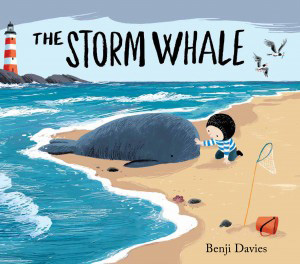
How Should It Begin?
Although many reviews begin with a short summary of the book (This book is about…), there are other options as well, so feel free to vary the way you begin your reviews.
In an introductory summary, be careful not to tell too much. If you retell the entire story, the reader won't feel the need to read it him/herself, and no one appreciates a spoiler (telling the end). Here are some examples of summaries reviewers from The New York Times have written:
"A new picture book tells a magically simple tale of a lonely boy, a stranded whale and a dad who rises to the occasion."
"In this middle-grade novel, a girl finds a way forward after the loss of her mother."
"Reared by ghosts, werewolves and other residents of the hillside cemetery he calls home, an orphan named Nobody Owens wonders how he will manage to survive among the living having learned all his lessons from the dead. And the man Jack — who killed the rest of Nobody's family — is itching to finish the job."
"In vivid poems that reflect the joy of finding her voice through writing stories, an award-winning author shares what it was like to grow up in the 1960s and 1970s in both the North and the South." Other ways to begin a review include:
- Quote: A striking quote from the book ("It was a bright cold day in April, and the clocks were striking thirteen.") can make for a powerful beginning. This quote begins George Orwell's novel 1984 .
- Background: What makes this book important or interesting? Is the author famous? Is it a series? This is This is how Amazon introduces Divergent : "This first book in Veronica Roth's #1 New York Times bestselling Divergent trilogy is the novel the inspired the major motion picture."
- Interesting Fact: For nonfiction books in particular, an interesting fact from the book may create a powerful opening for a review. In this review of The Middle East by Philip Steele, Zander H. of Mid-America Mensa asks, "Did you know that the Saudi Arabia's Rub' al-Khali desert reaches temperatures of 140 degrees Fahrenheit in the day and plummets to the freezing point at night?"
- Explanation of a term: If a word or phrase in the book or title is confusing or vitally important to understand, you may wish to begin the review explaining that term.
Process: What should I write about?
Deciding what to say about the book can be challenging. Use the following ideas as a guide, but remember that you should not put all of this into a single review — that would make for a very long review! Choose the things that fit this particular book best.
General Information What the reader ought to know
- What kind of book is it? (Picture book? Historical fiction? Nonfiction? Fantasy? Adventure?)
- Does the book belong to a series?
- How long is the book? Is it an easy or a challenging read?
- Is there anything that would be helpful for the reader to know about the author? For instance, is the author an expert in the field, the author of other popular books, or a first-time author?
- How does the book compare to other books on the same topic or in the same genre?
- Is the book written in a formal or informal style? Is the language remarkable in any way?
- What ages is the book geared to?
- Is the book written in normal prose? If it is written in poetic form, does it rhyme?
Plot What happens?
Writing about the plot is the trickiest part of a review because you want to give the reader a feel for what the book is about without spoiling the book for future readers. The most important thing to remember is that you must never give away the ending. No one likes a spoiler.
One possibility for doing this is to set up the premise (A brother and a sister find themselves lost in the woods at the mercy of an evil witch. Will they be able to outsmart her and escape?). Another possibility is to set up the major conflict in the book and leave it unresolved (Sometimes the waiting is the hardest part or He didn't know what he stood to lose or Finding your purpose in life can be as easy as finding a true friend.)
Try to avoid using the tired phrase "This book is about…" Instead, just jump right in (The stuffed rabbit wanted more than anything to live in the big old house with the wild oak trees.)
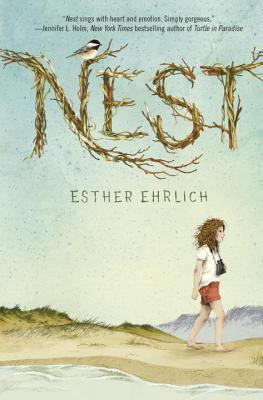
Characters Who lives in the book?
Reviews should answer questions about the characters in fiction books or non-fiction books about people. Some possible questions to answer include:
- Who are the main characters? Include the protagonist and antagonist.
- What makes them interesting?
- Do they act like real people act or are they too good or too evil to be believable?
- Are they human?
- What conflicts do they face?
- Are they likeable or understandable?
- How do they connect with each other?
- Do they appear in other books?
- Could you relate to any of the characters in the story?
- What problems did the main characters face?
- Who was your favorite character, and why?
- We learn about characters from things they do and say, as well as things other characters say about them. You may wish to include examples of these things.
Theme What is the book about at its heart?
What is the book really about? This isn't the plot, but rather the ideas behind the story. Is it about the triumph of good over evil or friendship or love or hope? Some common themes include: change, desire to escape, facing a challenge, heroism, the quest for power, and human weaknesses.
Sometimes a book will have a moral — a lesson to learn. If so, the theme is usually connected to that moral. As you write about the theme, try to identify what makes the book worth reading. What will the reader think about long after the book is finished? Ask yourself if there any particular lines in the book that strike you as meaningful.
Setting Where are we?
The setting is the time and place the story occurs. When you write about the setting in a review, include more than just the location. Some things to consider:
- Is the book set in the past, present or future?
- Is it set in the world we know or is it a fantastical world?
- Is it mostly realistic with elements of fantasy (animals that can talk, for example)?
- Is the setting unclear and fuzzy, or can you easily make the movie in your mind?
- How much does the author draw you into the setting and how does s/he accomplish that?
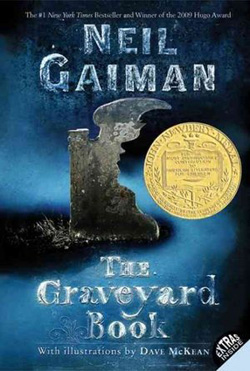
Opinion & Analysis What do you really think?
This is where the reviewer shares his/her reactions to the book that go beyond the essential points described above. You may spend half of the review on this section. Some possible questions to address include:
- Why do you think other readers would enjoy it? Why did you enjoy it (if you did) or why didn't you (if you didn't).
- What ages or types of readers do you think would like the book?
- How does it compare with other books that are in the same genre or by the same author?
- Does the book engage your emotions? If a book made you laugh or cry or think about it for days, be sure to include that.
- What do you like or dislike about the author's writing style? Is it funny? Is it hard to follow? Is it engaging and conversational in tone?
- How well do you think the author achieved what s/he was going for in the writing of the book? Do you think you felt what the author was hoping you would feel?
- Did the book feel complete, or did it feel as though key elements were left out?
- How does the book compare to other books like it you've read?
Are there parts that are simply not believable, even allowing for the reader's understanding that it is fiction or even fantasy?
- Are there mistakes?
- Would you describe the book as for entertainment, self-improvement, or information?
- What was your favorite part of the book?
- Would you have done anything differently had you been the author?
- Would any reader enjoy this book? If not, to what ages or type of reader would it appeal?
Special situations: Nonfiction and young reviewers
Some of the tips and ideas above work best for fiction, and some of it is a little too complicated for very young reviewers.
Nonfiction What to do if it's real
When reviewing a book of nonfiction, you will want to consider these questions:
- What was the author's purpose in writing the book? Did the author accomplish that purpose?
- Who is the target audience for the book?
- What do you think is the book's greatest value? What makes it special or worthwhile?
- Are the facts shared accurate?
- Is the book interesting and hold your attention?
- Would it be a useful addition to a school or public library?
- If the book is a biography or autobiography, how sympathetic is the subject?
- Is it easy to understand the ideas?
- Are there extra features that add to the enjoyment of the book, such as maps, indexes, glossaries, or other materials?
- Are the illustrations helpful?
Young Reviewers Keeping it simple
Reviewing a book can be fun, and it's not hard at all. Just ask yourself these questions:
- What is the book about? You don't need to tell the whole story over — just give an idea of what it's about.
- Do you think other people would like it?
- Did you think it was funny or sad?
- Did you learn something from the book?
- l Did you think it was interesting?
- Would you want to read it again?
- Would you want to read other books by the same author or about the same subject?
- What was your favorite part?
- Did you like the pictures?
Remember! Don't give away the ending. Let's keep that a surprise.
General Tips & Ideas
Use a few quotes or phrases (keep them short) from the book to illustrate the points you make about the book. If there are illustrations, be sure to comment on those. Are they well done? Has the illustrator done other well-known books?
Make sure you include a conclusion to the review — don't leave it hanging. The conclusion can be just one sentence (Overall, this book is a terrific choice for those who…).
You can use the transition word handout at the end of the Writer's Toolbox to find ideas for words to connect the ideas in your review. If you would like to read some well-written reviews, look for reviews of books for young people at The New York Times or National Public Radio .
Rating Books How to award stars?
Most places you post reviews ask you to rate the book using a star system, typically in a range of from one to five stars. In your rating, you should consider how the book compares to other books like it. Don't compare a long novel to a short poetry book — that's not a valid comparison.
It's important to remember that it's not asking you to only give five stars to the very best books ever written.
- 5 Stars: I'm glad I read it or I loved it (this doesn't mean it was your favorite book ever).
- 4 Stars: I like it. It's worth reading.
- 3 Stars: It wasn't very good.
- 2 Stars: I don't like it at all.
- 1 Star: I hate it.
Book Review Template
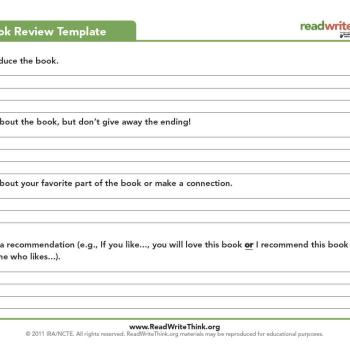
About this printout
Students can use this template as a means of communicating about a book that they have read.
Teaching with this printout
More ideas to try.
As students begin reading books at a young age, it is important to teach them to communicate their thoughts and ideas about the books they read. This template is a good way to teach students to begin putting their thoughts on a text into written form. Students will be able to process the information they read in a given text and process their ideas. Additionally, the Book Review Template allows the teacher to check a student's comprehension of a certain text to assess and inform instruction.
- Create a bulletin board with book reviews done by different students. The bulletin board can be organized by different genres of books or in other ways that are useful to students. Students can use this bulletin board as a way to read about their peers' thoughts on different books and to find books that they, too, might enjoy reading.
- At the beginning of the school year, do a read aloud and have students each do a book review on the same book that was read to the class. Have select students share their book reviews and/or thoughts on a book. Follow up by having a class discussion about why all of the book reviews are not alike, even though they were done on the same book. This discussion will familiarize students with different opinions and thoughts on the same books, and will also give struggling students a more concrete idea of how to do future book reviews on their own.
- Print this resource
Explore Resources by Grade
- Kindergarten K
How to Write a Book Review: Awesome Guide

A book review allows students to illustrate the author's intentions of writing the piece, as well as create a criticism of the book — as a whole. In other words, form an opinion of the author's presented ideas. Check out this guide from EssayPro - book review writing service to learn how to write a book review successfully.
What Is a Book Review?
You may prosper, “what is a book review?”. Book reviews are commonly assigned students to allow them to show a clear understanding of the novel. And to check if the students have actually read the book. The essay format is highly important for your consideration, take a look at the book review format below.
Book reviews are assigned to allow students to present their own opinion regarding the author’s ideas included in the book or passage. They are a form of literary criticism that analyzes the author’s ideas, writing techniques, and quality. A book analysis is entirely opinion-based, in relevance to the book. They are good practice for those who wish to become editors, due to the fact, editing requires a lot of criticism.
Book Review Template
The book review format includes an introduction, body, and conclusion.
- Introduction
- Describe the book cover and title.
- Include any subtitles at this stage.
- Include the Author’s Name.
- Write a brief description of the novel.
- Briefly introduce the main points of the body in your book review.
- Avoid mentioning any opinions at this time.
- Use about 3 quotations from the author’s novel.
- Summarize the quotations in your own words.
- Mention your own point-of-view of the quotation.
- Remember to keep every point included in its own paragraph.
- In brief, summarize the quotations.
- In brief, summarize the explanations.
- Finish with a concluding sentence.
- This can include your final opinion of the book.
- Star-Rating (Optional).
Get Your BOOK REVIEW WRITTEN!
Simply send us your paper requirements, choose a writer and we’ll get it done.
How to Write a Book Review: Step-By-Step
Writing a book review is something that can be done with every novel. Book reviews can apply to all novels, no matter the genre. Some genres may be harder than others. On the other hand, the book review format remains the same. Take a look at these step-by-step instructions from our professional writers to learn how to write a book review in-depth.

Step 1: Planning
Create an essay outline which includes all of the main points you wish to summarise in your book analysis. Include information about the characters, details of the plot, and some other important parts of your chosen novel. Reserve a body paragraph for each point you wish to talk about.
Consider these points before writing:
- What is the plot of the book? Understanding the plot enables you to write an effective review.
- Is the plot gripping? Does the plot make you want to continue reading the novel? Did you enjoy the plot? Does it manage to grab a reader’s attention?
- Are the writing techniques used by the author effective? Does the writer imply factors in-between the lines? What are they?
- Are the characters believable? Are the characters logical? Does the book make the characters are real while reading?
- Would you recommend the book to anyone? The most important thing: would you tell others to read this book? Is it good enough? Is it bad?
- What could be better? Keep in mind the quotes that could have been presented better. Criticize the writer.
Step 2: Introduction
Presumably, you have chosen your book. To begin, mention the book title and author’s name. Talk about the cover of the book. Write a thesis statement regarding the fictitious story or non-fictional novel. Which briefly describes the quoted material in the book review.
Step 3: Body
Choose a specific chapter or scenario to summarise. Include about 3 quotes in the body. Create summaries of each quote in your own words. It is also encouraged to include your own point-of-view and the way you interpret the quote. It is highly important to have one quote per paragraph.
Step 4: Conclusion
Write a summary of the summarised quotations and explanations, included in the body paragraphs. After doing so, finish book analysis with a concluding sentence to show the bigger picture of the book. Think to yourself, “Is it worth reading?”, and answer the question in black and white. However, write in-between the lines. Avoid stating “I like/dislike this book.”
Step 5: Rate the Book (Optional)
After writing a book review, you may want to include a rating. Including a star-rating provides further insight into the quality of the book, to your readers. Book reviews with star-ratings can be more effective, compared to those which don’t. Though, this is entirely optional.
Count on the support of our cheap essay writing service . We process all your requests fast.
Dive into literary analysis with EssayPro . Our experts can help you craft insightful book reviews that delve deep into the themes, characters, and narratives of your chosen books. Enhance your understanding and appreciation of literature with us.

Writing Tips
Here is the list of tips for the book review:

- A long introduction can certainly lower one’s grade: keep the beginning short. Readers don’t like to read the long introduction for any essay style.
- It is advisable to write book reviews about fiction: it is not a must. Though, reviewing fiction can be far more effective than writing about a piece of nonfiction
- Avoid Comparing: avoid comparing your chosen novel with other books you have previously read. Doing so can be confusing for the reader.
- Opinion Matters: including your own point-of-view is something that is often encouraged when writing book reviews.
- Refer to Templates: a book review template can help a student get a clearer understanding of the required writing style.
- Don’t be Afraid to Criticize: usually, your own opinion isn’t required for academic papers below Ph.D. level. On the other hand, for book reviews, there’s an exception.
- Use Positivity: include a fair amount of positive comments and criticism.
- Review The Chosen Novel: avoid making things up. Review only what is presented in the chosen book.
- Enjoyed the book? If you loved reading the book, state it. Doing so makes your book analysis more personalized.
Writing a book review is something worth thinking about. Professors commonly assign this form of an assignment to students to enable them to express a grasp of a novel. Following the book review format is highly useful for beginners, as well as reading step-by-step instructions. Writing tips is also useful for people who are new to this essay type. If you need a book review or essay, ask our book report writing services ' write paper for me ' and we'll give you a hand asap!
We also recommend that everyone read the article about essay topics . It will help broaden your horizons in writing a book review as well as other papers.
Book Review Examples
Referring to a book review example is highly useful to those who wish to get a clearer understanding of how to review a book. Take a look at our examples written by our professional writers. Click on the button to open the book review examples and feel free to use them as a reference.
Book review
Kenneth Grahame’s ‘The Wind in the Willows’
Kenneth Grahame’s ‘The Wind in the Willows’ is a novel aimed at youngsters. The plot, itself, is not American humor, but that of Great Britain. In terms of sarcasm, and British-related jokes. The novel illustrates a fair mix of the relationships between the human-like animals, and wildlife. The narrative acts as an important milestone in post-Victorian children’s literature.
Book Review
Dr. John’s ‘Pollution’
Dr. John’s ‘Pollution’ consists of 3 major parts. The first part is all about the polluted ocean. The second being about the pollution of the sky. The third part is an in-depth study of how humans can resolve these issues. The book is a piece of non-fiction that focuses on modern-day pollution ordeals faced by both animals and humans on Planet Earth. It also focuses on climate change, being the result of the global pollution ordeal.
Send to our custom term paper writing service your requirements, choose a writer and enjoy your time.
Need To Write a Book Review But DON’T HAVE THE TIME
We’re here to do it for you. Our professional coursework writing service ready to help 24/7
How To Write A Book Review?
What to include in a book review, what is a book review.

is an expert in nursing and healthcare, with a strong background in history, law, and literature. Holding advanced degrees in nursing and public health, his analytical approach and comprehensive knowledge help students navigate complex topics. On EssayPro blog, Adam provides insightful articles on everything from historical analysis to the intricacies of healthcare policies. In his downtime, he enjoys historical documentaries and volunteering at local clinics.

Related Articles
.webp)
Advertisement
Supported by
editors’ choice
6 New Books We Recommend This Week
Suggested reading from critics and editors at The New York Times.
- Share full article
This week’s recommended books include two memoirs by writers recalling their parents: “The Whole Staggering Mystery,” by Sylvia Brownrigg, digs into her father’s secret history, and “Did I Ever Tell You?,” by Genevieve Kingston, aims to capture her lost mother on the page. We also recommend two books about Mexico (a history and a journalistic exposé), along with a look at the neurological effects of climate change and a novel that puts U.S. immigration policy front and center. Happy reading. — Gregory Cowles
THE WEIGHT OF NATURE: How a Changing Climate Changes Our Brains Clayton Page Aldern
Aldern, a science journalist, asks us to consider the impact of climate change on our brains: According to this alarming book, a warming planet and natural resource depletion will mean everything from angrier, more anxious people to dolphins with Alzheimer’s disease. The litany, he writes, is almost “comically apocalyptic.”

“Aldern is the rare writer who dares to ask how climate change has already changed us.”
From Nathaniel Rich’s review
Dutton | $30
THE WHOLE STAGGERING MYSTERY: A Story of Fathers Lost and Found Sylvia Brownrigg
When Brownrigg’s remote and enigmatic father, Nick, died, his children were left with a key to his past in the form of a mysterious scrapbook. What they found was wilder than they could have possibly guessed: This hippie dropout, seemingly without family, was in fact heir to a British title and had a complex history that included colonial postings, mysterious deaths, lost novels and unexplained estrangements. Brownrigg sets out to discover what, exactly, happened — and does so with style and sensitivity.

“Gets at … the way in which, over generations and in the face of good intentions, family bonds can loosen and die. It’s dreadfully sad, and yet through Brownrigg’s sleuthing, something touching is redeemed.”
From Emma Brockes’s review
Counterpoint | $34.99
AMERICAN ABDUCTIONS Mauro Javier Cárdenas
In his new novel, Cárdenas considers the devastating effects of U.S. immigration policy on Latin American families, using expansive, pages-long sentences full of references to art, mysticism and ominous technologies. The main narrative involves an ailing Colombian man, recently deported from Califorrnia, and the painful choices facing his American-born daughters.

“Cárdenas creates what I’ll call an art-polemic — a melding of play with political purpose. From it, the cruelty of American immigration policy emerges: How else to capture such surreal inhumanity?”
From Gina Apostol’s review
Dalkey Archive | Paperback, $17.95
HABSBURGS ON THE RIO GRANDE: The Rise and Fall of the Second Mexican Empire Raymond Jonas
Jonas vividly recounts the story of Maximilian I of Mexico, the delusional Austrian archduke who tried to establish an enlightened monarchy on America’s southern border in the midst of the U.S. Civil War. “May my blood end the misfortunes of my new country,” he said as he stood before a republican firing squad, in 1867. “Viva Mexico!”

“Vividly reconstructs how Maximilian’s power was forged and maintained by the sharp end of a French bayonet. … Jonas is astute and judicious in navigating the kaleidoscope of contradictory political ideologies that came together in the Second Mexican Empire.”
From Natasha Wheatley’s review
Harvard University Press | $35
THE WAY THAT LEADS AMONG THE LOST: Life, Death, and Hope Among Mexico City’s Anexos Angela Garcia
An investigation of Mexico’s makeshift drug rehab centers for the poor, Garcia’s book combines anthropological field work with personal history, delivering an unvarnished chronicle of desperate patients, brutal treatment regimes and her own struggles with depression and a traumatic past.

“Offers a view of the war on drugs that differs from the familiar one. … The characters who populate Garcia’s pages reside on the periphery of urban life, and of the conflict itself.”
From Azam Ahmed’s review
Farrar, Straus & Giroux | $29
DID I EVER TELL YOU? Genevieve Kingston
In this heartfelt memoir, Kingston reflects on her mother’s death, in her late 40s, from breast cancer and the carefully cataloged notes and gifts she left for her children to open when she was gone. Kingston opens each on schedule, while reflecting that “the person I needed … was not the smiling, gentle mother wrapping birthday gifts” but “all of my mother, not only the softest pieces.”

“Wrenching. … Helped Kingston see the rage and terror her mother had papered over, as well as the steely will she’d summoned to keep going.”
From Kim Hubbard’s review
Marysue Rucci Books | $28.99
Explore More in Books
Want to know about the best books to read and the latest news start here..
An assault led to Chanel Miller’s best seller, “Know My Name,” but she had wanted to write children’s books since the second grade. She’s done that now with “Magnolia Wu Unfolds It All.”
When Reese Witherspoon is making selections for her book club , she wants books by women, with women at the center of the action who save themselves.
The Nobel Prize-winning author Alice Munro, who died on May 14 , specialized in exacting short stories that were novelistic in scope , spanning decades with intimacy and precision.
“The Light Eaters,” a new book by Zoë Schlanger, looks at how plants sense the world and the agency they have in their own lives.
Each week, top authors and critics join the Book Review’s podcast to talk about the latest news in the literary world. Listen here .
- Today's news
- Reviews and deals
- Climate change
- 2024 election
- Fall allergies
- Health news
- Mental health
- Sexual health
- Family health
- So mini ways
- Unapologetically
- Buying guides
Entertainment
- How to Watch
- My watchlist
- Stock market
- Biden economy
- Personal finance
- Stocks: most active
- Stocks: gainers
- Stocks: losers
- Trending tickers
- World indices
- US Treasury bonds
- Top mutual funds
- Highest open interest
- Highest implied volatility
- Currency converter
- Basic materials
- Communication services
- Consumer cyclical
- Consumer defensive
- Financial services
- Industrials
- Real estate
- Mutual funds
- Credit cards
- Balance transfer cards
- Cash back cards
- Rewards cards
- Travel cards
- Online checking
- High-yield savings
- Money market
- Home equity loan
- Personal loans
- Student loans
- Options pit
- Fantasy football
- Pro Pick 'Em
- College Pick 'Em
- Fantasy baseball
- Fantasy hockey
- Fantasy basketball
- Download the app
- Daily fantasy
- Scores and schedules
- GameChannel
- World Baseball Classic
- Premier League
- CONCACAF League
- Champions League
- Motorsports
- Horse racing
- Newsletters
New on Yahoo
- Privacy Dashboard
Book review: School-choice expert demonstrates power of parents in school wars | Opinion
I would be lying if I said that Corey DeAngelis’ new book, “The Parent Revolution,” did not leave me feeling angry.
Not for the same reasons that it makes his detractors mad, I’m sure.
The Cato Institute scholar’s new tome digs into the origins of the recent school choice movement and pegs that beginning as a time that many parents, myself included, would prefer to forget: COVID.
It was the era of school closures, maddening mandates, ascendant teacher’s unions and remote “learning” — or “remotely learning,” as DeAngelis describes it.
More importantly, it was the era when parents, thanks to the window into the public school day that “virtual learning” provided, came to realize that public education as we know it is not and never was a truly public good.
For DeAngelis, that was the moment when everything changed.
It was the moment when parents woke up, got organized and started demanding more control over their children’s education.
At the core of “The Parent Revolution” is the idea that students are best served when they have educational options available to them through education savings accounts, or ESAs, which allow public tax dollars to fund and follow the student, whether by paying tuition for a private or parochial school, funding tutoring services, buying home-schooling supplies or paying other education-related expenses that are not otherwise feasible for many middle-and-low-income families.
Whatever the case, ESAs allow parents to act in the best interest of their children and give kids the opportunity to learn in an environment that best suits their individual needs and values.
While critics wrongly assert that rerouting funds in this manner misappropriates dollars that otherwise “belong” to the public school system, DeAngelis correctly points out that having money follow the student is part of other public policies. Consider the GI Bill, Pell grants, and even some Head Start programs.
“We don’t force low-income families to get their food [via food stamps] from residentially assigned, government-run grocery stores,” DeAngelis says. So why don’t we apply the same policy to primary and secondary education?
That doesn’t seem unreasonable.
DeAngelis also synthesizes the manifold controversies that erupted across the nation over school policies on obscenity in books, bathroom use, and critical race theory, as well as how engaged (and enraged) parents began to push back on progressive school board agendas.
In many cases, parents successfully kicked out problematic school board members. In some cases, such as in Virginia, they used their firepower to reject high-level elected officials and candidates — those whose inane statements, such as “ I don’t think parents should be telling schools what they should teach,” only confirmed what most of us already believe progressives think about parents.
Remaking school boards was only one salvo in the parent revolution, though. Improving public school leadership is good. Ensuring that all students have options is the real target.
In some sense, DeAngelis has written a playbook for how to fight back against progressive government and its wholly owned subsidiaries, the teachers unions.
He offers not only insight into navigating the that challenges parents will face on the road to school choice but also gives convincing, research-backed arguments about how the benefits of education freedom extend well beyond youth and into society writ-large.
School choice programs are correlated with lower crime rates, higher incomes and stronger families, for example.
Of course, progressive government and educator unions aren’t the only opposition that school choice advocates face. Sometimes, the greatest obstacles are in the Republican Party.
Such has been the case in Texas, where, DeAngelis notes, there was greater support among GOP primary voters for a nonbinding pro-school-choice ballot proposition than a pro-life one.
Yet, in the last legislative session, an expansive ESA bill failed several times in the House, despite a strong Republican majority.
As someone who has spent most of his life in Texas, DeAngelis has a personal stake in the school-choice push here and promised, along with Gov. Greg Abbott, that there would be political consequences for Republican lawmakers who continue to block education reform.
Indeed: Nine pro-school-choice primary challengers unseated incumbents, with three more sent to runoffs that are next week.
Of course, it isn’t over until it’s over; the Legislature won’t meet again until next year.
But if similarly situated states, such as Iowa, are any indication, Texas is on its way to an even bigger school choice program than previously imagined.
I said at the beginning that “The Parent Revolution” made me angry, but I should qualify that anger is righteous. I, for one, am thrilled that education freedom is the silver lining to all the consternation that has embroiled our schools of late.
The case that DeAngelis makes for school choice isn’t just compelling, it’s inspiring. It’s a reminder — and perhaps a warning — to all who read it, that parents acting on behalf of their kids’ interests are far more powerful than any school board, teacher’s union or policy maker.
And finally, it’s a clarion call to those who have been hesitant or complacent with education policies.
We are entering an era of education reform. Answer the call.
Do you have an opinion on this topic? Tell us!
We love to hear from Texans with opinions on the news — and to publish those views in the Opinion section.
• Letters should be no more than 150 words.
• Writers should submit letters only once every 30 days.
• Include your name, address (including city of residence), phone number and email address, so we can contact you if we have questions.
You can submit a letter to the editor two ways:
• Email [email protected] (preferred).
• Fill out this online form.
Please note: Letters will be edited for style and clarity. Publication is not guaranteed. The best letters are focused on one topic.
Recommended Stories
Praktika raises $35.5m to use ai avatars to make learning languages feel more natural.
Most apps that help you learn languages feature a user experience that has you selecting options or swiping away wrong answer cards — you're more or less interacting with a machine. Language-learning app Praktika is adopting a different approach: It lets you create personalized AI-powered avatars to replicate the experience of having a private tutor, leveraging inflections like tone of voice and emotions to help make learning a language feel more natural. Praktika claims to have 1.2 million active monthly users across 100 countries, and said it generated revenue of almost $20 million in the last 12 months.
Trump is seeking crypto donations in the latest 2024 campaign outreach for digital wallets
Donald Trump's campaign announced Tuesday that it would now accept donations in crypto, the latest move by candidates on the 2024 campaign trail to embrace the digital coins and votes of crypto enthusiasts.
Humane, the creator of the $700 Ai Pin, is reportedly seeking a buyer
Humane, the company behind the much-hyped Ai Pin that launched to less-than-glowing reviews last month, is on the hunt for a buyer, Bloomberg reported citing anonymous sources. The company has reportedly priced itself between $750 million and $1 billion, and the sale process is in the early stages, Bloomberg cited the sources as saying. Founded in 2017 by former Apple executives Bethany Bongiorno and Imran Chaudhri, Humane had raised around $230 million from backers such as Microsoft, Qualcomm Ventures, Marc Benioff, and OpenAI’s Sam Altman before any part of its product was even publicly revealed.
The Morning After: We test Sonos’ first wireless headphones
Find out how good Sonos' first headphones are while eating some of Ninja's new Creami ice cream.
'A perfect soft-serve consistency': Scoop up this Ninja Creami Ice Cream Maker for just $149 — plus other deals of the day
Also on our cheat sheet: Spring savings on Kate Spade, Amazon Fire, Crest, KitchenAid and more early Memorial Day deals.
Heat-related illnesses sent thousands to the ER last summer. How to know your risk, recognize symptoms and stay cool.
What's the difference between heath exhaustion and heat stroke — and how can you prevent them? Experts share how to stay safe during soaring temperatures.
'The Masked Singer' Season 11: How to watch the finale tonight, plus who has been revealed so far
Start making your Goldfish and Gumball predictions. Season 11 of the 'The Masked Singer' comes to an end tonight.
Oyo, once valued at $10 billion, shelves IPO plans for second time
Oyo, the once high-flying Indian budget hotel chain, has withdrawn its IPO application from the Securities and Exchange Board of India (SEBI) for the second time in a fresh blow to its already diminished ambitions. The Gurugram-headquartered startup, which at its peak commanded a valuation of $10 billion, pulled the plug on its IPO plans on May 17, according to a disclosure on the regulator's website. Oyo had initially filed paperwork with SEBI in 2021 for a public listing but withdrew it and refiled in 2023.
Paytm warns of job cuts as losses swell after RBI clampdown
Indian digital payments platform Paytm warned of job cuts on Wednesday after reporting that its net loss widened in the fourth quarter as it grapples with a recent regulatory clampdown. One 97 Communications, Paytm's parent, said it expects to cut employee expenses and pare down its annual costs on staff by $48 million to $60 million. India's central bank in February banned the company's banking partner and sister company, Paytm Payments Bank, from conducting banking activity from March.
Oneil Cruz breaks records with multiple hits over 120 mph while lifting Pirates past Giants in extra innings
Oneil Cruz is the first player in the Statcast era to have multiple 120 mph hits in a single game.
Wearable AI Pin maker Humane is reportedly seeking a buyer
The tech startup Humane is reportedly seeking a buyer for its business and is hoping to sell for anywhere between $750 million and $1 billion.
In Seoul summit, heads of states and companies commit to AI safety
Government officials and AI industry executives agreed on Tuesday to apply elementary safety measures in the fast-moving field and establish an international safety research network. Nearly six months after the inaugural global summit on AI safety at Bletchley Park in England, Britain and South Korea are hosting the AI safety summit this week in Seoul. The British government announced on Tuesday a new agreement between 10 countries and the European Union to establish an international network similar to the U.K.'s AI Safety Institute, which is the world's first publicly backed organization, to accelerate the advancement of AI safety science.
OpenAI in the crosshairs: Scarlett Johansson's scathing statement, mass exodus of executives are among the company’s latest woes
OpenAI CEO Sam Altman was at one point dubbed "the Oppenheimer of AI." So what's going on under his leadership?
Braves' David Fletcher continuing to play in minors amid reported MLB investigation into illegal bets
Fletcher reportedly made bets with the same illegal bookie as Ippei Mizuhara, Shohei Ohtani's former interpreter.
Uber's and Lyft's ride-hailing deal with Minnesota comes at a cost
Uber and Lyft drivers in Minnesota will see higher pay thanks to a deal between the state and the country's two largest ride-hailing companies. The upshot: a new law that gives some protections to drivers while placing limits on state government. The bill, which Governor Tim Walz has supported publicly and is expected to sign, stipulates that starting January 1, 2025, drivers will be entitled to earn at least $1.28 per mile and $0.31 per minute.
Sperm counts have been declining for decades. Are microplastics partly to blame?
A new study detected microplastics, such as ones found in plastic bottles and bags, in human testes. How harmful is that for male fertility?
‘A different vibe’: Amid upheaval and controversy, Raheem Morris looks to bring a new culture to Atlanta
It’s early yet, but the first days of the Morris era have drawn positive reviews.
Justin Fields on Steelers QB situation, Russell Wilson: 'I'm definitely competing. Russ knows that'
"I'm nowhere near my ceiling," Fields said. Wilson told reporters: "I don't blink."
The DOJ makes its first known arrest for AI-generated CSAM
The US Department of Justice arrested a Wisconsin man last week for generating and distributing AI-generated child sexual abuse material. As far as we know, this is the first case of its kind as the DOJ looks to establish a judicial precedent that exploitative materials are still harmful even when no children were used to create them.
Wayfair Memorial Day sale 2024: Save up to 70% on outdoor furniture, grills, mattresses and more
Save big this holiday weekend on everything from patio furniture and grills to mattresses and cookware.
All Colorado schools are CLOSED today due to inclement weather.

FIND A SCHOOL
Schedule a tour, “blossom & bud” by frank j. sielo – buddy’s book review.
Welcome to Buddy’s Book Review ! A review of our favorite children’s books here at The Nest Schools. We thoroughly believe in the power of literature, and we are excited to introduce wonderful new children’s books to our families in hopes that they will expand their own home libraries as we expand our own!
How will we review and rate each book? Each book will be rated in terms of its likeness to our core values: KINDNESS , WELLNESS , INNOVATION, and FUN . Five beautiful feathers will be given for the core value we think each book best represents. Happy Reading!

Blossom and Bud, a story written by Frank J. Sielo and illustrated by Brittany E. Lakin, is a beautiful children’s book that promotes self-love, builds a positive self-image, and shows kindness to all, no matter how different we may seem.
In this book, we meet two unique and wonderful characters who feel undeserving simply because they look different. Blossom, the tallest flower in the shop, and Bud, the smallest one, just waiting to bloom. But on one special day, Mr. Baxter finds the perfect spot for both Blossom and Bud to shine, to feel loved, and to feel proud of who they are.
Brittany E. Lakin’s beautiful illustrations make every reader feel as if they are living inside Mr. Baxter’s flower shop! The colors, details, and beautiful diversity represented in her work help to fulfill the powerful message of kindness, self-love, and acceptance of others despite our differences.
With its thoughtful language and beautiful illustrations, this story is not only engaging for young children but also leaves room for discovery and conversation about self-worth, kindness, and diversity.
Buddy is proud to give Blossom and Bud five feathers for KINDNESS and hopes that YOU will always remember to be kind to yourself and others.
You are perfect just the way you are!
Copyright 2021

Book Review: ‘Cujo’ character returns as one of 12 stories in Stephen King’s ‘You Like It Darker’
The Associated Press
May 20, 2024, 2:48 PM
- Share This:
- share on facebook
- share on threads
- share on linkedin
- share on email
In Stephen King’s world, “It” is a loaded word. It’s hard not to picture Pennywise the Clown haunting the sewers of Derry, Maine, of course, but in the horror writer’s newest collection of stories, “You Like It Darker,” “It” ranges from a suspicious stranger on a park bench, to an extraterrestrial being bestowing a gift that helps best friends realize their potential, to telepaths whose sole job is to keep airplanes from falling out of the sky.
Twelve stories makes up the book, with one of the longest (90 pages), “Rattlesnakes,” reintroducing readers to Vic Trenton, who King fans will remember as the father of Tad, the boy killed by the rabid St. Bernard Cujo in King’s 1981 novel of that name. Now 72, Trenton is riding out the pandemic at a friend’s waterfront property in the Florida Keys, where he meets a widow who also lost loved ones in a terrible accident. It’s fairly creepy, featuring long-dead twins trying to haunt their way back to life, but it’s hardly the darkest here.
I’d give that honor to “The Fifth Step,” which in just 10 pages should scare anyone who’s been paying attention to the true crime stories splashed across the screens of this country’s tawdrier news sources. But is it “darker,” really than any of the more than 60 books King has written in his illustrious career? Probably not, but perhaps the afterword quote from the author, also featured on the back of the hardcover — “You like it darker? Fine. So do I.” — helps sell books in today’s extreme world, even for a perennial bestseller like Mr. King.
The best of these stories, as is true with the best of King’s work, feature horror tempered with heart. I really enjoyed “On Slide Inn Road,” featuring a grandfather who’s still pretty accurate with a baseball bat, and “The Answer Man,” which poses the question, “If you could know anything about the future, what would it be?”
I’d like to know how much longer we’ll have to enjoy this uniquely American icon, who at the age of 76 continues to write and publish at a furious pace. This collection’s afterword reads like a recording from King’s therapist’s couch, or a confessional on a reality TV series. He admits “the only two times I ever came close to getting it all were in two prison stories: ‘The Green Mile’ and ‘Rita Hayworth and Shawshank Redemption.’” Here’s hoping he keeps trying, because like millions of others around the world, I’ll read every word.
AP book reviews: https://apnews.com/hub/book-reviews
Copyright © 2024 The Associated Press. All rights reserved. This material may not be published, broadcast, written or redistributed.
Related News

Can you guess the mystery voices of Gumball and Goldfish in ‘The Masked Singer’ finale?

German author Jenny Erpenbeck wins International Booker Prize for tale of tangled love affair

Trump campaign calls ‘The Apprentice’ film ‘blatantly false,’ director offers to screen it for him
Recommended.

'Not acceptable': DC attorney general seeks overhaul of agency tasked with rehabilitating youth offenders

Why the Better Business Bureau is warning Facebook page owners about a new scam

Hogan makes abortion-rights stand in Senate race
Related categories:.
You have exceeded your limit for simultaneous device logins.
Your current subscription allows you to be actively logged in on up to three (3) devices simultaneously. click on continue below to log out of other sessions and log in on this device., 2 books about eid al-adha to share with young readers.

These titles take a look at two traditions around the Muslim holiday that commemorates the story of Ibrahim (Abraham).

Eid al-Adha, "Festival of Sacrifice" in Arabic, is a Muslim holiday that commemorates the story of Ibrahim (Abraham), who was going to sacrifice his son when God asked him to. In the end, Ibrahim sacrificed an animal that God provided instead. These books take a look at two traditions around the Muslim holiday.
I’ll See You in Ijebu by Bunmi Emenanjo. illus. by Diana Ejaita. Barefoot. ISBN 9781646868438. Gr 3-8 –A book that teaches readers about Eid al-Adha, while enchanting them with a special story. A young girl is in a car on the way to Baba’s house in Ijebu. It takes a long time to get to Baba’s house, so readers know this isn’t a frequent trip but a treasured journey to be with loved ones. Once there, it is the smell of Baba rising “slowly from his seat…his scent of native black soap and mothballs” that surrounds the girl in an embrace she wants to remember. In the beginning, readers are transported to a hot, sweaty traffic jam with the smell of “crunchy dundun and sweet puff puff frying” that makes the girl’s stomach growl. This humanizing moment—loud and embarrassing and funny, all at the same time—is relatable for readers, who will automatically be enamored from this point. Emenanjo writes like a veteran, with words that cling to thoughts and resonate with all the senses: the sounds and smells linger. VERDICT A story to be read again and again. Good for the entire family, and a must-have for middle school libraries. – Christina Paolozzi

Get Print. Get Digital. Get Both!
Libraries are always evolving. Stay ahead. Log In.
Add Comment :-
Be the first reader to comment.
Comment Policy:
- Be respectful, and do not attack the author, people mentioned in the article, or other commenters. Take on the idea, not the messenger.
- Don't use obscene, profane, or vulgar language.
- Stay on point. Comments that stray from the topic at hand may be deleted.
- Comments may be republished in print, online, or other forms of media.
- If you see something objectionable, please let us know . Once a comment has been flagged, a staff member will investigate.
First Name should not be empty !!!
Last Name should not be empty !!!
email should not be empty !!!
Comment should not be empty !!!
You should check the checkbox.
Please check the reCaptcha

Ethan Smith
Lorem Ipsum is simply dummy text of the printing and typesetting industry. Lorem Ipsum has been the industry's standard dummy text ever since the 1500s, when an unknown printer took a galley of type and scrambled it to make a type specimen book.
Posted 6 hours ago REPLY
Jane Fitgzgerald
Posted 6 hours ago
Michael Woodward
Continue reading.

Added To Cart
Related , 2 early readers about unicorns | transitional spotlight, 11 standout caribbean picture books of 2024, let’s talk periods: middle grade books about menstruation, social media + disability + picture books = friendship | interview, lgbtqia+ books fly in the face of bans, "what is this" design thinking from an lis student.
The job outlook in 2030: Librarians will be in demand

Lorem ipsum dolor sit amet, --> Log In
You did not sign in correctly or your account is temporarily disabled

REGISTER FREE to keep reading
If you are already a member, please log in.
Passwords must include at least 8 characters.
Your password must include at least three of these elements: lower case letters, upper case letters, numbers, or special characters.
The email you entered already exists. Please reset your password to gain access to your account.
Create an account password and save time in the future. Get immediate access to:
News, opinion, features, and breaking stories
Exclusive video library and multimedia content
Full, searchable archives of more than 300,000 reviews and thousands of articles
Research reports, data analysis, white papers, and expert opinion
Passwords must include at least 8 characters. Please try your entry again.
Your password must include at least three of these elements: lower case letters, upper case letters, numbers, or special characters. Please try your entry again.
Thank you for registering. To have the latest stories delivered to your inbox, select as many free newsletters as you like below.
No thanks. return to article, already a subscriber log in.
We are currently offering this content for free. Sign up now to activate your personal profile, where you can save articles for future viewing
Thank you for visiting.
We’ve noticed you are using a private browser. To continue, please log in or create an account.

CREATE AN ACCOUNT
SUBSCRIPTION OPTIONS
Already a subscriber log in.
Most SLJ reviews are exclusive to subscribers.
As a subscriber, you'll receive unlimited access to all reviews dating back to 2010.
To access other site content, visit our homepage .
20 new books you need to read this summer
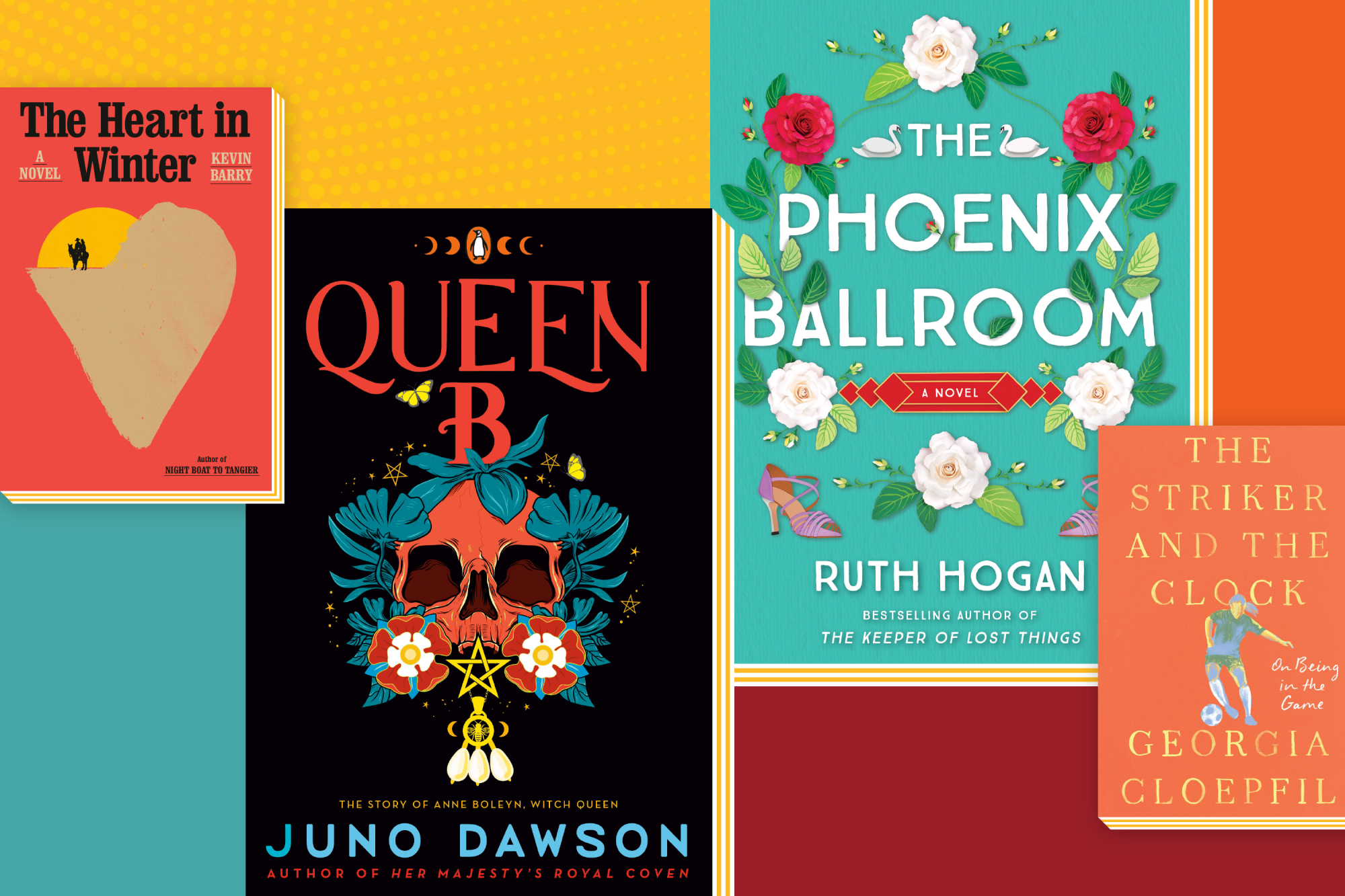
- Show more sharing options
- Copy Link URL Copied!
There was a time when “summer books” meant popcorn reads you consumed in a sunbaked afternoon — disposable books devoured and left behind for the next hotel room guest.
Not that there’s anything wrong with the joy of a high-paced thriller, the passionate heights of romance or the horror that raises goosebumps in the heat. We love them ourselves. But summer is also a time for slowing down to taste lots of literary flavors, whether it’s the spiciness of a globe-trotting adventure, the sweetness of late-life companionship or the bite of salt-and-vinegar short stories. Summer 2024 is an overflowing picnic basket of choices.
Here are 20 forthcoming books — publishing between late May and August — that we recommend to kick off the reading season. For those of us unable to travel this year, nothing beats the simple pleasure of a great book with a cold drink on a summer afternoon.
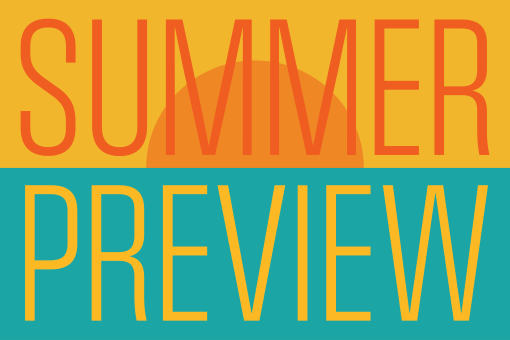
Ah, summer. The time of year when school lets out, days grow long and grills fire up. Even in places like L.A., though, where rain can be scarce, there are plenty of reasons (too hot, too lazy, too sunburned) to stay inside and curl up with some AC. That’s where The Times’ 2024 Summer Preview comes in: As you check out our guides to the movies, TV shows and books we’re looking forward to this season, be sure to read the stories below about some of the most highly anticipated.
- We strap in with director George Miller, the ‘Mad Max’ mastermind, back with ‘Furiosa’
- ‘I relive it every night’: Jeremy Renner reflects on the day he almost died, and why he’s alive
- A gender-fluid childhood at an RV park in the desert. Zoë Bossiere wouldn’t change a thing
Kittentits By Holly Wilson Zando-Gillian Flynn Books: 368 pages, $28 (May 21)
Ten-year-old homeschooled Molly is bored with life at the nun-haunted House of Friends. Scuzzy daredevil Jeanie arrives at their living community after a disastrous fire, leaving Molly enthralled. When Jeanie fakes her own death, Molly runs away to find her at the 1992 Chicago World’s Fair and to connect with their dead moms. Molly learns a passel of thinpgs in this surrealist, carnivalesque bildungsroman.
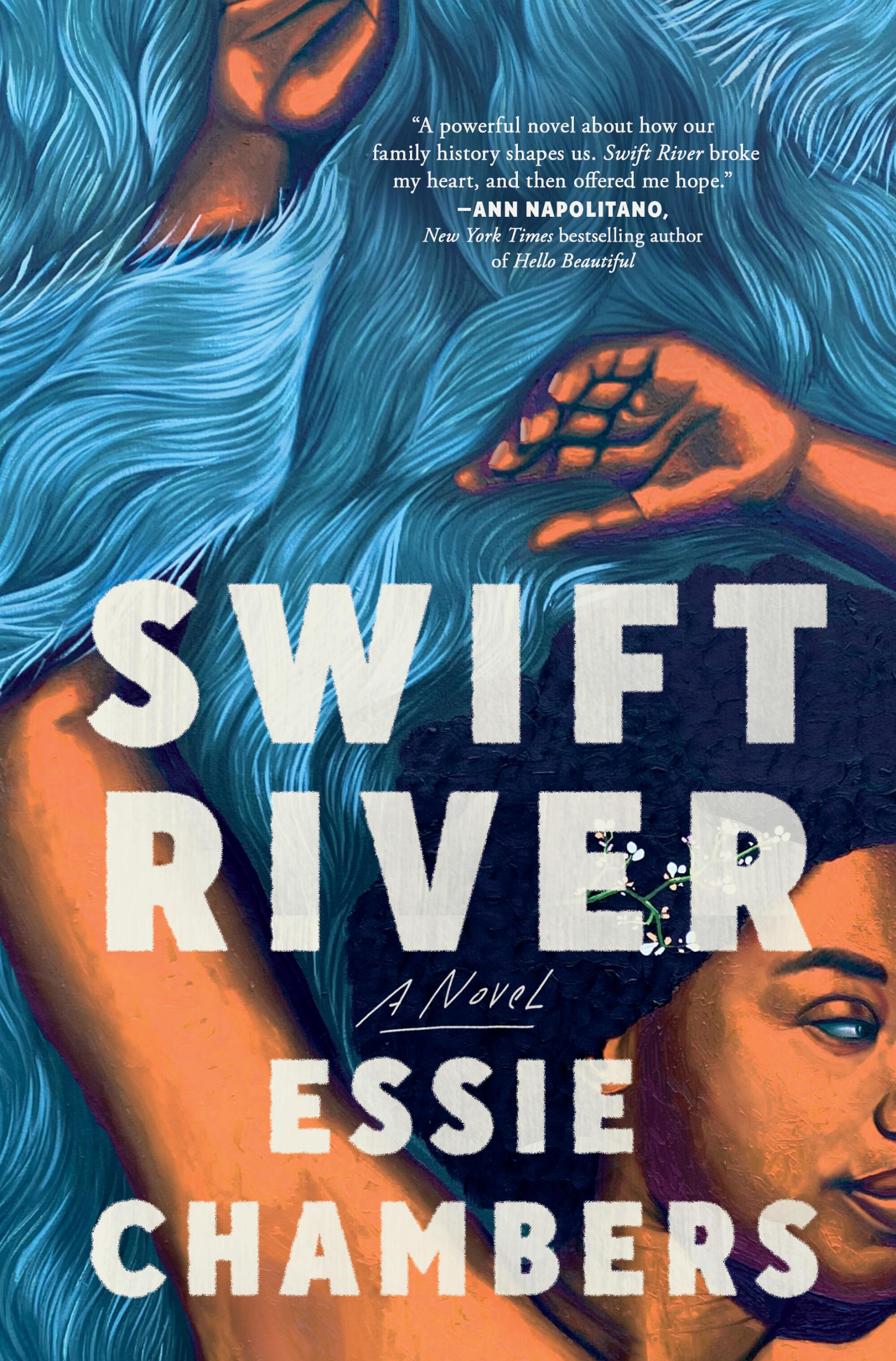
Swift River By Essie Chambers Simon & Schuster: 304 pages, $28 (June 4)
Chambers’ funny debut is set in a 1980s New England mill town in decline. Seven years after her father’s disappearance, Diamond Newberry and her mother are struggling, but Diamond’s observations provide comic leavening. During the summer of 1987, her mom files to have Pop declared dead, which is when things get complicated. Diamond receives a letter from an unknown relative, which starts her on a path to learn her family — and the nation’s — history.

Kathleen Hanna is a troubadour unafraid to speak out
Kathleen Hanna’s memoir, ‘Rebel Girl,’ is a bold portrait: a crucial book about feminist politics and art and a tender examination of a woman who survived abuse and sexual assault.
May 2, 2024
Godwin By Joseph O’Neill Pantheon: 288 pages, $28 (June 4)
“The next Pelé” or “the next Messi” are words sure to ignite the fantasies of soccer fans anywhere. When tech writer Mark is contacted by his sports agent, half-brother Geoff, Mark leaves Pittsburgh to join him on a madcap adventure to find such a phenom: an African teenager known only as “Godwin.” O’Neill combines the brothers’ exploits with sharp observations about international business and issues like greenwashing and corruption that have tarnished the world’s game.
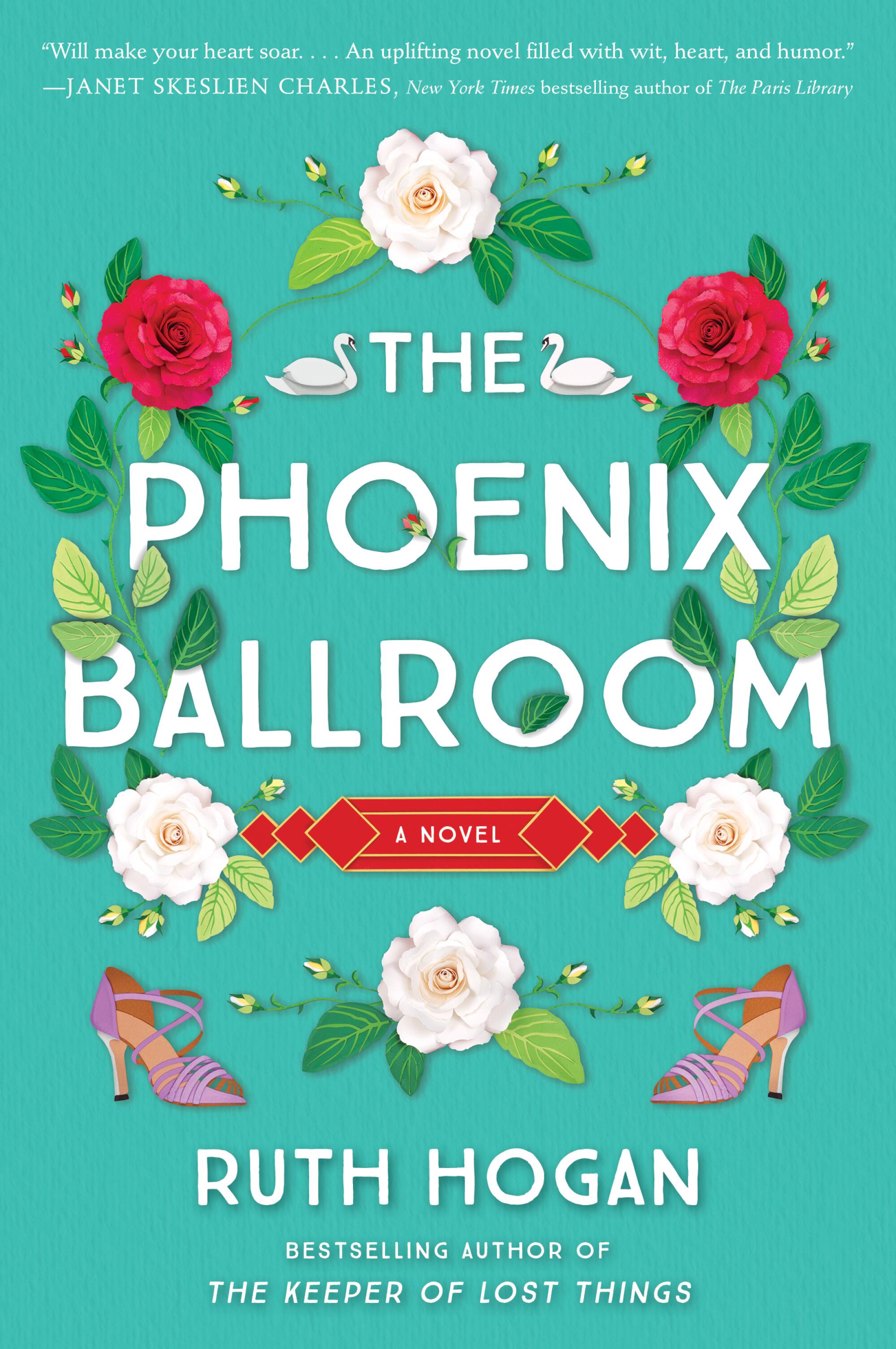
The Phoenix Ballroom By Ruth Hogan William Morrow: 320 pages, $19 (June 11)
How late is too late for a woman to change her life? In Hogan’s novel of life during widowhood, Venetia Hargreaves searches for a new self in her 70s. After 50 years of marriage, Venetia, who used to be an accomplished dancer, embraces her newly independent life. On a walk, she passes by an old building that had once been the Phoenix Ballroom, which she buys and restores. In hopes of a return to her youthful days, Venetia finds community in an entertaining motley crew of lost souls.
Summer Books Preview
20 books to keep you reading through August If you buy books linked on our site, The Times may earn a commission from Bookshop.org , whose fees support independent bookstores.
Sons of El Rey By Alex Espinoza Simon and Schuster: 384 pages, $29 (June 11)
Lucha libre took its hold in Mexico, and its high-flying masked performers are the superstars in its freestyle wrestling rings. In Espinoza’s entertaining and poignant novel, he writes of Ernesto Vega’s fame and fortune as a luchador known to his fans as El Rey Coyote. In East Los Angeles, his son, Freddy, fights to save his dad’s gym while Freddy’s gay son, Julian, seeks purpose. As Ernesto reaches the end of his life, his son and grandson will find their own answers in the streets of 1980s L.A. and the present reality of West Hollywood.
Bear By Julia Phillips Hogarth: 304 pages, $28 (June 25)
One of “Grimms’ Fairy Tales” inspired Phillips, a 2024 Guggenheim fellow and lauded author of “Disappearing Earth.” Sisters Sam and Elena live on an island off the coast of Washington, their birthplace that’s become a dead end for them both. When Sam spies a swimming bear from the ferry where she works, she is shocked, but it’s an even bigger surprise when the bear shows up at their house. A retelling of “Rose Red and Snow White,” “Bear” is a fantabulous delight.
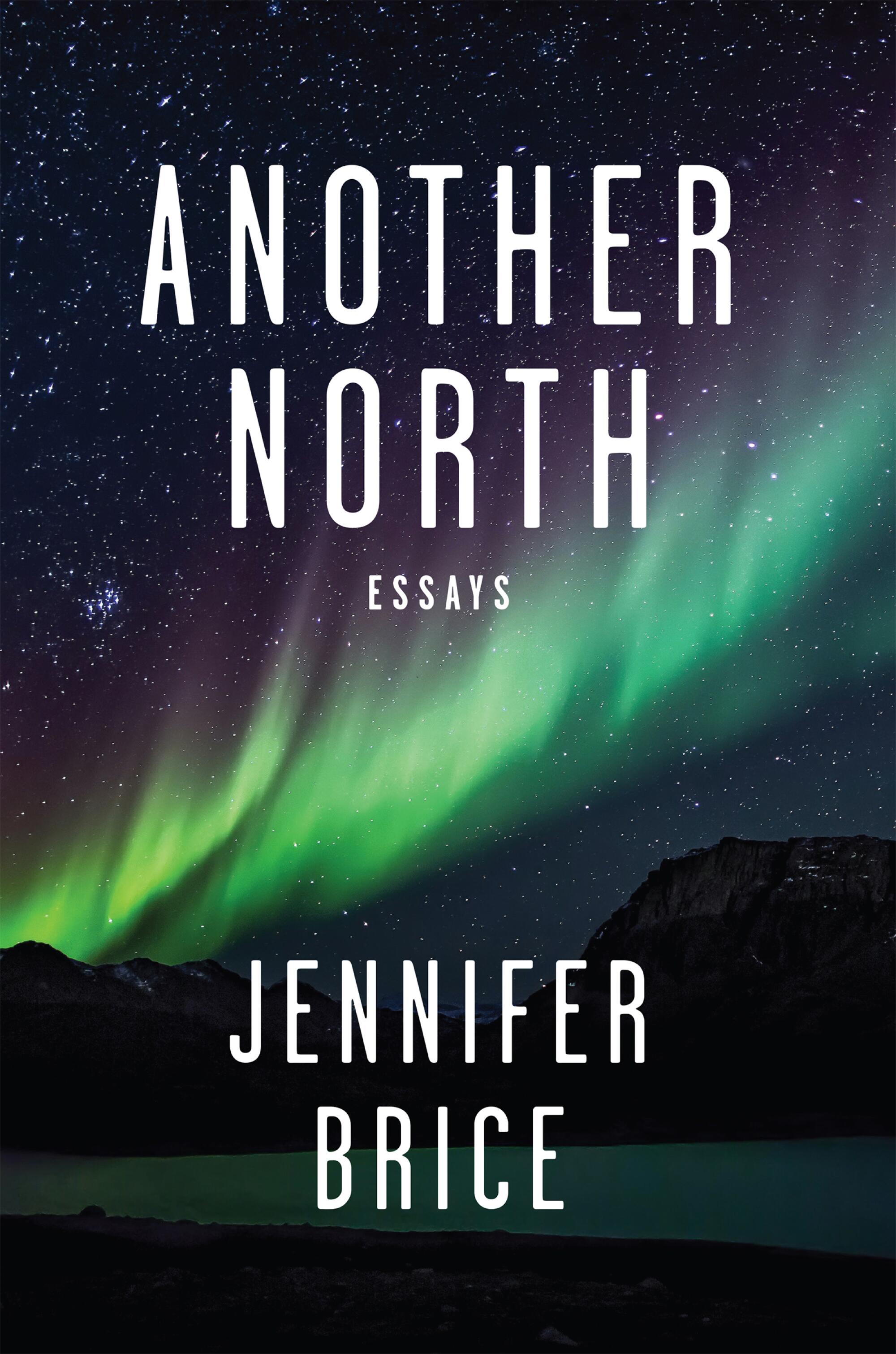
Another North By Jennifer Brice Boreal Books: 240 pages, $18 (June 25)
Brice previously chronicled her Alaska youth in “Unlearning to Fly.” In “Another North,” she returns to Fairbanks as a divorced woman longing for a sense of home. The new collection takes readers from her life as a professor in New York‘s Leatherstocking Country to her days piloting small planes in the Alaska bush. Brice is a beautiful prose stylist, and her book navigates the turbulence of middle age with a steady — and elegant — hand.

3 best mystery books to read this spring
Explore the mysteries of fictional and real worlds with four Los Angeles writers who pay homage to giants of the genre while creating stories that are irresistible in their own right.
April 3, 2024
Pink Slime By Fernanda Trías Scribner: 240 pages, $24 (July 2)
Trías won the National Uruguayan Literature Prize in her native country, and “Pink Slime,” newly translated by Heather Cleary, is a great display of her chops. Set in a city diminished by plague and a poisonous algae bloom, the narrator focuses her attention on her remaining relationships. In writing about the ways folks hold together during difficult times, Trías untangles the myths and realities of resilience.
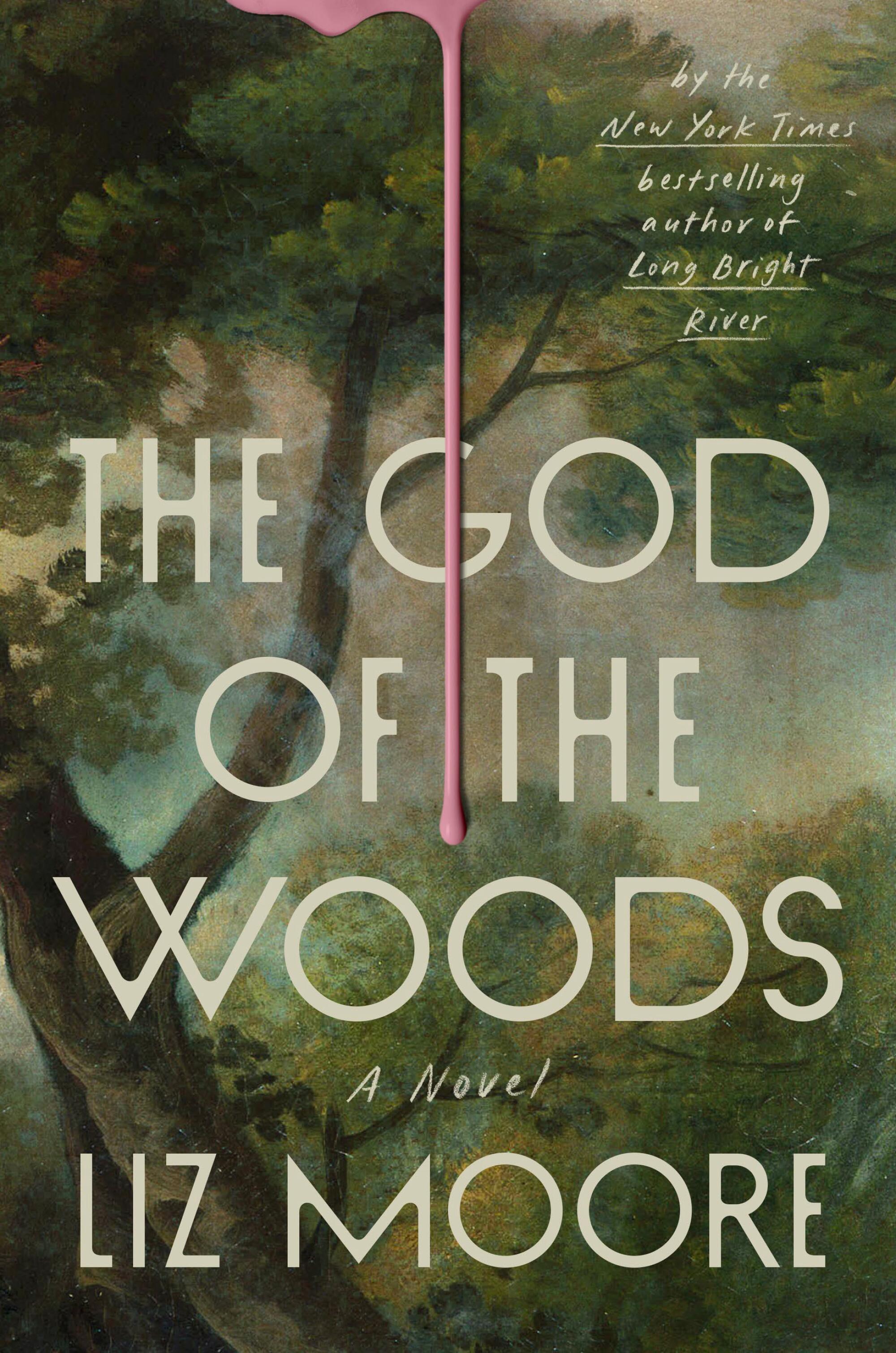
The God of the Woods by Liz Moore Riverhead: 496 pages, $30 (July 2)
Moore takes readers to an Adirondack summer camp in the mid-’70s. When Barbara Van Laar’s bunk turns up empty one morning, it sets off a frenzied search by the surrounding community. Barbara appears to have suffered the same fate as her brother, who disappeared 14 years prior. Moore’s familiarity with the Adirondacks — and the area’s long history as a playground of the rich — inspired this multilayered novel about wealthy wilderness camp people and the blue-collar folks who must accommodate them.
All This & More By Peng Shepherd William Morrow: 512 pages, $30 ` (July 9)
Shepherd, a finalist for a 2023 L.A. Times Book Prize, returns with another clever novel that plays with time and space. Here readers meet Marsh (short for Marshmallow), a 45-year-old woman who is disappointed with her lot in life. Happiness beckons when she is selected to star in a reality show where all of her past mistakes can be fixed, if she is willing to accept the consequences. Shepherd includes “choose your own adventure” moments for readers so Marsh’s fate is in their hands.
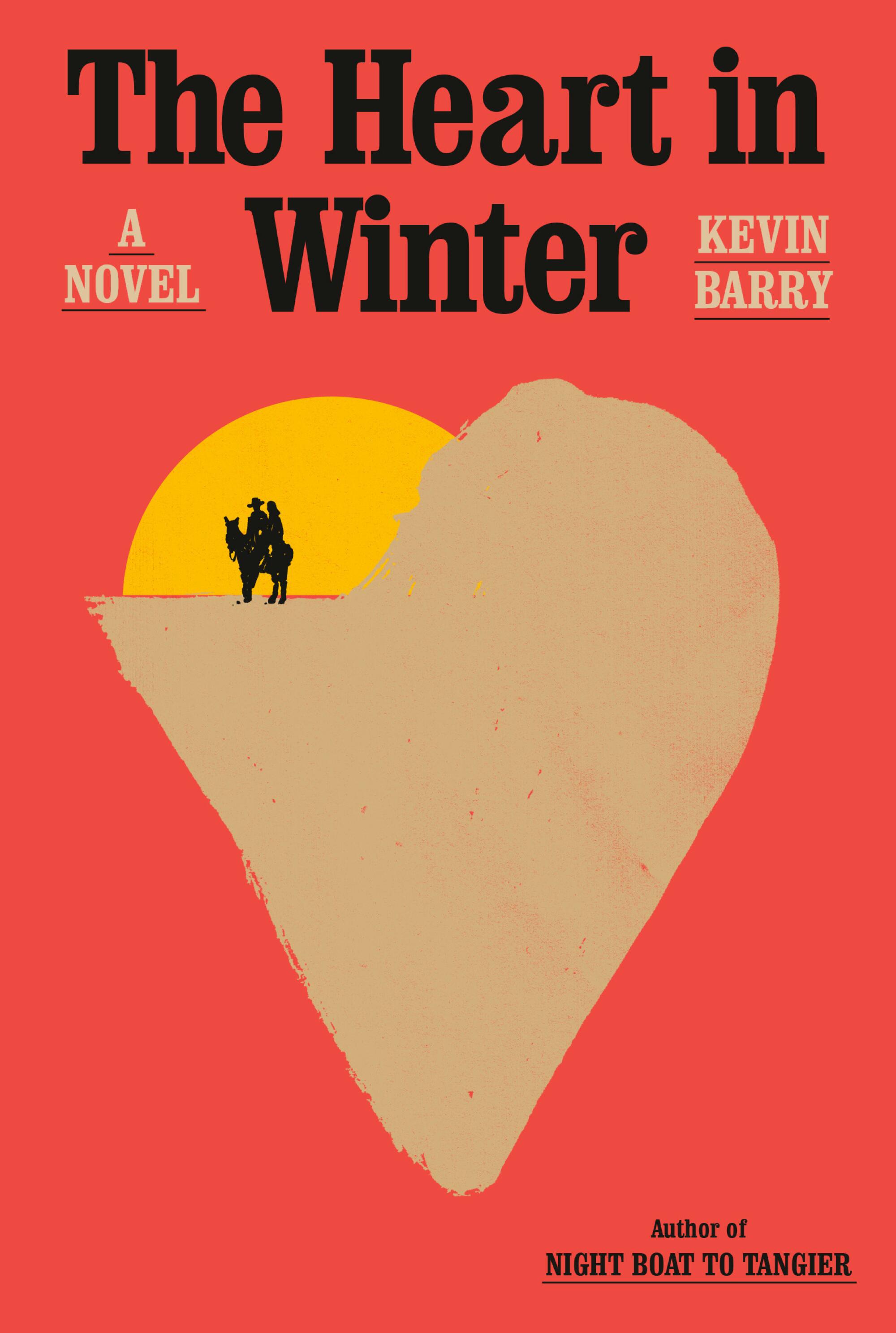
The Heart in Winter By Kevin Barry Doubleday: 256 pages, $28 (July 9)
Irish Booker Prize nominee Kevin Barry traverses the Atlantic in this story set in 1891 Montana. Immigrant workers toil in the copper mines that build Butte’s fortunes. In the midst of the archetypical frontier town, Tom Rourke fuels himself by drinking, doping and writing. When he falls head over heels for the mine captain’s new wife, Polly, a cadre of crazy Cornishmen take off in hot pursuit of the poet and his muse.

Why Don Winslow’s ‘City in Ruins’ will be his last novel
Don Winslow reveals why his latest novel, ‘City in Ruins,’ the final installment in the Danny Ryan series, will be his last.
April 1, 2024
Bad Tourists by Caro Carver Avid Reader: 336 pages, $29 (July 9)
In addition to malfunctioning airplanes, one of the hazards of traveling is getting caught up in a group of bad tourists. In Carver’s tropical paradise of a book, a trio of friends heads to the Maldives to make over their 40-something lives. What should be fun turns dangerous when a body shows up on the white beaches outside their resort. In both a romp and a thriller, Carver immerses readers in secret-filled waters.
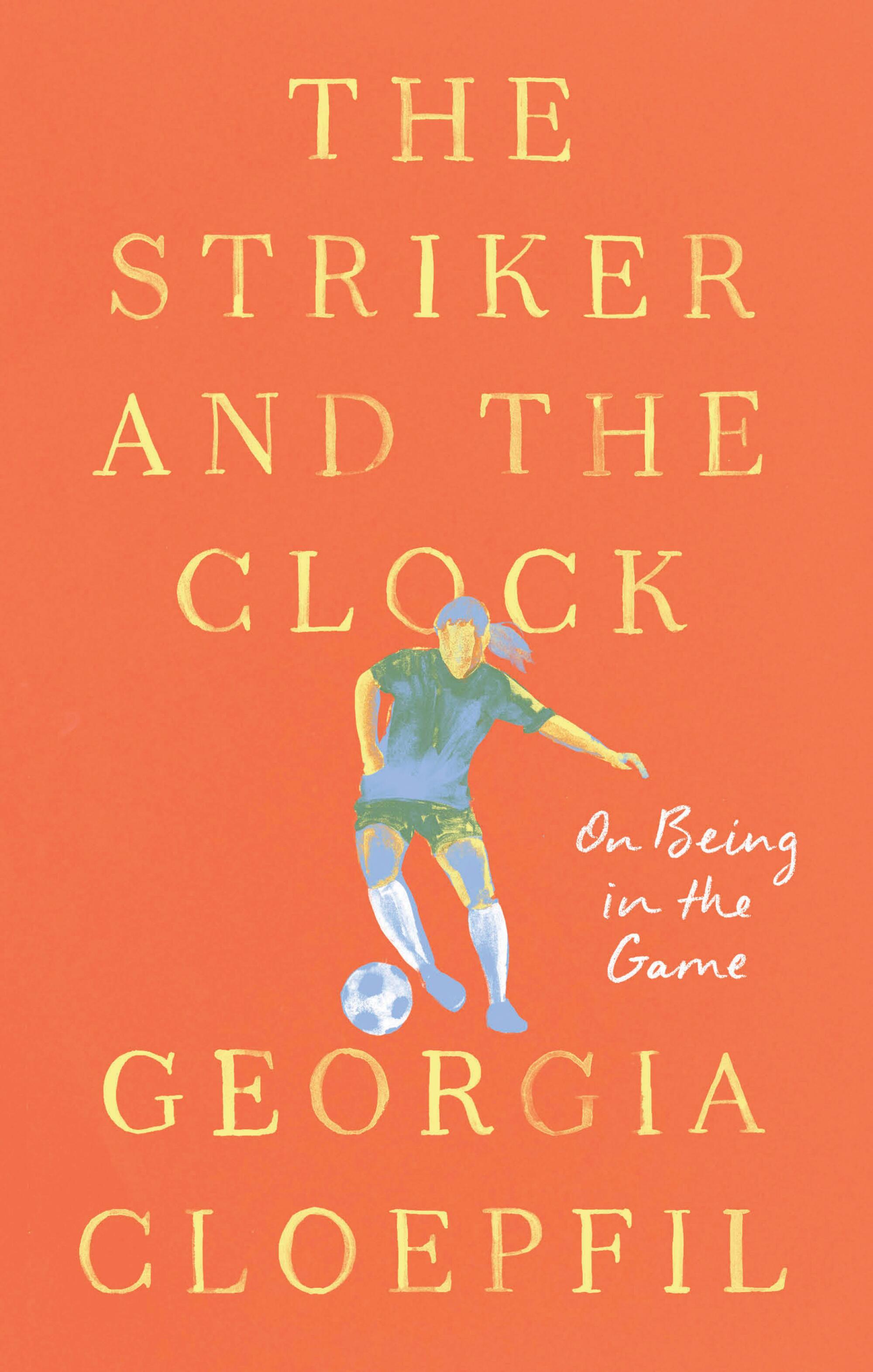
The Striker and the Clock: On Being in the Game By Georgia Cloepfil Riverhead: 208 pages, $27 (July 16)
A watershed moment in women’s sports this past spring has cast a light on the athletes who, instead of riches, face uncertain futures after graduation. In this riveting memoir by professional soccer player Cloepfil, she takes readers on a trip with her to find a living playing in South Korea, Australia, Lithuania and other far-flung locations. A paean to the beautiful game, the book chronicles how Cloepfil overcame adversity to strike joy.
Sugar on the Bones By Joe R. Lansdale Mulholland: 336 pages, $29 (July 16)
Lansdale makes a triumphant return to his Hap and Leonard novels with this scorcher. When Minnie Polson comes to the duo’s PI agency seeking help, things go south after an ill-timed remark causes her to storm out. She later turns up dead and the guilt-stricken pair seeks her killer. Minnie’s family — full of eccentricities and petty grievances — are the unusual suspects.
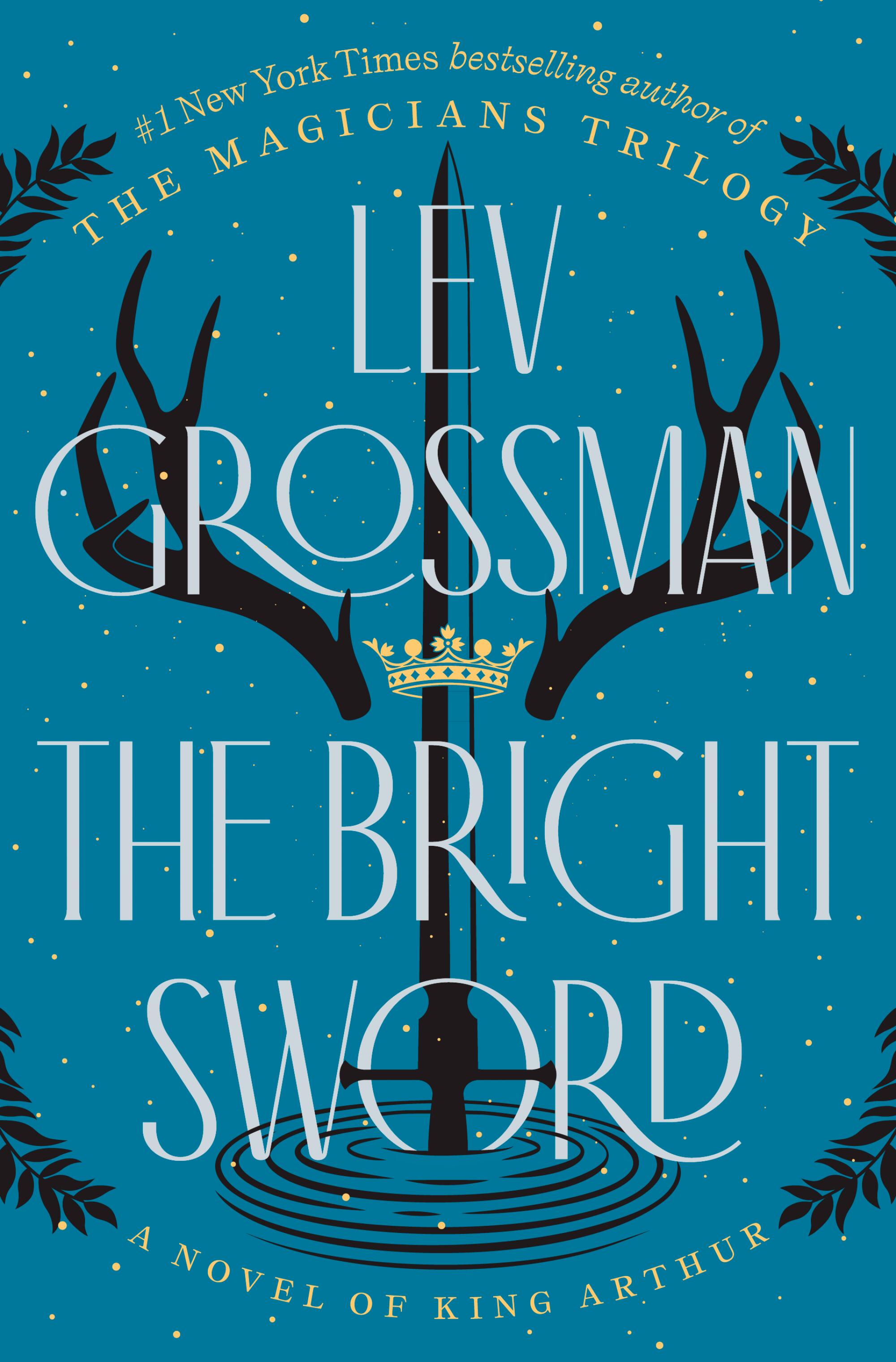
The Bright Sword By Lev Grossman Viking: 688 pages, $35 (July 16)
Grossman follows up his wildly successful “The Magicians” trilogy with this tale of misfits at King Arthur’s Round Table. Arthur is dead and just a few of his knights remain in Camelot. Enter Collum — two weeks too late to serve Arthur — a young knight who teams up with Merlin’s former apprentice and Sir Bedivere, Sir Palomides and Sir Dagonet. Their journey through a land riven by conflict in search of Arthur’s successor will reveal the country’s bloody origins.

Instead of writing about Princess Diana, Chris Bohjalian opted for her Vegas impersonator
Author Chris Bohjalian discusses his 25th novel, ‘The Princess of Las Vegas,’ and how ancestral trauma from his Armenian heritage contributes to the dread in his work.
March 19, 2024
The Wilds By Sarah Pearse Pamela Dorman Books: 400 pages, $30 (July 16)
Detective Elin Warner can’t get a break from her job. Each time she goes on a vacation or retreat, murder follows. She travels to Portugal to immerse herself in nature but her sojourn is interrupted by a young woman’s disappearance. The missing woman’s map leads Elin into the wilderness where scenes of great beauty turn dark and threatening. Pearse has written another intriguing page-turner.
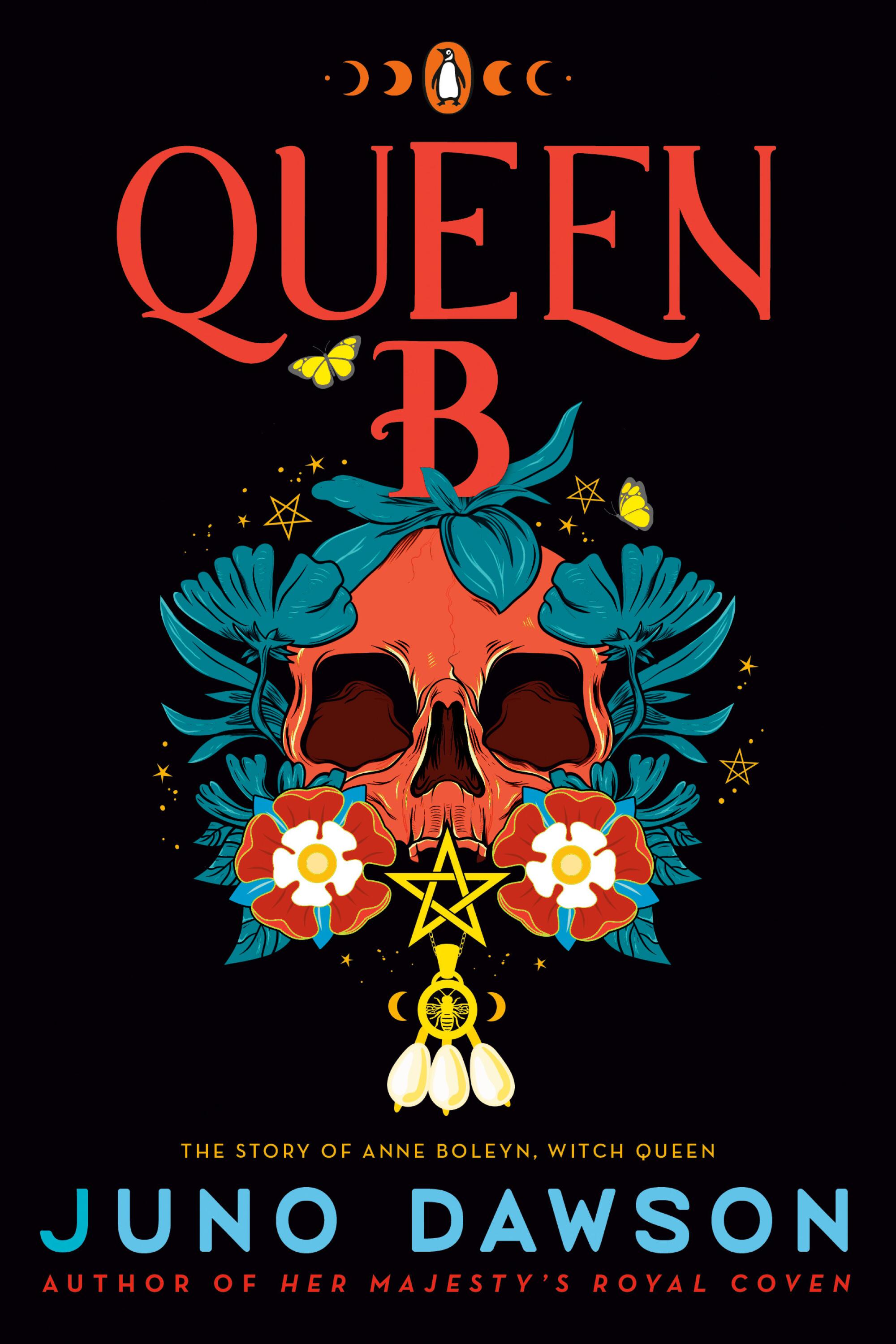
Queen B: The Story of Anne Boleyn, Witch Queen By Juno Dawson Penguin: 224 pages, $18 (July 23)
Dawson is the queen of young adult fiction in the U.K., and her nonfiction works have explored LGBTQ+ issues. Set in the court of Henry VIII, “Queen B” follows Lady Grace Fairfax as she seeks the traitors who betrayed Anne Boleyn. When witchfinders are sent to root out members of the condemned queen’s coven, court intrigue follows. Juno summons a tale that is the perfect length for a sultry weekend read.
The Modern Fairies By Clare Pollard Avid Reader: 272 pages, $28 (July 23)
Those in search of a bawdy fairy tale should look no further than Pollard’s novel set during the reign of Louis XIV. Intellectuals from Versailles gather at the home of Madame Marie D’Aulnoy. They bring court gossip and romantic desire with them, and they entertain each other with ribald tales of missing glass slippers, beauties and beasts, while remaining oblivious to the wolf that waits outside their salon door. Pollard imagines the origins of many of the tales gathered by Charles Perrault.
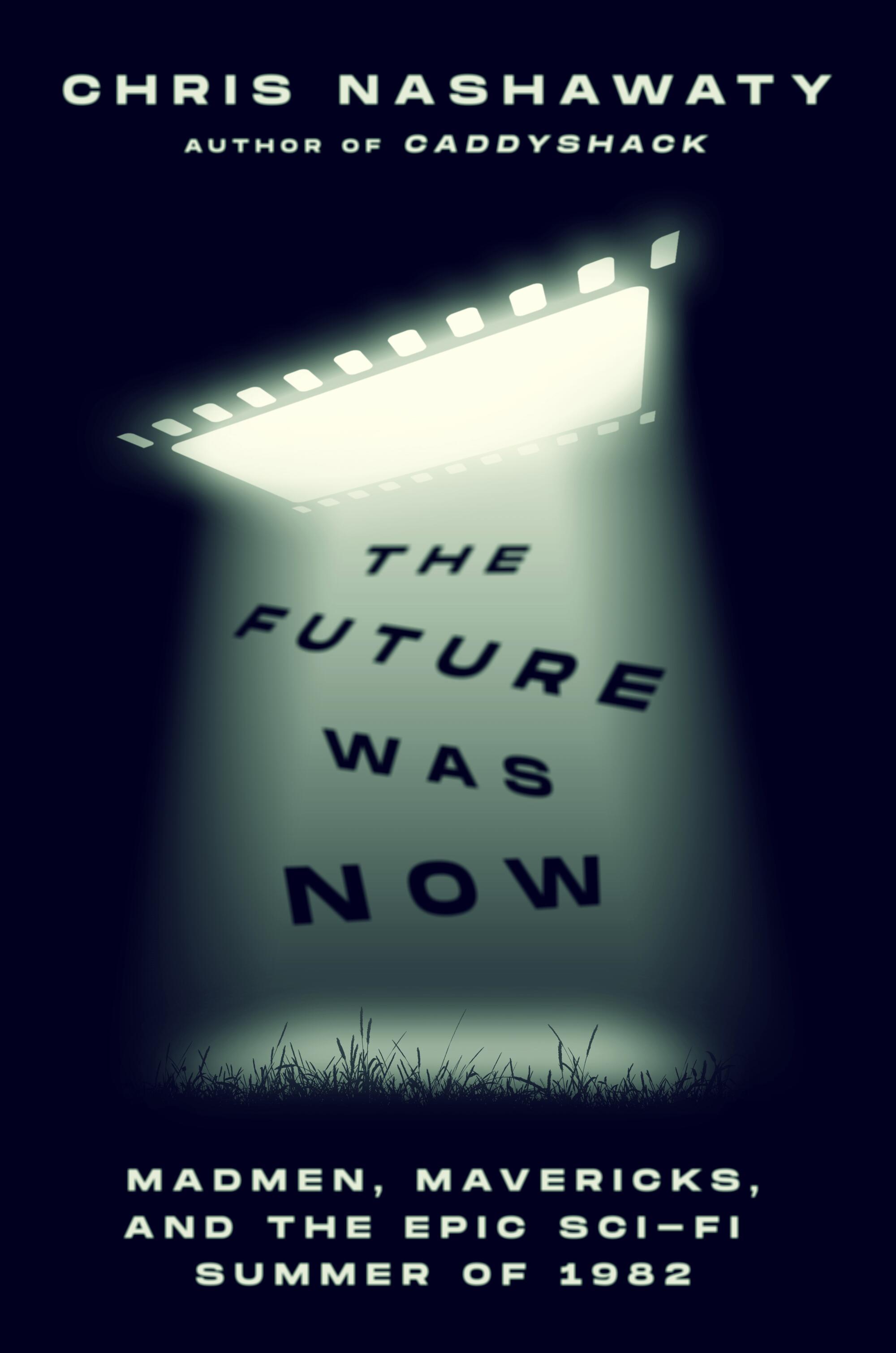
The Future Was Now: Madmen, Mavericks, and the Epic Sci-Fi Summer of 1982 By Chris Nashawaty Flatiron: 304 pages, $30 (July 30)
The summer of 1982 took moviegoers on epic rides through the sci-fi worlds of a future L.A. and the Australian desert, and introduced a lost extraterrestrial trying to get home. In all, eight sci-fi adventures were released that summer, and Nashawaty, former Entertainment Weekly film critic, expertly covers their behind-the-scenes conflicts and (not surprising) ego clashes. Hollywood boldly went where it hadn’t gone before and Nashawaty chronicles the journeys.

Mystery Lights By Lena Valencia Tin House: 256, $18 (Aug. 6)
Kelly Link has praised the “gorgeous” “Mystery Lights.” It’s the debut short story collection by former L.A. resident Valencia. Among the collection’s delicious bonbons are stories about an anxious screenwriter trapped in an SUV; 20 women who need a retreat from the business retreat they’re on; and an obsessed artist who longs to capture an otherworldly light. In the umbra of these darkly tinged stories, readers will experience late-night fears and the sweet relief of daylight.
More to Read

The week’s bestselling books, May 19
May 15, 2024
The week’s bestselling books, May 12
May 8, 2024
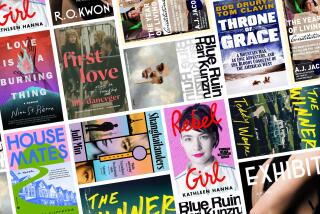
10 books to add to your reading list in May
May 1, 2024
Sign up for our Book Club newsletter
Get the latest news, events and more from the Los Angeles Times Book Club, and help us get L.A. reading and talking.
You may occasionally receive promotional content from the Los Angeles Times.
More From the Los Angeles Times

Opinion: 30 years ago, Grace Paley foresaw today’s clash over antisemitism

The week’s bestselling books, May 26

Paul Scheer was abused as a child. His new memoir helped him reclaim ‘the power of my voice for my childhood’
May 21, 2024

The other Angelenos: What a naturalist’s survey of Los Angeles wildlife reveals
May 20, 2024
Intuitive Eating

What Is It?
Intuitive eating (IE) is not so much a diet plan as an approach to eating based on one’s internal needs, whether physical, emotional, or other influencers. When these needs are recognized, they may determine one’s food choices. Because the method is based on an individual’s needs at one moment in time, it does not focus on specific foods, a calorie level to reach, or even eating at certain times. It has been used as an approach to lose weight as well as a treatment strategy for those with disordered eating patterns. The term “intuitive eating” was introduced in 1995 as the title of a book authored by registered dietitians Evelyn Tribole and Elyse Resch. However, the concept of eating from an emotional response was described by researchers prior to that date. [1]
How It Works
IE is the antithesis of restrained eating that demands rigid control. Many commercial diets follow a restrained eating model, with meal plans that include specific foods and/or measured portions. In contrast, IE focuses on body cues such as hunger and fullness, which may be physical hunger and fullness from an empty or filled stomach, or cues caused by emotional or external triggers. IE is flexible, with no restrictions on types of foods to eat, amounts, or specific mealtimes.
IE is sometimes described as this basic concept: learning to eat when hungry and stopping when full. Yet, in our society physical hunger is not the only reason we eat. Our appetites and cravings are continuously stimulated by visual cues (cooking shows, food advertisements), emotional cues (feeling sad, lonely, stressed, bored), olfactory cues (smelling freshly baked bread), or social cues (Sunday family dinners, sharing a restaurant meal with friends). IE seeks to identify the specific cause of the “hunger,” and to respond with awareness and intention. Eating in response to triggers other than from physiological cues may cause a feeling of lack of self-control, guilt, or self-condemnation. Practicing IE concepts may help to prevent these negative feelings. Intuitive eating encourages self-care and a positive body image.
Weight loss is not a focus of IE. However, eating excess calories can occur from emotional cues, so if one learns to respond appropriately to emotional eating cues, weight loss may follow naturally.
Signs of physical hunger:
- Fatigue, lightheadedness
- Irritability
- Stomach is grumbling
- Hunger gradually intensifies
- No specific cravings; any type of food will satisfy
Signs of emotional hunger:
- Stomach is quiet
- Desire for food occurs suddenly (e.g., because of an emotion such as anger or stress, or from external cues such as viewing a television commercial or other food advertising)
- Cravings are for a specific food or flavor, whether salty, sweet, crunchy, creamy, etc.
- Guilt is associated with eating
Examples of intuitive eating strategies:
- Acknowledge hunger . Recognize physical hunger cues and respond to them. These cues will not always occur at consistent times, as true hunger can be influenced by changes in physical activity, lack of sleep, etc. Therefore, eating meals and snacks at the same time every day may not be appropriate according to IE principles, if you are not hungry.
- Recognize and respond to fullness. As you identify true hunger, you will also learn to identify a comfortable degree of fullness after eating, and respond by stopping eating. This may require periodic check-ins while eating, noting if you are enjoying the food and reaching a point of having enough.
- Don’t fear negative feelings. Accept that negative emotions like stress, anger, and boredom will come and go. Learn to cope with these feelings without using food: talk to a friend, go for a walk, take a shower, pray, or meditate.
- Honor and respect your body regardless of size and ability. A negative self-image can lead to self-destructive behaviors, whereas nurturing a positive self-image may lead to healthful behaviors.
How is intuitive eating different from mindful eating?
- Considering the wider spectrum of the meal which informs what and how much one eats: where the food came from, what elements were needed from nature that enabled the food to grow and thrive, the individuals involved in getting the food from the farm to grocery stores or restaurants, how the food was prepared, who prepared it.
- Noticing how the food looks, tastes, smells, and feels in our bodies as we eat.
- How the body feels after eating the meal.
- Expressing gratitude for the meal before and/or after eating
- May use deep breathing or meditation before the meal to transition your busy mind to focus on the meal in front of you.
- How our food choices affect our local and global environment.
Including these considerations when eating can help to increase appreciation, enjoyment, and understanding of the food.
Intuitive eating often integrates concepts of mindful eating but also considers eating specifically in response to hunger and satiety cues, nurturing a positive body image, addressing non-physiological reasons for hunger, and physical activity. It usually does not involve meditation nor gratitude.
The Research So Far
There is a growing body of research on IE. Small, short-term controlled trials or cross-sectional studies using IE concepts have consistently shown benefits for psychological wellbeing (e.g., reduced depression and anxiety; increased body satisfaction, self-acceptance, and quality of life). [3,4] IE interventions have also shown a decrease in certain behaviors such as binge eating and restrained eating/dieting. A limited number of studies have shown improvements in blood pressure and cholesterol. [5] Randomized trials show conflicting results of IE interventions and weight loss or decreased body mass index; some show no weight changes while others show modest weight reductions.
- A cross-sectional study of 5,238 Swiss men and women were evaluated with self-administered questionnaires assessing intuitive eating behaviors and diet quality. [3] The study found that scoring higher with “unconditional permission to eat” was associated with poorer diet quality (increased sugar sweetened beverages, salty snacks, sweets, meat, and fried foods; lower intake of fruits, vegetables, and whole grains).
- Another cross-sectional study of 41,536 men and women found that scoring higher with “unconditional permission to eat” or no food rules/restrictions was associated with more unhealthful food choices and a higher total calorie intake. High scorers tended to eat less fruits, vegetables, and whole grains, while eating more fast food and sweetened and fatty foods. [6] Those who scored higher on “physical rather than emotional reasons to eat” had a lower calorie intake and ate less sweet and fatty foods.
- Reductions in weight and BMI occurred in the weight loss group but not the weight neutral group. However, the weight neutral group showed greater reductions in LDL cholesterol. Both groups showed an increase in healthy lifestyle behaviors (increased physical activity and fruit/vegetable intake), improved quality of life and self-esteem, and decreased total and LDL cholesterol, all of which were maintained at the 2-year follow-up.
- A meta-analysis of 10 randomized controlled trials looked at conventional weight loss programs (via calorie restriction) versus mindful/intuitive eating strategies for weight loss. It found that mindful/intuitive eating strategies were effective for weight loss compared with no intervention, but there was no difference in weight reduction compared with conventional weight loss programs. [8]
- A literature review of 68 publications looked at the role of mindful eating and intuitive eating in changing eating behaviors. The number of studies specific to intuitive eating was limited but found that it had positive associations with identifying hunger cues, increased freedom to eat, greater pleasure associated with food, and greater awareness of how their bodies were feeling. [9]
Potential Pitfalls
- May not cause weight loss. The IE model is not intended to cause weight loss, but to promote a positive self-image and healthy lifestyle changes. People who are seeking a plan that causes weight loss may not prefer this approach, because there are no specific amounts or types of foods recommended and body weight is not measured. However, a decrease in behaviors like restrained eating and emotional eating may naturally lead to weight loss for some. If a person has been advised to lose weight by their physician to improve medical conditions (e.g., prediabetes, high blood pressure, fatty liver), an IE approach may be used in conjunction with a weight-reducing eating plan. Guidance on this type of plan from a registered dietitian or licensed health coach can help to encourage a healthy body image and realistic lifestyle goals.
- Fear of weight gain. A concern with individuals is letting go of diet rules and “forbidden” foods. They may fear a lack of control around these foods that are now permitted without restrictions. In certain cases, less boundaries may lead some people to overeat or choose low-nutrient-dense foods (e.g., processed high-sugar beverages or foods). Consulting with a registered dietitian who is experienced with IE concepts can help one to identify the body’s signals on what and how much to eat, ideally choosing foods and amounts that support their wellbeing and health.
- May not improve health outcomes related to weight gain or chronic disease. IE concepts encourage self-care and a positive response to food, which may or may not cause a change towards healthful eating patterns (consuming more fruits and vegetables, less sweetened beverages and foods, less fried foods, not skipping meals, etc.). An individual has the freedom to choose fast food and soda if desired, so IE will not necessarily lead to a disease-preventive eating pattern or to a reversal of weight gain.
- Does not address the concept of food addiction from “hyper-palatable” foods, which can lead to food cravings . Cravings for food may stem from a neurobiological source that is neither caused by physical or emotional hunger. The notion of a food addiction is controversial, but research shows that the brain can activate reward regions of the brain in response to flavors like fat, salt, and sugar when they are eaten in excess and on a regular basis. [10-14] Researchers have compared this effect to that of addictive drugs like cocaine and alcohol. These foods tend to be highly processed, calorie-dense, and low in nutrients. People may develop strong cravings for these foods because of the reward-related neural changes that occur after consumption (a calming or pleasurable feeling with the release of dopamine). In this case, relying on intuition about what to eat may backfire if one has developed an “addiction” to these types of foods.
Unanswered Questions
- Can IE concepts prevent the onset or progression of chronic diseases including obesity by promoting healthier lifestyle behaviors?
- Are there certain types of people in which the IE approach would work best (e.g., chronic dieters, those experiencing disordered eating)?
Bottom Line
Intuitive eating is an alternative approach that was developed in response to the negative mental and physical health effects caused by traditional diets for weight loss, which involve the deliberate long-term restriction of food. IE allows internal cues to guide one’s eating choices and patterns rather than a meal plan or designated rules.
Research has shown that IE can lead to greater psychological wellbeing, increased pleasure when eating, and body satisfaction. However research also shows that permission to eat all foods with no “food rules” can sometimes lead to unhealthful food choices with more high-calorie palatable foods. Therefore a certain level of restraint and nutrition knowledge may be beneficial when starting an IE plan (if the desired result is to improve overall health and wellness). Still, in the long run, continued dietary restraint increases the risk of ignoring natural physiological signals to eat. Therefore a combination of IE practices with basic nutrition knowledge may lead to more positive outcomes than either approach alone.
It may also be beneficial to use IE strategies to heighten one’s awareness of internal cues of not just feeling “full” versus “hungry” but to also note how the body feels after eating healthful foods of fruits and vegetables versus highly processed high-calorie snack foods, which may lead to eating patterns that promote wellbeing. [3]
- Healthy Weight
- The Best Diet: Quality Counts
- Diet Reviews
- Gast J, Hawks SR. Weight loss education: the challenge of a new paradigm. Health education & behavior . 1998 Aug;25(4):464-73.
- Fung TT, Long MW, Hung P, Cheung LW. An expanded model for mindful eating for health promotion and sustainability: issues and challenges for dietetics practice. Journal of the Academy of Nutrition and Dietetics . 2016;116(7):1081-6.
- Horwath C, Hagmann D, Hartmann C. Intuitive eating and food intake in men and women: Results from the Swiss food panel study. Appetite . 2019 Apr 1;135:61-71.
- Bruce LJ, Ricciardelli LA. A systematic review of the psychosocial correlates of intuitive eating among adult women. Appetite . 2016 Jan 1;96:454-72.
- Van Dyke N, Drinkwater EJ. Review article relationships between intuitive eating and health indicators: literature review. Public health nutrition . 2014 Aug;17(8):1757-66.
- Camilleri GM, Méjean C, Bellisle F, Andreeva VA, Kesse-Guyot E, Hercberg S, Péneau S. Intuitive eating dimensions were differently associated with food intake in the general population–based NutriNet-Santé study. The Journal of nutrition . 2017 Jan 1;147(1):61-9.
- Mensinger JL, Calogero RM, Stranges S, Tylka TL. A weight-neutral versus weight-loss approach for health promotion in women with high BMI: A randomized-controlled trial. Appetite . 2016 Oct 1;105:364-74.
- Fuentes Artiles R, Staub K, Aldakak L, Eppenberger P, Rühli F, Bender N. Mindful eating and common diet programs lower body weight similarly: Systematic review and meta‐analysis. Obesity reviews . 2019 Nov;20(11):1619-27.
- Warren JM, Smith N, Ashwell M. A structured literature review on the role of mindfulness, mindful eating and intuitive eating in changing eating behaviours: effectiveness and associated potential mechanisms. Nutrition research reviews . 2017 Dec;30(2):272-83.
- N Gearhardt A, Davis C, Kuschner R, D Brownell K. The addiction potential of hyperpalatable foods. Current drug abuse reviews . 2011 Sep 1;4(3):140-5.
- Leigh SJ, Morris MJ. The role of reward circuitry and food addiction in the obesity epidemic: An update. Biological psychology . 2018 Jan 1;131:31-42.
- Hebebrand J, Albayrak Ö, Adan R, Antel J, Dieguez C, De Jong J, Leng G, Menzies J, Mercer JG, Murphy M, Van Der Plasse G. “Eating addiction”, rather than “food addiction”, better captures addictive-like eating behavior. Neuroscience & Biobehavioral Reviews . 2014 Nov 1;47:295-306.
- Schulte EM, Avena NM, Gearhardt AN. Which foods may be addictive? The roles of processing, fat content, and glycemic load. PloS one . 2015 Feb 18;10(2):e0117959.
- Lennerz BS, Alsop DC, Holsen LM, Stern E, Rojas R, Ebbeling CB, Goldstein JM, Ludwig DS. Effects of dietary glycemic index on brain regions related to reward and craving in men. The American journal of clinical nutrition . 2013 Sep 1;98(3):641-7.
Last reviewed November 2023
Terms of Use
The contents of this website are for educational purposes and are not intended to offer personal medical advice. You should seek the advice of your physician or other qualified health provider with any questions you may have regarding a medical condition. Never disregard professional medical advice or delay in seeking it because of something you have read on this website. The Nutrition Source does not recommend or endorse any products.

IMAGES
VIDEO
COMMENTS
The real value of crafting a well-written book review for a student does not lie in their ability to impact book sales. Understanding how to produce a well-written book review helps students to: Engage critically with a text. Critically evaluate a text. Respond personally to a range of different writing genres.
The first step is to plan and create an outline that includes all the points that you will have to cover in the review. Don't forget to include all the information about the characters, plot information, and some other parts of the chosen book. The three parts of a book review are: 1. Provide a Summary.
It is a fantasy, but the book draws inspiration from the Second Sino-Japanese War and the Rape of Nanking. Crime Fiction Lover reviews Jessica Barry's Freefall, a crime novel: In some crime novels, the wrongdoing hits you between the eyes from page one. With others it's a more subtle process, and that's OK too.
Step 1: Planning Your Book Review - The Art of Getting Started. You've decided to take the plunge and share your thoughts on a book that has captivated (or perhaps disappointed) you. Before you start book reviewing, let's take a step back and plan your approach.
Book Review Example 2 - Comment in Group. This is one that will teach you how to write a book review in a short, concise manner that will answer someone's question in a Facebook group, or even just in a text to friends. Here, someone even suggested I write book reviews because they liked the way it was said.
A review is a critical evaluation of a text, event, object, or phenomenon. Reviews can consider books, articles, entire genres or fields of literature, architecture, art, fashion, restaurants, policies, exhibitions, performances, and many other forms. This handout will focus on book reviews.
Here are six steps for how to write a book review for school and beyond. 1. Begin with a brief summary of the book. This is probably the best way to introduce any review because it gives context. But make sure to not go into too much detail. Keep it short and sweet since an official summary can be found through a quick google search!
Blog - Posted on Thursday, Nov 11 The Only Book Review Templates You'll Ever Need Whether you're trying to become a book reviewer, writing a book report for school, or analyzing a book, it's nice to follow a book review template to make sure that your thoughts are clearly presented.. A quality template provides guidance to keep your mind sharp and your thoughts organized so that you can ...
Review by Young Mensan Connor C., age 6, Boston Mensa. Journey To Juno is the second book of the Galaxy Zack series. It is just as good as the first one. It's awesome! Zack joins the Sprockets Academy Explorers Club at school. They fly on a special trip to Juno, a new planet no one has ever visited.
All reviews begin with bibliographic information: the author's name, the book's full title, place of publication, publisher, edition, date, pagination, and cost, if known. In no more than two paragraphs, introduce the book. Give your initial appraisal of the work, including your key observation on the text.
1. Start with a couple of sentences describing what the book is about. But without giving any spoilers or revealing plot twists! As a general rule, try to avoid writing in detail about anything that happens from about the middle of the book onwards. If the book is part of a series, it can be useful to mention this, and whether you think you'd ...
Be sure to mention the authors of the title and what experience or expertise they bring to the title. Check Stefan Kløvning's review of Creativity Cycling for an example of a summary that establishes the framework of the book within the context of its field. Step 2. Present your evaluation.
analysis, while a book review is meant for other scholars/academics to read and decide if they should buy the book. It is not a research paper, so it does not have a hypothesis. An academic book review is also not the type of book review you might find in a K-12 school setting (often referred to as a "book report"). There are some ...
How to write a book review. Note down the key points- This is an important step before writing a book review. Jot down your analysis about the characters, themes, plot, and your personal view. Also, note down the book title, author's name, and any relevant information about the book. Start with a strong introduction- Mention the author's ...
A book review is a thorough description, critical analysis, and/or evaluation of the quality, meaning, and significance of a book, often written in relation to prior research on the topic. Reviews generally range from 500-2000 words, but may be longer or shorter depends on several factors: the length and complexity of the book being reviewed ...
Book Review Template. Here is a good book review example for 4th-grade students: "Charlotte's Web" by E.B. White — A Heartwarming Tale of Friendship. "Charlotte's Web" by E.B. White is a heartwarming tale of friendship that takes us to Zuckerman's farm, where a special pig named Wilbur forms an unlikely bond with Charlotte, a clever ...
A general guideline is that the longer the book, the longer the review, and a review shouldn't be fewer than 100 words or so. For a long book, the review may be 500 words or even more. If a review is too short, the review may not be able to fulfill its purpose. Too long, and the review may stray into too much plot summary or lose the reader's ...
At the beginning of the school year, do a read aloud and have students each do a book review on the same book that was read to the class. Have select students share their book reviews and/or thoughts on a book. Follow up by having a class discussion about why all of the book reviews are not alike, even though they were done on the same book.
Step 1: Planning. Create an essay outline which includes all of the main points you wish to summarise in your book analysis. Include information about the characters, details of the plot, and some other important parts of your chosen novel. Reserve a body paragraph for each point you wish to talk about.
Reviews, essays, best sellers and children's books coverage from The New York Times Book Review.
The complicated, generous life of Paul Auster, who died on April 30, yielded a body of work of staggering scope and variety. Each week, top authors and critics join the Book Review's podcast to ...
May 16, 2024. This week's recommended books include two memoirs by writers recalling their parents: "The Whole Staggering Mystery," by Sylvia Brownrigg, digs into her father's secret ...
Understand the assignment: Clarify your text's purpose, requirements, and audience. Specify if it's for a casual blog, academic assignment, or a professional publication. Read the book: Begin by thoroughly reading the publication. Take notes on key plot points, characters, themes, and your initial reactions. Step 2.
Book review: School-choice expert demonstrates power of parents in school wars | Opinion. Cynthia M. Allen. Wed, May 22, 2024, 6:27 AM EDT · 5 min read. I would be lying if I said that Corey ...
Happy Reading! Blossom and Bud, a story written by Frank J. Sielo and illustrated by Brittany E. Lakin, is a beautiful children's book that promotes self-love, builds a positive self-image, and shows kindness to all, no matter how different we may seem. In this book, we meet two unique and wonderful characters who feel undeserving simply ...
Twelve stories makes up the book, with one of the longest (90 pages), "Rattlesnakes," reintroducing readers to Vic Trenton, who King fans will remember as the father of Tad, the boy killed by ...
Good for the entire family, and a must-have for middle school libraries.-Christina Paolozzi Sami's Special Gift: An Eid al-Adha Story by M.O Yuksel. illus. by Hüseyin Sönmezay. Charlesbridge. ISBN 9781623542962. PreS-Gr 2-A gift to all readers! Sami's special day starts with a gift from his late grandfather, mosque for prayers and a ...
The Future Was Now: Madmen, Mavericks, and the Epic Sci-Fi Summer of 1982. By Chris Nashawaty. Flatiron: 304 pages, $30. (July 30) The summer of 1982 took moviegoers on epic rides through the sci ...
PHILLIPSBURG, NJ - Phillipsburg High School announces the Top 10 Graduates for the Class of 2024. Out of a class of 488 students, the top 10 graduates were reco. ... Beth's Book Review.
Intuitive eating is an alternative approach that was developed in response to the negative mental and physical health effects caused by traditional diets for weight loss, which involve the deliberate long-term restriction of food. IE allows internal cues to guide one's eating choices and patterns rather than a meal plan or designated rules.